




















































































OneStream Inc. in downtown Birmingham, which developed a custom finance management platform that combines finance and operational data with AI, spent a decade meticulously preparing for what became a $490-million IPO in July.












Designed by world-renowned SHoP Architects and spanning more than 1.5 million square feet across two distinct buildings, Hudson’s Detroit is a global destination in downtown Detroit. The landmark property features Class A office space, including the future world headquarters of General Motors, The Detroit EDITION hotel and The Residences at The Detroit EDITION, a retail collection, unique bar and restaurant concepts, an event venue spanning two floors and activated public spaces. Make your mark at Hudson’s.






On December 8, 1924 Detroit’s Book brothers changed the landscape of Washington Boulevard, dubbed the “Fifth Avenue of the Midwest”, with the opening of the Book Cadillac Hotel, the tallest hotel in the world with 33 floors and 1136 guestrooms. Designed by famed architect Louis Kamper in classic Italian Renaissance style, the hotel quickly became Detroit’s best address. Fast forward to today, the landmark Westin Book Cadillac Detroit stands tall, fresh from a $23 million makeover, poised to celebrate 100 years of legendary hospitality. Experience the legacy of Detroit’s best address.


























No matter what your industry, from healthcare to oil and gas, public sector and expertise to ensure their success.
We offer commercial payments and investment banking as well as employer from our industry experts. For business executives and owners, we are truly your full-service bank
Smile at life. Help your employees enjoy life’s important moments—in and out of the office with affordable, comprehensive dental and vision coverage from a name they know and trust.

















































































UNLOCK VIP STATUS


Open-air Courtside Suites with dedicated in-game service and access to the exclusive sold-out Players Club, BetRivers Backcourt Club, and CURE Insurance Courtside Club.
Founded



U.S.

Discover engaging business content from a variety of industries and topics at this bi-monthly event. Topics include Scaling Minority-Owned Businesses, Powered By Women, Commercial Real Estate Awards, Top Corporate Culture Awards, and the Michigan Economic Forecast.
Scan the QR Code to attend a DBusiness Breakfast Series!




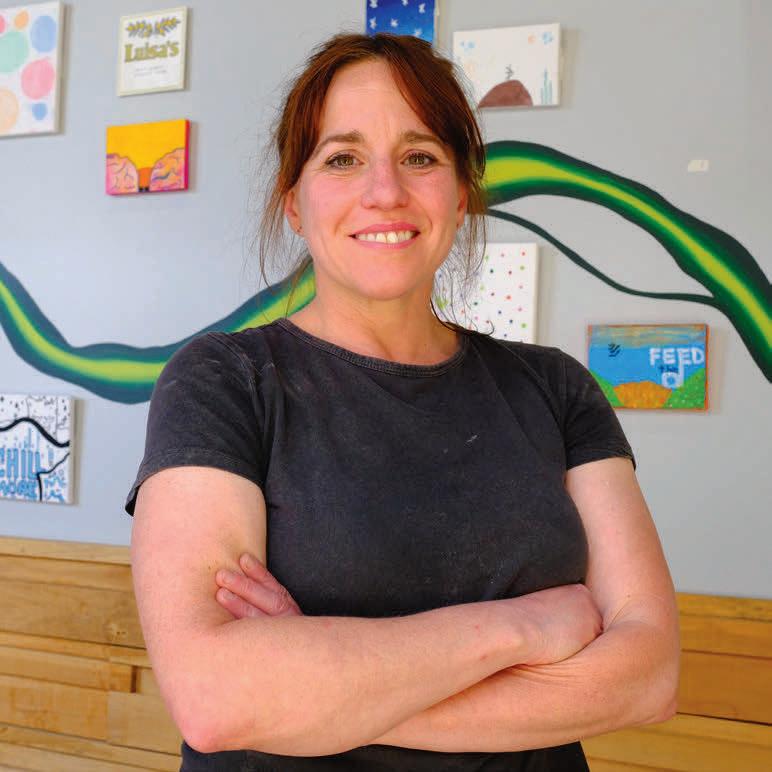


























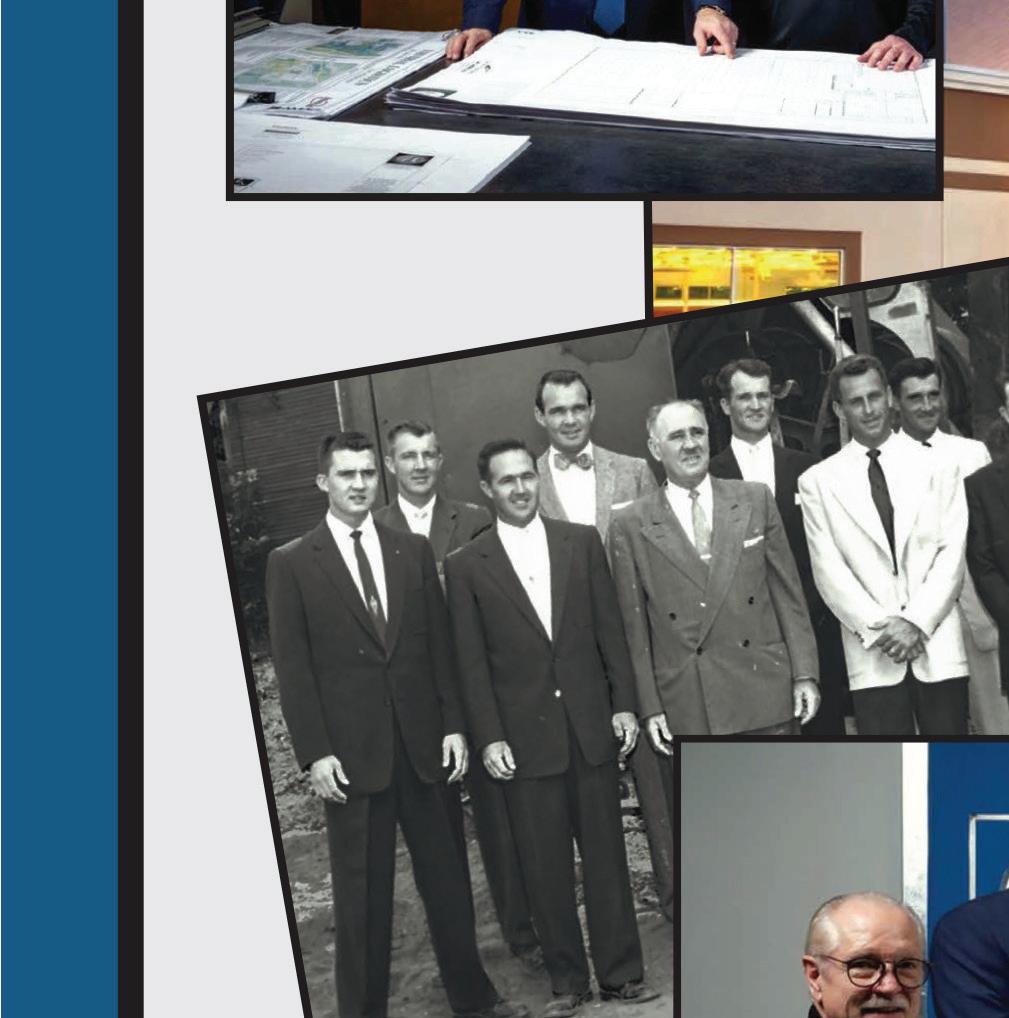

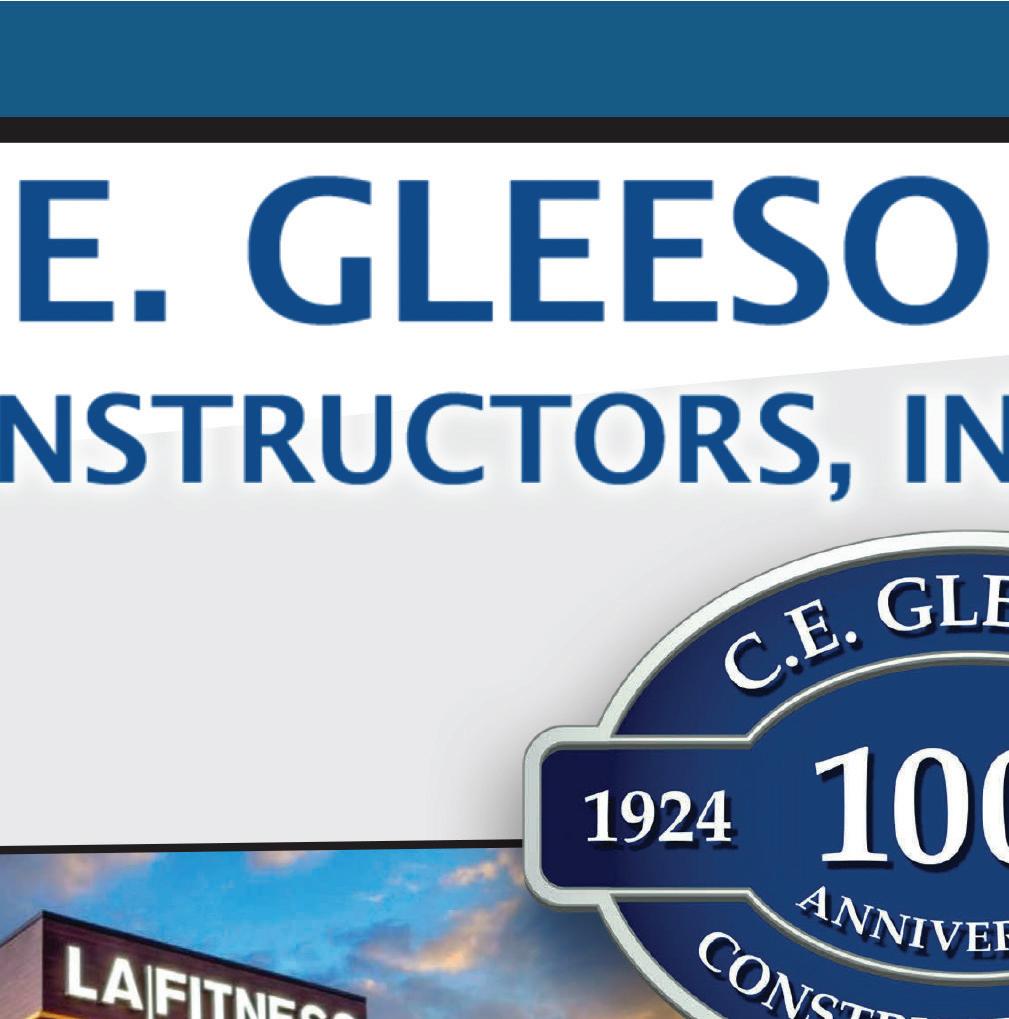





22
27 BLUE BELT
Hospitals and medical centers, in concert with nutritionists and scientists, can improve patient outcomes and advance wellness goals by establishing metro Detroit as the gold standard for health care.
27 TAILPIPE DREAM
As sales of electric vehicles slow due to the lack of a national charging network, range anxiety, high costs, and other factors, the so-called Biden EPA rule, or the Environmental Protection Agency’s vehicle emissions mandate released in March, needs to be lowered.
27 NUCLEAR EQUATION
Rather than wait years for government officials to approve new power plants, energy providers are looking to restart closed nuclear complexes and extend the life of existing facilities.
30 COMPENDIUM
How outsiders view Detroit.
33 MEDICAL PEDIGREE
Three doctors from the Kado extended family of physicians have opened their own clinic in Bloomfield Township. By R.J. King
34 A BETTER WAY
RIVET Work in Detroit lands new funding to expand its workforce management software for contractors. By Dan Calabrese
34 THE VICTORS
The University of Michigan in Ann Arbor reports it continues to be the largest and most sought-after public research institution in the state, with record total enrollment this fall of 52,855 students. By R.J. King
36 TITANIUM RIDE
Custom bicycles from Quiring Cycles in west Michigan take the trail less traveled. By Seth Schwartz
36 PDA Q&A
Kellie Lindsay, director of strategic partnerships, Autotech Ventures, Menlo Park, Calif. By R.J. King

38 REMOTE RX
Independent medical centers in the region are finding new patients who prefer easier access over a hospital setting. By Dan Calabrese
38 PET CARE
Owners of pets in Michigan are paying 14 percent more for health care for their four-legged family members than they were a year ago, according to a new study by Miami-based Spot Pet Insurance. By Tim Keenan
91 CEO GIFT GUIDE
Surprise chief executives who think they have everything with a Gulfstream G700, a membership in the Detroit Tigers’ new Home Plate Club, a 2025 Cadillac Escalade IQ, or a luxurious Great Lakes Cruise. By R.J. King and Stephanie Daniel
94 RETURN ON INVESTMENT
Ahead of Time: Serial entrepreneur Steven Wang, who grew up in Troy, left high school following his sophomore year to launch a stream of digital enterprises. By Tom Murray
98 PRODUCTION RUN
Budding Business: Over a 35-year period, DBG Flowers in Madison Heights has created an end-to-end floral supply chain stretching from Central America to the United States.
By R.J. King
100 PATENTS AND INVENTIONS
Pill Form: A rural doctor from west Michigan, William Erastus Upjohn, developed the world’s first easy-to-digest pill and set the foundation for a pharmaceutical powerhouse. By Norm Sinclair
102 OPINION
Launch Pad: Building a business from scratch isn’t easy, but the right team — guided by a support system of a sponsor, a
mentor, and a coach — can be the difference between success and failure. By Ja’von Glenn
104 THE CIRCUIT
Our party pics from exclusive events.
109 FROM THE TOP
Metro Detroit’s Top Private Clubs, the Largest Hospital Systems in Michigan, and the Largest Multitenant Office Buildings in Metro Detroit.
114 CLOSING BELL
Face of Time: For decades, a clock with three faces and 3-foot-long wooden hands outside Kern’s Department Store served as a downtown meeting point. By Ronald Ahrens
ON THE COVER
Photo courtesy of OneStream

Life’s adventure is more than the destination. It’s how you journey.






Dstormwater runo pump stations.
Curious enough, those 500 coalition supporters clearly outnumbered the people who participated in MDOT’s Environmental Assessment hearings; a public notice was announced on Jan. 5, 2021, during Whitmer’s second COVID-19 shutdown.









Avenue, why did the Michi-










hearings for the Environ-
uring the process of nalizing redesign plans for the I-375 corridor, a one-mile stretch of aging freeway that connects I-75 and Je erson Avenue, why did the Michigan Department of Transportation, along with the Federal Highway Administration, schedule public hearings for the Environmental Assessment of proposed changes to the corridor during Gov. Gretchen Whitmer’s second COVID-19 lockdown? e redesign comes against the backdrop of I-375’s original construction, when MDOT tore through and destroyed two historic Black neighborhoods east of downtown Detroit — Black Bottom and Paradise Valley — to complete the freeway.
MDOT, naturally, has sought to paint the latest plans as a win for the community.
Against that backdrop, a grass roots group, the Rethink I-375 Community Coalition, which is now more than 500 strong, came to life,
In the coalition’s own words: “ e I-375 project is an example of ‘social justice washing’ and that’s an insult in Detroit. Doubly so, because the Black Bottom community that used to reside here was destroyed by careless freeway planning in the 1950s, and the current plans will repeat and exacerbate those mistakes.”
At the start, MDOT didn’t consider another alternative: building a new underground corridor like the Big Dig in downtown Boston. at project’s greatest feature was opening up acres of land at grade level for the community.
With a similar plan, Detroit could truly begin to honor the past and restore what at one time was one of the jazz meccas of the world.
MDOT maintains its planned, at-grade boulevard will be slower and safer. It also will be cheaper to maintain; there are 15 aging bridges and two
ree weeks later, on Jan. 27, a virtual public hearing drew 169 viewers (including MDOT ocials). An in-person meeting followed on Feb. 18, and attracted 22 people. When the public comment period ceased on Feb. 19, fewer than 200 people had participated.
For a neighboring community with thousands of residents, businesses, churches, and nonpro t organizations, that’s not much feedback.
On March 7, less than three weeks after the public comment period terminated, the Federal Highway Administration granted the project a Finding of No Signi cant Impact.
Seven months later, on Oct. 13, U.S. Secretary of Transportation Pete Buttigieg announced Michigan and Detroit developed the I-375 project “ with such rich and thorough community input that we were able to avoid layers of review that might otherwise have been necessary and get through NEPA (standards) more quickly.”
In July, Wayne County Executive Warren Evans, who grew up in Detroit, painted a picture that MDOT should likely reassess the entire project.
MDOT “is struggling to push the narrative the new design will help heal the racial wounds of the past with intentional inclusivity that will provide all sorts of bene ts to Black people. is time, the narrative goes, the new and improved I-375 is being designed with ‘us’ in mind.
“Please. Are you serious? Show me the evidence, and I mean speci cs. Show me the clear and itemized bene ts that this project will provide to the Black community, and exactly how it will repair and compensate for the unprecedented damage that was done all those years ago. Don’t paint a pretty picture, just give me the facts.”
He’s right. Detroit’s Black community deserves much better.
I just read the Eastern Michigan University story in the September-October 2024 issue of DBusiness You covered a lot of ground and captured the significance of all we’re doing. It’s truly an excellent piece. Kudos to you and your professionalism. We enjoy working with you.
Walter Kraft Ypsilanti
POWERED BY WOMEN
I wanted to write and thank you for the great story and beautiful portraits of Washtenaw Community College President Rose B. Bellanca. The whole Powered By Women spread (July-August 2024 DBusiness), including how you put together the group image, was impressive, and all the women honored are inspiring.
Fran LeFort Ann Arbor
NAMC OPENS IN ANN ARBOR
Thanks for the fantastic article in the July 19, 2024, DBusiness Daily News on the National Advanced Military Consortium headquarters opening in Ann Arbor. It’s exciting to see our state further diversifying into defense and aerospace.
Kim Bode Grand Rapids

Business leaders say they trust the attorneys of Plunkett Cooney to anticipate legal pitfalls, to resolve high-stakes litigation and to craft contracts they can sign... with confidence. See your business differently. Get the Plunkett Cooney perspective. n Appellate Law n Banking, Bankruptcy & Creditors’ Rights n Business Transactions n Cannabis Law n Commercial Litigation n Estate Planning & Business Succession n Foodservice & Hospitality Law n Government Relations & Public Policy n Health Care Law n Labor & Employment Law n Mergers & Acquisitions n Nonprofit Law n Real Estate Law n Tax Law n Zoning, Planning & Permitting

Dan Calabrese has been reporting on business in Michigan since 1992. He started at the Grand Rapids Business Journal and became a frequent contributor to DBusiness in 2009. He has written for a variety of trade magazines, including Transport Topics, Pet Age, ICF Builder, and several others. He also has authored four novels: “Powers and Principalities,” “Pharmakeia,” “Dark Matter,” and “Backstop.” Calabrese lives in Royal Oak with his wife, Angie, and their son, Tony. In this issue, the graduate of Western Michigan University writes about Detroit-based RIVET Work in Detroit, as well as Michigan Orthopaedic Surgeons in Southfield.
Michael Strong has spent more than 25 years writing about businesses of all types, with a focus on the automotive industry. A Detroit-area native, he’s written about everything from local car shows to the restaurant and food industry and breaking financial news. Currently he writes for a variety of publications and has written for Kelley Blue Book, Autotrader, TheDetroitBureau.com, Crain’s Detroit Business, the Detroit Free Press, The Detroit News, and many more national, regional, and local publications. A graduate of Georgia Southern University, Strong is a contributor to DBusiness’ 2024 Commercial Real Estate Awards feature.

CONTRIBUTING WRITERS
Ronald Ahrens, Dale Buss, Dan Calabrese,

Clare Nicholas is a freelance illustrator and educator with more than 30 years of industry experience, working mainly within the publishing sector. She’s based in the U.K., where she teaches graphic design at Loughborough University. Currently, Nicholas is working on a personal project, “Inside Out,” which embraces a broad approach to subject matter and celebrates the beauty of nature, along with exploring autobiographical themes and ideas through oil painting. In this issue, she provides the illustrations for the 2025 Top Lawyers list.
COORDINATOR Amanda Kozlowski
ACCOUNT MANAGER Elizabeth Kowalik
DIGITAL DIRECTOR OF DIGITAL STRATEGY Travis Fletcher
DIGITAL DEVELOPMENT MANAGER Matt Cappo
SR. DIGITAL DEVELOPMENT SPECIALIST Luanne Lim
DIGITAL DEVELOPMENT SPECIALIST Connor McDonald
DIGITAL STRATEGY INTERN Isabella Amadori IT IT DIRECTOR Jeremy Leland
CIRCULATION
CIRCULATION MANAGER Riley Meyers
CIRCULATION COORDINATORS David Benvenuto, Cathy Krajenke, Rachel Moulden, Michele Wold
MARKETING AND EVENTS
MARKETING AND EVENTS MANAGER Lyndsay Zelena
COMMUNICATIONS AND PR Regan Wright
WEDDINGS ACCOUNT MANAGER Karen Wilkie
MARKET RESEARCH
MARKETING RESEARCH DIRECTOR Sofia Shevin
MARKETING RESEARCH COORDINATORS Alyssa Fueri, Kristin Mingo
MARKETING RESEARCH SALES COORDINATOR Alex Thompson
MARKETING RESEARCH SALES ASSISTANT Theresa Lowery
GRAPHIC DESIGNER Kendra Okamoto
BUSINESS
CEO Stefan Wanczyk
PRESIDENT John Balardo
DIRECTOR OF BUSINESS OPERATIONS Kathie Gorecki
SENIOR ACCOUNTING ASSOCIATE Andrew Kotzian
ACCOUNTING ASSOCIATES Dian Mauro, Austin Schmelzle
DISTRIBUTION Target Distribution, Troy







































— DR. CHARLES H. MAYO, CO-FOUNDER, MAYO CLINIC
209.6
Age-adjusted death rate from heart disease per 100,000 people in Michigan
Hospitals and medical centers, in concert with nutritionists and scientists, can improve patient outcomes and advance wellness goals by establishing metro Detroit as exemplifying the gold standard for health care.
The pinnacle of longevity is what’s known as a blue zone — a place with a population that is among the healthiest and longest-living. From an initial 1999 study by the U.S. Department of Health and Human Services, and two subsequent reports in collaboration with author Dan Buettner, five blue zones were identified: Sardinia, Italy; Okinawa, Japan; Nicoya, Costa Rica; Icaria, Greece; and Loma Linda, Calif.
Scientists literally marked the regions in the world with the highest concentrations of centenarians by drawing a circle using a blue magic marker; hence, blue zones. Beyond healthy diets consisting of locally sourced fruits, vegetables, and proteins, life expectancy rates in blue zones are higher due to rich social relationships, low stress, daily physical activity, and minimal diseases.
Overall, estimates show people living in such regions live a decade or more longer compared to average world life expectancy. What’s more, with the exception of Loma Linda, there are few, if any, fast food restaurants or processed food and drink offerings in the wellness zones. So how can metro Detroit become a healthier place to live, work, and play? It starts with setting high standards in the health care sector. One avenue to share best practices and better coordinate services in the region is the creation of a health care consortium.
The coalition would include health care executives, medical practitioners, longevity experts, dieticians, local residents, educational leaders, urban planners, architects, and developers.
The goal? Convert traditional hospital settings into health care villages where doctors, nurses, and specialists provide a valued-based system. Arguably the only example of a health care village in metro Detroit is Henry Ford West Bloomfield Hospital, along W. Maple Road, west of Drake Road.
AS SALES OF ELECTRIC VEHICLES slow due to the lack of a national charging network, range anxiety, high costs, and other factors, the so-called Biden EPA rule, or the Environmental Protection Agency’s vehicle emissions mandate released in March, needs to be lowered. By 2033, according to the EPA’s greenhouse gas emissions requirements for automakers, gas-powered vehicles should make up no more than 30 percent of overall annual vehicle sales. Meeting the EV mandate won’t be easy. Last year, EVs made up 7.6 percent of overall sales in the U.S., and the percentage is sure to drop this year.
More broadly, to meet the Biden EPA rule, car, truck, and SUV manufacturers will need to increase their EV sales by fifteenfold over the next eight years. The ruling is especially punitive for General Motors, Ford, and Stellantis, given they sell many more SUVs and trucks than passenger cars.
Consider, in the second quarter, Ford reported it lost $44,000 on each EV it built and sold. Other traditional automakers report similar deficits on their electric-powered models. Such losses are unsustainable. Short of reducing or eliminating the mandate, the thousands of jobs supported by the sale of gas-powered vehicles will disappear in quick order.
Age-adjusted death rate from heart disease per 100,000 people in the U.S.
Opened in 2009, the campus offers 191 single-patient rooms, an expansive atrium, cooking classes, yoga sessions, walking trails, and the nation’s first hospital-based organic greenhouse. The resulting fruits, vegetables, herbs, and spices are served daily to patients or in the hospital’s main restaurant, called Henry’s.
In addition, an enclosed Main Street offers the LiveWell Shoppe, which features earth-friendly products like bath and beauty products geared to enhancing the body, mind, and spirit. It’s joined by LiveWell Market, where an array of healthy food options are sourced from the greenhouse. The fare is paired with baked goods, dairy products, and natural snacks.
The nation’s first dedicated health care project designed around a hospital is Metro Health Village near Grand Rapids, which opened in 2007 and is now University of Michigan Health — West. The 170-acre campus includes a 208-room hospital, a Verified Level II Trauma Center, multiple support services, a hotel, a senior living facility, shops, restaurants, a conference and education center, a YMCA, a Veterans Affairs clinic, and much more.
By all accounts, all new and renovated medical campuses in metro Detroit (and Michigan), including a $3-billion expansion of Henry Ford Hospital in Detroit that’s now underway, should embrace the attributes of a health care village. Going forward, the template of health care should go well beyond the traditional mission of treating the sick to offering a value-based system of keeping residents healthy for their entire lives.
TO MEET DEMAND FOR MORE data centers required for the growing use of artificial intelligence and cloud computing, Constellation Energy will reopen the Three Mile Island nuclear power plant (Unit 1 reactor) in Pennsylvania in 2028. The move comes as Constellation in September signed a massive power purchase agreement with Microsoft.
Rather than wait years for government officials to approve new power plants, energy providers are looking to restart closed nuclear complexes and extend the life of existing facilities. Given other green sources of energy like wind farms and solar arrays are limited by weather conditions, nuclear energy provides continuous, uninterrupted power.
In Michigan, federal, state, and local officials are seeking to reopen the Palisades nuclear power plant located in Covert, north of Benton Harbor. It closed in 2022. DTE Energy, meanwhile, may seek to extend the lifespan of the Fermi 2 nuclear facility in Monroe, which is expected to be shut down in 2045.
Driving such decisions is a recent report from Goldman Sachs that data centers will make up 8 percent of U.S. demand for electricity by 2030, up from 3 percent in 2022. While nuclear energy fell out of favor following major accidents at Three Mile Island, Chernobyl, and Fukushima, new technology and safety standards are driving growth in the nuclear energy sector.



One of the fastest-growing healthcare professions in the country, nurses play a critical role in helping patients who are in need, forming in-person connections, and providing compassionate hands-on care.
With our flexible programs, expert faculty, and generous scholarship opportunities, we’re dedicated to helping you achieve your career ambitions so you can start helping others.



THE ATHLETIC SEPT. 16, 2024 BY
BRIAN HAMILTON
The details of Justin Ishbia’s baseball career, according to Justin Ishbia, are too inconsequential to mention. Feel free to scour newspaper clippings about Birmingham (Mich.) Seaholm High’s exploits in the 1990s if you’re interested.
But Ishbia, the billionaire founder of a private equity firm and part owner of three professional sports franchises, made 45 straight Opening Days for the Detroit Tigers with his father. The two of them recently finished a tour of every major-league stadium, complete with what Ishbia calls a “nerdy ranking system” of seats, hot dogs and more.
Baseball, the sport, has been as consequential as it gets for him.
“The beauty of baseball is that it’s not about a star or two,” Ishbia told The Athletic on Sept. 16. “It’s truly a team sport, and it’s a team sport over a long period of time. It’s a grind and it’s a discipline. It’s life. Life is the discipline of doing the same thing over and over again consistently. And that’s what the long summer of baseball is all about.”
And that philosophy has precipitated a $10 million
donation to Michigan State athletics in the name of Ishbia and his wife, Kristen, both of whom earned undergraduate degrees in East Lansing. A sizable chunk — $1.5 million — is specifically aimed at refurbishing and upgrading the school’s baseball stadium, Ishbia said, and the field itself will be renamed in honor of Ishbia’s father, Jeff.
The bulk of the gift, though, is $7 million directed to Michigan State’s Men’s Basketball Excellence Fund, according to Ishbia. Which leaves Spartans coach Tom Izzo to “direct it wherever he thinks makes the most sense.”
“There’s no better steward than Tom Izzo,” Ishbia said. …
BUSINESS INSIDER SEPT. 28, 2024 BY JOHN TOWFIGHI
Moving to Detroit helped David Valdez achieve his lifelong dream.
Valdez, 35, moved from San Francisco in 2018, where he worked as a barista and bartender.
“Moving here has been really good to me,” Valdez said. “I’ve been able to do things here that were just dreams or impossible if I stayed in the Bay.”
barista job in the morning, I had a couple of hours to myself, and then I would go to my next job at a bar or a restaurant,” Valdez said. “I couldn’t do that for another five years.” …
NEWS • SEPT. 24, 2024 • BY JEN
JUDSON
Saab will open a munitions production facility in Grayling, Mich., the company announced in September.
The new facility will create at least 70 jobs, the company statement notes. There is potential to hire even more employees as the facility gets up and running, according to Smith.
Valdez moved to Detroit for better job opportunities and to be with his partner, Juna Durrant, who is from Michigan. In San Francisco, Valdez said he worked two jobs and lived with roommates just to get by. However, in Detroit, he has been able to buy a home and open his own coffee shop. What’s more, he and Durrant have a six-year-old son and are expecting another baby in November.
Before the pandemic, many Americans like Valdez had been ditching expensive coastal hubs in favor of smaller cities that offer more affordable living costs. That trend ballooned when COVID-19 hit and is still seeing momentum: In 2022, 817,669 people left California, according to the most recently available census data. In 2018, that number was 691,145.
Additionally, 1,852 people moved into Detroit between July 2022 and July 2023, bringing the city’s population to 633,218, according to the U.S. Census Bureau. That was the first year-over-year increase in the city’s population since 1957. Moving a dream to Detroit
Valdez said he loved San Francisco but found it unsustainable to work long-term in the city’s leisure and hospitality industry.
He often worked around the clock to earn as much as possible.
“I was done with my
The Swedish company, which plans to break ground by the end of the year, said it will use the facility for final assembly and integration of shoulder-fired munitions and precision fire systems.
Manufacturing work will begin in early 2026, according to a company statement.
“We are making a long-term commitment not only to the U.S. defense industrial base, but to the local community as well,” Erik Smith, president and CEO of Saab in the U.S., said. “Saab plays a positive role in the communities where we live and work, creating jobs and investing in the local community, and we look forward to joining the Grayling community.”
The Michigan site, chosen from six possible locations, presented the “most efficient way to execute the work that we have to get done,” Smith told Defense News.
The 388-acre plot is located near the largest Army National Guard training base in the country, and the region also has an experienced workforce needed for the type of production.
Smith first told Defense News of Saab’s plans to grow its footprint in the U.S. with a new facility focused on manufacturing ground combat weapons and missile systems in March. He noted six states were in the running.
The new site is part of a global manufacturing push by the company to quadruple its global capacity to produce its ground combat weapons, he said.
“As this facility ramps up, what you will see is a combination of products that Saab is very well known for and some new products that really haven’t hit the market yet.”

The site size “allows for expansion for when we need it,” Smith said. “I do envision engineering capacity there, as well, as the business evolves,” he added, but noted, “right now we are pretty laser-focused on manufacturing capacity.”
The facility will feature advanced manufacturing capability and an innovation center to enhance munitions production capacity stateside, according to Smith. He also said it will support the production of components for the Ground-Launched Small Diameter Bomb, or GLSDB, system and close-combat weapons.
Saab joins a wide variety of defense manufacturers in Michigan, a state with a long legacy of weapons production.
“We built the arsenal of democracy to win WWII and will keep rolling up our sleeves to protect our national defense,”
Michigan Governor Gretchen Whitmer said in the company statement.
“We are building on our economic momentum and strong reputation as a leader in advanced manufacturing.”
Saab will now have 10 facilities operating in the U.S. Other locations include West Lafayette, Ind., for aerospace advanced manufacturing; Syracuse, N.Y., for radar and sensor systems; and Cranston, R.I., and Quincy, Mass., for autonomous and undersea systems.
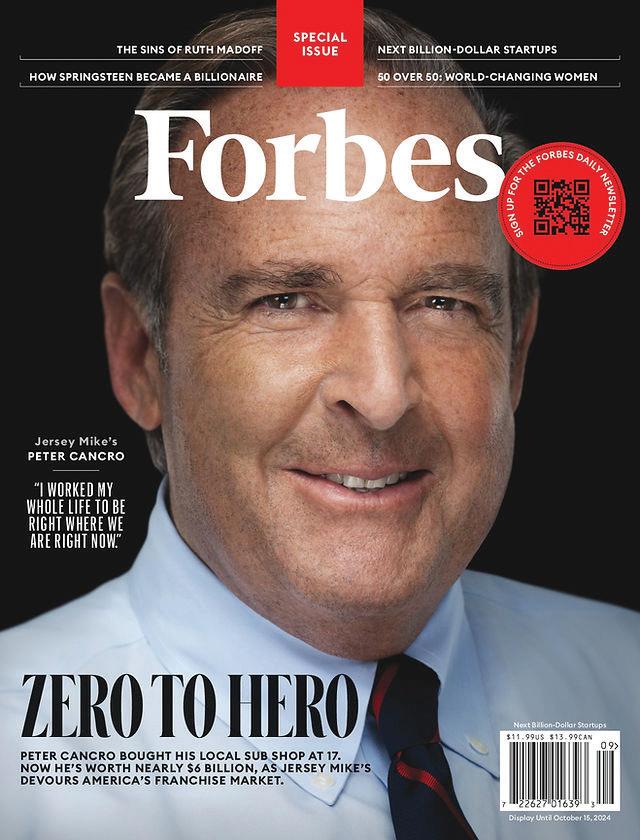
‘BRIDGERTON’ FANS PAID HUNDREDS TO ATTEND A REGENCY-ERA BALL BASED
FORBES • SEPT. 25, 2024 • BY MARY WHITFILL ROELOFFS
Fans of the Netflix show “Bridgerton” say they were scammed out of hundreds of dollars over the weekend after they paid to attend what was billed as a Regency-era ball in Detroit based on the show, only to face a last-minute rescheduling and a bare-bones event that’s drawing comparisons to the viral “Willy Wonka Experience” earlier this year.
The “Detroit Bridgerton-Themed Ball” event promised to be an “evening of sophistication, grace, and historical charm” featuring a costume contest that would award the best-dressed attendee a $2,000 cash prize, classical music, a theatrical show and the naming of a “Diamond of the Season,” as happens in the Netflix original series.
None of that came to be, attendees said, and instead fans of the show said they paid hundreds of dollars for tickets for a “scam” event that was pushed back at the last minute (it was rescheduled days before its original date of Aug. 25 to Sunday, Sept. 22) and featured none of the promised elements.
Regency-era entertainment was replaced by a singular exotic dancer, who performed to the music of a lone violin player on a pole at the center of the dance floor, according to testimony and photos from attendees, and dinner reportedly “ran out after an hour, and some was raw.”
Photos and videos from the event show fans dressed to the nines and standing around a bare-bones room at the historic Harmonie Club in Detroit, with decor described as “Temu decorations” and centerpieces on dinner tables without flower arrangements inside.
The organizer of the event, Uncle N Me LLC, said in a statement to 7 News Detroit that it understands “that not everyone had the experience they hoped for at our most recent event” and is “working diligently to address all concerns.”
The “Bridgerton” ball in Detroit was not affiliated with Netflix.…
THE NEW YORK TIMES SEPT. 30, 2024 BY BRAD
PLUMER
The Energy Department said Sept. 30 that it had finalized a $1.52 billion loan guarantee to help a company restart a shuttered nuclear plant in Michigan — the latest sign of rising government support for nuclear power.
Two rural electricity providers that planned to buy power from the reactor would also receive $1.3 billion in federal grants under a program approved by Congress to help rural communities tackle climate change.
The moves will help Holtec International reopen the Palisades nuclear plant in Covert Township, Mich., which ceased operating in 2022.
The company plans to inspect and refurbish the plant’s reactor and seek regulatory approval to restart the plant by October 2025.
After years of stagnation, America’s nuclear industry is seeing a resurgence of interest.
Both Congress and the Biden administration have offered billions of dollars in subsidies to prevent older nuclear plants from closing and to build new reactors. Despite concerns about high costs and hazardous waste, nuclear plants can generate electricity at all hours without emitting the greenhouse gases that are heating the planet.
David Turk, the deputy secretary of energy, said he expected U.S. electricity demand would grow by 15 percent over the next few years, driven
by an increase in electric vehicles, a boom in battery and solar factories, as well as a surge of new data centers for artificial intelligence. That meant the nation needs new low-carbon sources of power that could run 24/7 and complement wind and solar plants.
“It’s been incredible to see nuclear power become part of that conversation in a way that just wasn’t happening before,” Mr. Turk said.
Holtec acquired the Palisades nuclear plant in 2022, with plans to dismantle it, but later campaigned to reopen the plant with the backing of Gov. Gretchen Whitmer of Michigan, a Democrat. No company has ever revived a U.S. reactor that was seemingly closed for good. That could soon change.
In Pennsylvania, Constellation Energy Corporation recently announced that it planned to restart the dormant Three Mile Island nuclear plant by 2027, after striking a deal to sell electricity to Microsoft, which needs power for its fast-growing fleet of data centers. Three Mile Island was the site of the worst nuclear accident in U.S. history when one of the plant’s two reactors partly melted down in 1979. The other, undamaged reactor closed five years ago for economic reasons.
It’s not easy to reopen a nuclear plant that has been mothballed for years. Workers have to check for corrosion and decay and replace old turbines and other parts. A restart needs approval from the Nuclear Regulatory Commission, which oversees reactor safety.
Holtec has already faced hurdles: Earlier this
month, federal regulators said a “large number of steam generator tubes” at Palisades required further inspection and potential repair. Patrick O’Brien, a spokesman for Holtec, said the company expected complications to arise and still aimed to reopen the plant next year. …
BY CALEB MILLER
In the coming months Stellantis is set to launch a variety of new electric vehicles, from the 2025 Ram 1500 REV pickup truck to the 2024 Dodge Charger Daytona muscle car and the 2024 Jeep Wagoneer S luxury SUV. Now the automotive conglomerate has announced that it will be investing more than $406 million in three Michigan factories to assemble its incoming electric lineup.
The Sterling Heights Assembly Plant will become Stellantis’s first U.S. facility to build an EV when it starts churning out the 2025 Ram 1500 REV before the end of the year. The REV will be built at the plant alongside the 2025 Ram 1500 Ramcharger — which uses a gas engine as a range extender for its electric powertrain — and the traditional internal-combustion Ram 1500. All three versions of the 1500 will be built on the same production line, and Stellantis says the investment in the Sterling Heights factory amounts to $235.5 million.
Stellantis will also dump roughly $97.6 million into the Warren Truck Assembly Plant, which the company says will build a future electrified version of the Jeep Wagoneer. The automaker didn’t specify exactly what this model will look like but said it will be one of four Jeep EVs coming worldwide by the end of 2025 and that it will be built on the same line as the gas-powered versions of the Grand Wagoneer and Wagoneer. The upcoming 2024 Wagoneer S, however, will be built in Toluca, Mexico.
Lastly, the Dundee Engine Plant is set to receive an influx of more than $73 million. It will be retooled to put together and test battery trays for the STLA Frame platform. That architecture will underpin the 1500 REV, and production will start at Dundee this year. …














Three doctors from the Kado extended family of physicians have opened their own clinic in Bloomfield Township.
BY R.J. KING

COLLAGEN CARE
Is there a doctor in the house? Yes, if you’re a member of the Kado family. Consider eight of the nine siblings are doctors.
What’s more, when the extended family is included, there are a total of 15 doctors, which makes for intriguing family gatherings. It’s a safe bet a number of their children will go on to become physicians, as well.
Apart from making their parents proud and getting second or third opinions at family gatherings, the sharing of information and experiences between sisters, brothers, and spouses led, in part, to the opening of the Kado Clinic in Bloomfield Township in 2021.
Cited as the only multispecialty clinic in the United States for dermatology, allergy and immunology, rheumatology, and aesthetic services under one roof, the clinic was founded by two of the Kado sisters — Drs. Rachel and Jessica, and their sister-in-law, Ruba — based on a shared frustration over fragmented care in today’s health system
“After COVID-19 hit, we began helping out at hospitals any way we could, and that’s when Jessica, Ruba, and myself thought, Wouldn’t it be cool if the three of us could work together at our own clinic?” says Rachel, an allergist/immunologist and pediatrician. “Success, for us, is patient health and referrals from other doctors.”
The clinic, located along Telegraph Road south of Square Lake Road, offers a range of services, including a metabolic cellular aging assessment, skin cancer prevention and removal, hair restoration, chemical peels, laser facials, and more.
“In a hospital setting, it could take up to two years to see a specialist,” says Ruba, a rheumatologist and clinical physician researcher. “At our clinic, patients can literally go from one room to another and see the three of us over two days, rather than spending months waiting to see a specialist.”
Apart from direct patient care, Jessica, a dermatologist, developed a series of proprietary creams for the face and body, as well as CB2++, a repair cream that treats sore muscles, tendons, and joints. It can be used for arthritis, tendonitis, and muscle strain.
The three creams utilize multiple natural ingredients including clove, lavender, rosemary, and lemon, along with safflower, avocado, sweet almond, and flower oils. The CB2++ Repair Cream is used by professional and Olympic athletes, according to the clinic.
Complemented by biostimulating devices and state-of-the-art technology, the Kado Clinic’s treatments are non-invasive and can be used on all skin shades and types. In as little time as a lunch break, the Kado team “can bio-hack” a new patient’s skin and “turn back the chronological clock on aging, with zero downtime for recovery.”
Rachel, who has struggled with eczema and skin allergies, says treating all skin types is unique in the health field. “We help people get off of medications, or keep them from going on medications,” she says. “It’s extremely beneficial to our patients that we are true family doctors who can share information quickly.”
Saint John’s Resort Ranked No. 5 by Condé Nast Traveler
Saint John’s Resort in Plymouth Township has been ranked the No. 5 U.S. Resort in the Midwest by the readers of Condé Nast Traveler magazine, following the completion of the first phase of an extensive, multimillion-dollar renovation..
Macomb Group Expands to Southeast U.S. with Acquisition
Macomb Group Inc. in Sterling Heights has acquired North Carolina-based Leonhardt Pipe & Supply Inc., which operates in North and South Carolina and Georgia. It is Macomb Group’s third acquisition since May.
Southfield’s Taft Law Merges with Denver Firm
The law firm Taft in Southfield is expanding into the Mountain West region by combining with the 125-attorney Sherman & Howard in Denver. Once the merger is effective in January, Taft will have more than 1,000 attorneys nationwide.
Eastern Market Launches
$15.5M Fundraising Campaign
Eastern Market in Detroit has launched the “Authentic Eastern Market” campaign, a $15.5 million fundraising initiative designed to strengthen the regional food economy, maintain the district’s character, and enhance its infrastructure.
Alerje and Mitsubishi Partner to Advance Allergy Care
Detroit-based Alerje Inc., which specializes in emergency medicine and food allergy management, and Mitsubishi Gas Chemical Co. are partnering to create a comprehensive, personalized allergy care solution.
THE UNIVERSITY OF MICHIGAN in Ann Arbor reports it continues to be the largest and most sought-after public research institution in the state, with record total enrollment this fall of 52,855 students.
U-M’s most recent total enrollment increased 1.5 percent from 2023, with undergraduate enrollment up 2 percent, from 33,730 undergraduate students last year to 34,454 students this year.
The incoming class decreased slightly, to 8,858 students from 8,880 in 2023, although there was a 2 percent increase in the number of students from within the state of Michigan.
“U-M is recognized around the world for the exceptional educational value provided on campus, and our fall 2024 enrollment record continues to demonstrate that,” says Adele C. Brumfield, vice provost for enrollment management at the university. “Students from diverse backgrounds and experiences find a vibrant campus community at U-M in which they can learn and grow.”
Overall Ph.D. student enrollment rose 1.5 percent this fall, to 5,825 from 5,742 last year. That said, the university saw a small decline in the number of incoming Ph.D. students, following a 32 percent increase the previous year. Total graduate and professional school enrollment increased slightly, to 18,401 this year from 18,335 in 2023.
—
By R.J. King
Cendrowski Corporate Advisors
Acquired by Chicago Firm
Cendrowski Corporate Advisors, a tax, business valuation, and accounting firm in Bloomfield Hills, has been acquired by Prosperity Partners, a Chicago-headquartered accounting business. Terms of were not disclosed.
RIVET Work in Detroit lands new funding to expand its workforce management software for contractors.
BY DAN CALABRESE
Arecent $6 million funding infusion will make it possible for Detroit-based RIVET Work Inc., a four-year-old developer of workforce management software for the construction industry, to expand its o erings into the mechanical engineering market.
Ryan Meitl, CEO of RIVET Work, says the company secured the investment in December 2023 from Brick and Mortar Ventures, a San Francisco-based venture capital firm focused on the construction industry. Previous investment rounds have been funded by Michigan entities Augment Ventures, Detroit Venture Partners, Michigan Rise, and Red Cedar Ventures.
In total, the company has raised $14 million in investor funding since it launched in 2020.
Meitl, an electrical engineer by trade, started the company after he observed that contractors who often partnered with him on projects were using antiquated workforce management processes, which often consisted of little more than a whiteboard or an Excel spreadsheet.
“Today there are a lot less whiteboards, except on job sites, but it’s a lot more spreadsheets,” Meitl says. “ at still leaves a lot of gaps, because spreadsheets don’t communicate automatically, and spreadsheets are hard to collaborate with, especially when you have dozens of people who need to look at and collaborate on a single thing.”
RIVET Work’s software, designed with the construction industry in mind, simplies and automates much of the task of allocating labor on job sites, while making it easier for team members to share information and collaborate.
It also provides information contractors can use to measure labor productivity via multiple metrics such as units installed per day, per person.
“Basically (a contractor’s) pro t will be determined by how productive their people actually are,” Meitl says. “ ere are a bunch of macro factors that really impact how productive the people on their projects are. And if you can’t have a good labor plan, and you can’t execute against the labor plan collaboratively in real time, those things will erode margin.”
e new capital infusion will help RIVET Work tweak its software product to provide mechanical engineering rms with the same e ciencies.
Ghostworks Launches Carbon Fiber Vessel for Military Use
Ghostworks in Holland has launched its first M-Ship Co. legacy platform — the M40 — designed for commercial and military applications. The first M40 went from design to completed sea trials in six months, according to the firm.
Humanetics Debuts Modular Driving Robot for Vehicle Testing Humanetics in Farmington Hills has debuted its latest active safety innovation, the DrivingRobot module. The unit was designed to streamline testing across multiple vehicle types including passenger cars, vans, buses, and heavy goods.
To date, the company is working with approximately 130 companies across the United States, and has a goal of doubling or tripling its customer base via investments in new product o erings and added talent to help design, market, and service the software.
e company currently stands at 40 employees and is housed in the Madison building overlooking Grand Circus Park. Meitl says the company is quickly outgrowing its space, and will be looking to nd more room in downtown Detroit in 2025.
Meitl, a native of Peoria, Ill., moved to the Detroit area with his wife, Cassie, in 2011 and quickly saw the potential of the city.
“We bought a house in the city eight years ago and said, we want to be part of it,” Meitl says. “What we saw was going to happen in Detroit was going to be a transformation, a revitalization of the economy, (and) new businesses. I kind of fell into startup stu , and I’m really passionate about growing the ecosystem here.”



RIVET CEO Ryan Meitl addresses the RIVET Work team during a monthly all-hands meeting. Right:RIVET’s new Schedule to Your Forecast feature .













Asahi Kasei America Opens N.A. Headquarters in Novi Asahi Kasei America Inc., the regional headquarters of Asahi Kasei Group for North America, has relocated its corporate o ce from New York to a 14,403-square-foot facility in Novi. The new space will streamline multiple processes.
Plum Market Expands with 10 Locations in Nebraska
Farmington Hills-based Plum Market Travel Services, a subsidiary of natural food retailer Plum Market, won a contract to operate 10 dining, retail, and Gourmet Natural Market locations at Omaha Eppley Airfield in Nebraska.
Custom bicycles from Quiring Cycles in west Michigan take the trail less traveled.
BY SETH SCHWARTZ
During Scott Quiring’s decade as a mountain bike racer, he spent time as an equipment sponsor for the Bell’s Brewery mountain bike team. After making a few frames bikers loved, Quiring realized there might be a market for fabricating bicycle frames.
A year after earning a bachelor’s degree in business from Grand Valley State University in 1999, he enrolled at Grand Rapids Community College and took a class in TIG welding and machinery.
ree years later, Quiring and his girlfriend, Christina Peek, opened Quiring Cycles in Free Soil (south of Manistee). e 4,000-square-foot facility has a front showroom, a space for welding, and an area for custom detail-painting. titanium, steel, and aluminum alloy frames are displayed for the public.
While Quiring works with the products, Peek handles the business side.
“We want to take the customers’ biking experience to the next level,” Quiring says. “We personalize everything and (customers) have the option to choose all the components. People like to see the process, so I’ll produce a drawing and a draft to make sure that’s exactly what they want.”
Quiring Cycles’ tailor-made frames and customer service have inspired a devoted clientele across the Midwest, which accounts for 80 percent of sales. e remaining orders come from around the country. Overall, 50 percent of sales are Fat









KELLIE LINDSAY
Director, Strategic Partnerships
Autotech Ventures
Menlo Park, Calif.

Quiring Cycles in Free Soil, south of Manistee, got its start in 2002. The company o ers custom titanium, stainless, steel, aluminum alloy, and tandem frames.
Bike models; the rest are made up of gravel and road bike frames.
In 2015, Quiring manufactured the Factory FS titanium mountain bike with front and rear suspension. Cyclists going on long rides and 100-mile races appreciate the product, which costs between $10,000 and $12,000. e company sells approximately 10 each year. Overall, Quiring Cycles produces 30 to 50 bikes annually, with prices ranging from $6,000 to $12,000.
A Dexter resident, Jason Aric Jones, 56, has bought ve bikes from Quiring Cycles. For 30 years, Jones has
DB: WHERE ARE YOU?
KL: In Silicon Valley, but I work in metro Detroit. I’ve been traveling quite a bit — France, Germany, and the UK.
DB: WHAT’S GOING ON?
KL: I spend my time consulting and tech scouting for our corporate investors who are focused on mobility innovations. We’re an early-stage venture capital firm, and
we have 40 to 50 large investors. I help build out our networks and relationships with like-minded companies in the overall mobility space.
DB: WHAT DO YOU LOOK FOR?
KL: We look for changes happening in mobility and ground transportation. Our clients are looking at autonomy, mobility, and interconnected
technology, and where it’s going.
DB: ANY NEW TRENDS?
KL: Having traveled heavily in Europe the past couple of years, compared to the U.S. and metro Detroit, people in Europe are more aware of sustainability and the ways they can change their actions for the better.
DB: WHAT ELSE?
KL: I’ve literally watched
been working with the DTE Energy Foundation building trails around Michigan.
“I got my rst bike in 2004,” he says. “Scott is one of the best titanium frame-builders in the country. He’s very detail-oriented, and will work with the customer to design and tweak a frame so it ts like a custom suit.
“I went to his shop and he measured me. He plugs the measurements into the software and sends you the graphics to discuss. You feel it when you ride; it’s super comfortable. O the road or on gravel, the titanium is forgiving and absorbs the impact incredibly well.”
Paris turn into a recycling city, and more people are using bicycles to get around. Another cool thing is in Berlin, where I saw a fleet of taxis that had fuel cell powertrains. A tra c driver I spoke with liked the car, and he liked refueling the car.
DB: HOW ABOUT EVS?
KL: When you’re in Paris, there are lots of
storefronts utilized by EV brands like Tesla (U.S.), BYD (China), and VinFast (Vietnam). Charging stations are more visible, and the infrastructure is growing. But they face challenges like other markets — how quickly can EVs scale up, is the grid su cient to meet demand, and what are the use cases?
— R.J. King









Independent medical centers in the region are finding new patients who prefer easier access over a hospital setting.
BY DAN CALABRESE
It was eight years ago when a collection of Beaumont Hospital’s sta orthopedic surgeons, who today have ve independent health care centers in metro Detroit, decided they could do more good as a united consortium.
By January 2017, the group had taken form as Michigan Orthopaedic Surgeons in South eld. Since then, the overall practice has become a preferred destination that o ers much easier access than a hospital.
Part of the thinking was that the consortium would o er a wider variety of specialties in the area of musculoskeletal care, so one surgeon within the practice could more easily consult with another who had a different focus — or refer a patient to a colleague if it made more sense.
Speci c specialties include sports medicine, trauma, back/neck/spine, elbow, hip, shoulder, hand, foot and ankle, and knee. MOS practitioners also include those who focus on pediatrics, regenerative medicine, physical rehabilitation, and nutrition counseling. More than 4,000 joint replacements are performed in a typical year.
MOS’s growth has demonstrated the viability of the vision. e group’s newest surgery center, MiOrtho Surgery at 12 Mile and Inkster roads in Franklin, opened in late 2022 and has already doubled in size, necessitating the addition of two new operating rooms.
“Patients and employers want more sites that are convenient to patients and people who work every day,” says Julie Greene, CEO of Michigan Orthopaedic Surgeons. “We’re a community-based organization, so we’ve tried to create locations that are easy for a wide

variety of people in a large market to get to.”
MOS takes advantage of the fact it can perform outpatient surgery for a much lower cost than hospitals, typically saving patients 39 percent on average. In turn, patients often have access to lower insurance deductibles compared to a hospital procedure.
As MOS has grown in terms of facilities, it also has been aggressive about hiring a talented team of physicians across multiple disciplines.
“We have the luxury of seeing very bright young physicians who are well-educated,” Greene says. “We’ve hired some of those physicians, and you have to create space for them to be able to grow. at mirrors our desire to be more convenient for patients.”
Outpatient surgery facilities have proven to be an appealing alternative for patients who don’t need the full range of medical care a hospital would provide.
“ e surgery center o ers a very convenient place, and it’s all about taking care of people who need surgeries,” Greene says. “ ey don’t necessarily have an ongoing disease management or more acute issue, for which they would need to go to the hospital.”
As MOS has sought to hire top-rate talent, Greene says many have been attracted to the practice’s culture, facilities, and work environment.
“Our doctors and nurses are going to be able to take care of their patients in an expedited manner,” Greene says. “We have MRI services. We have X-ray services. We have multiple sites. We have relationships with physical therapists and occupational therapists. And we’re a growth-oriented organization.
“We want employers to have a relationship with MOS so they can have access to (quick and) convenient care for their employees.”
OWNERS OF PETS IN Michigan are paying 14 percent more for health care for their four-legged family members than they were a year ago, according to a study by Miami-based Spot Pet Insurance.
The study compared pet health care costs from July 2023 to July 2024. Overall, pet owners in Maine saw the largest increase, at 21 percent.
Some states, including Michigan, have seen an uptick in pet-related conditions like allergies, chronic illnesses, or injuries requiring expensive treatments, according to the study.
“The 14 percent rise in Michigan’s pet health care costs is just one example of how expenses can quickly escalate,” says Trey Ferro, CEO of Spot Pet Insurance. “As veterinary services become more advanced and specialized, pet health care is only expected to get more expensive.”
Spot Pet Insurance suggests several strategies to help manage costs without compromising on quality pet care. These include: Routine care and preventive measures, start an emergency fund, compare veterinary clinics, explore veterinary discounts and payment plans to help manage costs, and consider pet health insurance.
“Pet insurance helps pet parents across the country navigate these changes with peace of mind, ensuring pets receive the care they need without the added financial stress,” Ferro says.
— By Tim Keenan
More and more patients are seeking medical procedues at specialized centers like Michigan Orthopaedic Surgeons in Southfield. The company operates multiple facilities in metro Detroit.

As the only National Cancer Institute (NCI)-designated comprehensive cancer center in metro Detroit, we give you access to more than 250 promising new treatments found only at Karmanos. We give you your best chance forward. FOR POSSIBILITIES THAT ONCE SEEMED UNREACHABLE. CANCER IS A BEGINNING.

The DBusinessCommercial Real Estate Awards, now in its second year, honors 21 people, companies, and projects that are transforming metro Detroit. From dozens of reader nominations, we chose three finalists for each category, with a focus on developers, brokers, architects, and real estate professionals. From there, we selected a final winner for work approved, commenced, or completed over the past 12 months. Join us for the DBusinessBreakfast Series, where we will announce the winners, on Nov. 1, from 8:30 a.m. to 10:30 a.m., at the Westin Book Cadillac Hotel in Detroit. For tickets, email Regan Wright at rwright@hour-media.com.
Finalists
Tracy Brown, Friedman
Real Estate
Alison Orlans, eTitle
Kevin Johnson, DEGC

Kevin Johnson
President and CEO
DEGC, Detroit
In more than six years as president and CEO of the Detroit Economic Growth Corp., Kevin Johnson has put flash and swagger into the promotion of Detroit while developing a refined pitch that applies to locally owned small businesses as much as the global real estate giants. He boils it down to an analogy about putting out a welcome mat — one that’s made up of certain, necessary levels. In this case, those levels comprise investment in infrastructure, parks and beautification, and the workforce.
“When we get the welcome mat right, and we add in all the layers, all the assets and amenities that the city of Detroit has to offer — we’re one of four cities in America where all four sports teams are in the boundaries of the city — we’re even more unique,” he told the Michigan Chronicle’s digital anchor Andre Ash last year.
Johnson arrived in Detroit in 2018, after a term as senior vice president of Invest Atlanta. He announced bold goals for the creation of jobs and new businesses. His eyes were set on building strategic partnerships in emerging markets such as Central and South America, and Southeast Asia.
Then came the COVID-19 pandemic. During that time, the DEGC oversaw allocation within Wayne County of $8.5 million to small businesses from the Michigan Strategic Fund, and $11 million in grant funds to 1,700 Detroit small businesses.
With the return of stability, Johnson is back to focusing on his targets. His original plan called for three international trips per year, raising awareness about Detroit’s dynamism. As he said during a Detroit Economic Club meeting not long after his arrival, “When I’m out on the road, I don’t talk about Detroit coming back. I talk about our competitive advantages. All the other stuff is just noise.”
— Ronald Ahrens
BY
Andy Gutman, Farbman Group
Sam Munaco, Advocate Commercial Real Estate Advisors
Paul Choukourian, Colliers
Andy Gutman President Farbman Group, Farmington Hills
It was a busy year for Andy Gutman, who, as president of Farbman Group/NAI Farbman in Farmington Hills, helped lead an expansion of the full-service real estate firm into Pennsylvania, Kentucky, and Florida.
Gutman also oversaw the formation of Campusville, a new nationwide, full-service student housing service organization, and Apex Mechanical Solutions, a heating, cooling, and mechanical systems service organization currently serving the Midwest portfolio of the company.
On top of those achievements, Gutman was the broker representative for Oakland County in the phased acquisition of Ottawa I/II Towers, the neighboring Phoenix Center parking deck and amphitheater, and miscellaneous land in downtown Pontiac. Now serving as the owner’s representative, Farbman
Group is assisting Oakland County as it refurbishes office space for the move of up to 600 county employees over the next two years.
In other news, Gutman and his team grew the firm’s receivership business by several million square feet throughout and beyond the Midwest, helping clients reposition challenged assets. Over the past year, in a period of downsizing in the commercial real estate sector, Farbman Group grew its workforce by 15 percent. In a bid to consolidate the company’s various offices and operations in metro Detroit, Farbman Group recently acquired and renovated a 65,000-square-foot office complex in Farmington Hills for its new headquarters. The building was designed by famed architect Minori Yamasaki, who had his studio in Troy.
— R.J. King
BROKER OF THE YEAR
Finalists
Steven Silverman, Friedman Real Estate
Simon Jonna, Jonna Group at Colliers International
Kevin Jappaya, KJ Commercial

Simon Jonna
Founder and Managing Partner
Jonna Group, Birmingham
As a youth, Simon Jonna spent a few halcyon years in San Diego, where his father owned an independent grocery store and the young Simon learned a great deal about attentiveness in marketing. “In 2004, I moved to a town where everyone said there was no potential — Detroit,” Jonna writes in his 2021 autobiography, “Diary of a Dealmaker: The Hurdles and the Hustle.”
In spite of his early opinion, he’s “ended up being one of the defenders of Detroit.” With his brother, Raymond, the pair launched The Jonna Group in 2005 and applied their entrepreneurial spirit to the endeavor. “Today, my ‘store’ sells location, opportunity, and promise,” Jonna says.
Jonna’s ascent to industry leadership was rapid, as he received numerous top-broker awards. He’s also a DBusiness 30 in Their Thirties alumnus. In 2020, The Jonna Group joined the national investment division of Colliers U.S., specializing in the sale of NNN (triple net) corporate-leased investment brands. The Jonna Group, in turn, is active nationally.
A conspicuous achievement in the Colliers era was brokering the 2021 sale of the former Dearborn Hyatt Regency for $18.25 million to an a liate of Rhodium Capital Advisors, although that buyer later defaulted. Last year, Jonna was involved in establishing Michigan’s first Chicken Guy! restaurant franchise in Livonia, along with the Tomey Group, led by Jonna’s in-laws. The Tomey Group projects opening 20 locations statewide for the chain.
In one sense, Jonna acknowledges his achievements as part of a trend, writing, “But in the past five years, I can tell you — this place has been slowly, quietly, imperceptibly warming up. The beast is breathing again. A Motown Rising.”
According to Jonna, two things demonstrate a belief in Detroit: “First, you put it back on the map. Second, you give it back its heart.”
— Ronald Ahrens
COMMERCIAL REAL ESTATE
PROFESSIONAL OF THE YEAR UNDER 40
Finalists
Ryan Brittain, Colliers
Vanessa Gregory, KIRCO
Corbin Yaldoo, C3 Commercial Real Estate
Corbin Yaldoo
Founder/President C3 Commercial Real Estate, Bloom eld Hills
In October, as a natural part of what he does, Corbin Yaldoo looked forward to a walking tour of Northland City Center in Southfield, with a reception to follow a few miles away at Oak Park Social. Yaldoo has served as an International Council of Shopping Centers next-generation committee member since 2011, and has observed the former Northland Mall’s redevelopment.
The tour and networking event would have to fit into Yaldoo’s busy schedule. After more than five years as senior sales associate for Mid-America Real Estate Group, he set o on his own in 2022 as founder and president of C3 CRE (Commercial Real Estate) and Corbco Ventures in Bloomfield Hills, and as co-founder of Rair Capital in Tampa. C3 CRE bills itself as a vertically integrated commercial real estate service specializing in cannabis properties.
“More and more municipalities have opened up (to cannabis),” Yaldoo told Fox19 of Cincinnati in 2023. “So that just
brings more competition to the table, and that’s another reason why you’re seeing consolidation. For many operators, it’s too competitive to stay afloat.” C3 CRE assists by guiding clients through the complexities of site selection and disposition, license acquisition and disposition, M&A, and sale-leaseback deals.
Corbco Ventures o ers investment solutions in a range of capital destinations, from renewable energy to recreational drugs, and it shows interest in legal gambling and cryptocurrency, non-fungible tokens, and virtual real estate. Despite these cutting-edge pursuits, Yaldoo — who has a framed Henrik Zetterberg hockey jersey in his o ce — refers to a grounding in old-fashioned values, telling podcaster Jon Dwoskin that past mentors left him with “a good mindset on how to do business with great morals and ethics, and as long as you have good integrity and character, the deals and relationships will always be there.” — Ronald Ahrens
Finalists
Valerie Vig, J.S. Vig Construction Co.
Bill Lichwalla, Plante Moran Realpoint
Danny Samson, Sterling Group
Danny Samson Chief Development O cer Sterling Group, Detroit
Danny Samson wears many hats as chief development o cer at Sterling Group in Detroit, including a polycarbonate helmet. Samson leads Sterling Group’s savvy redevelopment of the former Joe Louis Arena site, now known as Water Square. It’s located along the Detroit River and next to Huntington Place Convention Center. The project is filling the need for apartment spaces and a convention hotel like other big Midwestern cities have.
“This connected hotel will change the hospitality landscape in the city of Detroit and allow for Huntington Place to attract more and larger conventions,” Samson said last spring. A skybridge will link the hotel to Huntington Place when it opens in early 2027. An apartment tower was recently completed, and two or three more could be built.

Designed by Neumann/Smith Architects, The Residences at Water Square opened in February with 496 apartments, split 50/50 between 586-square-foot studios and 1-bedroom units of 668 to 784 square feet. The tint of the exterior glass matches the color of the Detroit River’s water. Situated abreast of it and matching its height at 25 stories, construction began on the JW Marriott Hotel in April. It will add 600 units to the hospitality industry’s room-night margin when Ford Field hosts the NCAA Men’s Final Four in the spring of 2027.

Ullico (Union Labor Life Insurance Co.) provided financing for both towers; the hotel is an all-union project. The hotel will o er 50,000 square feet of meeting rooms and lounging spaces, a pool and spa, a lobby bar, and a market. Dining options may include outdoor seating.
Water Square Park also will have a doggy station — vital to canine inhabitants of The Residences — and as Fifi attends to business, her master can contemplate art displays in the park or just gaze at geese flying over the river. — Ronald Ahrens

Finalists
Victor Saroki, Saroki Architecture
Joel Smith, Neumann/Smith Architecture
Richard Hess, Quinn Evans
Joel Smith
President Neumann/Smith Architecture
Whether it’s historic preservation, adaptive reuse, or an all-new glass tower, Joel Smith leads Neumann/ Smith Architecture with a progressive approach to projects while also presiding over a diverse and inclusive company culture. The firm’s credo states diversity leads to improved decision-making and enhanced creativity, with the added dividends of better client representation and greater social awareness.
Smith, who is included in DBusiness’ Detroit 500, an annual publication of the most powerful business leaders in the region, has been at the vanguard in revitalizing the downtown area. Even though the Neumann/Smith home office is in Southfield, the firm established a Detroit Design Studio on the third floor of the Wright-Kay Building at 1500 Woodward Ave. The studio also is home to Hannah-Neumann/Smith, a strategic partnership of Hannah & Associates and Neumann/Smith Architecture that offers its own comprehensive architecture and interior design services.
The list of local Neumann/Smith clients includes Microsoft, Ford Motor Co., General
Finalists
Loren Venegas, Ideal Contracting
Susan Harvey, Ashley Capital
Ryan Maibach, Barton Malow
Loren Venegas
CEO
Ideal Contracting, Detroit
Based on the numbers, if not the relative weight of erecting 55,000 tons of steel, Ideal Contracting in southwest Detroit helped build what will be Ford Motor Co.’s most advanced and efficient production complex in its history: Ford BOSK in Stanton, Tenn.
Specifically, Ideal Contracting erected the steel for the 4-million-square-foot battery plant. The 200-person team, led by Loren Venegas, president of Ideal Contracting, included skilled tradesmen and tradeswomen made up of ironworkers, operators, and laborers. The company’s trade partner for the project is Walbridge, a large general contracting firm in Detroit.
The Ideal team also helped refurbish the historic arched windows at Michigan Central in Detroit, and renovated and greatly enhanced the iconic Dairy Cattle Building that was part of
the Michigan State Fairgrounds at Woodward Avenue and Eight Mile Road into the Jason Hargrove Transit Center. Today, the transit hub serves tens of thousands of DDOT and SMART bus riders annually.
In another visible project, the Ideal Contracting team assisted the University of Michigan when it decided to replace the massive scoreboards at Michigan Stadium. The company, which erected four new scoreboard columns that each weighed approximately 70 tons, self-performed all civil, steel erection, concrete, and carpentry for their scope of work, and the project was delivered within the tight timeframe between football seasons. This project made Michigan Stadium’s scoreboards the largest in college football per square footage of video board.
— R.J. King
Finalists
Lynn Drake, Compass Commercial
Paul Magy, Clark Hill
Robert Pliska, Sperry Commercial Global Affiliates
Robert Pliska
President
Motors, and Lear.
Recent projects in Detroit run the gamut. On the glistening, ultramodern side of things, the 21-story Huntington Bank Tower integrates ground-level retail, 10 levels of parking, and nine upper floors of office space. Reaching 312 feet above street level, its rooftop hosts community events such as movies or telecasts of sporting events, which are projected against the glass tower’s upper reach. Other features include solar panels and a green roof. Another Neumann/Smith accomplishment is the 25-story Riverfront tower called The Residences at Water Square. On this building, the strategic placement of metal fins divides a glass curtain wall to suggest the outline of a large key.
In Corktown, Smith and his team designed the newly-built Godfrey Hotel along Michigan Avenue. The exterior mixes brick and glass, in celebration of the neighborhood’s heritage. Inside, there’s award-winning terrazzo flooring, and the extensive use of bronze coloring gives the space a rich feel.
— Ronald Ahrens
Sperry Commercial Global Affiliates, Birmingham
Robert Pliska’s father was a mechanic at Ford Motor Co., and his mother was an accountant. Pliska chose to follow his mother’s footsteps, and received a B.S. in accounting from the University of Detroit Mercy. He also earned an MBA from Michigan State University.
In the 1970s, he was an accounting manager for PricewaterhouseCoopers, and gained additional experience as senior vice president of Lambrecht Co., overseeing mortgage financing and servicing. He entered commercial real estate in 1985, first working for a developer, then a realty company, and a property services group. He launched his own commercial real estate firm in 2005 with SVN Property Investment Advisors, and has been president of a Sperry Commercial Global Affiliates franchise in Birmingham since 2021.
In service roles, Pliska has logged two decades on committees and in board positions with the Counselors of Real Estate of the National Association of Realtors. He’s a past
president of the Detroit-area Commercial Board of Realtors, and was elected chairman of the Detroit Board of Realtors for the Metro Commercial Investment Division. He has received the Michigan Association of Realtors’ award for Realtor of the Year, while SVN International named him Humanitarian of the Year in 2017.
Last April, for his service as a six-term Detroit chapter president and two-term international board member of Legatus, Pliska received that organization’s National President of the Year award. Founded in 1987 in Ann Arbor, Legatus is an international organization of Catholic business leaders and executives who commit to study, live, and spread the Catholic faith. In an interview on the Legatus website, he described how the organization strengthened him after the death of his wife. “In a world that seems to be going crazy in so many ways, it’s been a source of stability and support,” he said.
— Ronald Ahrens


River East Towers, Renaissance Center, Detroit
7300 Woodward, Detroit
Pinnacle Landing Commerce Park, Huron Township
Detroit’s iconic landmark, the Renaissance Center, is facing big changes.
The transformation began when Farmington Hills-based real estate firm Friedman Real Estate paid $15 million to buy Two Renaissance Center River East.
Friedman acquired the 500 River East Tower and 600 River East Tower last December. The towers offer 336,000 square feet of space.
Not only did the company spend $15 million on the two spires; it doubled down, paying out another $15 million to retain 500 River East’s largest tenant, Blue Cross Blue Shield of Michigan, and to relocate workers from 600 River East.
In the wake of the deal, Friedman announced Blue Cross Blue Shield of Michigan signed a long-term lease for the 500 River East Tower.
“Since the construction of the 500 and 600 River East Towers, it has been the
chosen home for prominent corporate tenants. We’re excited to present a significant and rare opportunity to the market for a corporation to make 600 River East Tower a space of their own,” said David Friedman, CEO of Friedman Real Estate.
To better attract a wider range of potential uses, the firm is working to bring new tenants to 600 River East Tower, including appealing to the city to rezone the property to allow other uses beyond office space.
The current zoning doesn’t permit any other use, such as residential units. Friedman Real Estate executives have asked the Detroit Planning Commission to expand the potential uses in Tower 600 to those allowed under “B5,” or “Major Business District” zoning, which can include housing and a hotel as well as retail and restaurants.
— Michael Strong
Northville Downs, Colliers Soccer Stadium, Detroit City FC Henry Ford Health, Detroit
For more than two decades, Henry Ford Health in Detroit sought to expand beyond its main hospital campus at the Lodge Freeway and West Grand Boulevard.
In a case of patience and perseverance (grit, in Detroit parlance), the health care system methodically began acquiring parcels of land south of its main hospital.
At the same time, the organization’s real estate team, working with Tom Gores, owner of the Detroit Pistons and chairman and CEO of Platinum Equity, purchased land for a related expansion site east of the Lodge Freeway, between I-94 and West Grand Boulevard. Along the way, the hospital network, which recently merged with Ascension Michigan, partnered with Michigan State University and Dan Gilbert, founder and chairman of Rocket Cos., to broaden patient care and rehabilitation specialties for the project.
Today, construction is underway on both
parcels. The overall plan includes a community development and investment of $3 billion over the next decade. The goal is to transform the area into a health care village with stateof-the-art medical, wellness, residential, commercial, retail, and recreational components.
“We were brought in by Henry Ford Health as a real estate consultant in 2018, and since that time we acquired more than 30 parcels, rezoned that land as needed, and got the land shovel-ready,” says Andrew Housey, president of Premier Group Associates in Detroit.
Already, the hospital has added the Henry Ford Cancer Institute Brigitte Harris Cancer Pavilion. Upcoming projects include a 1-million-square-foot facility and patient tower, as well as a new, cutting-edge medical research facility for Henry Ford Health + Michigan State University Health Sciences.
— R.J. King
Colliers International, Royal Oak Farbman Group, Farmington Hills JPMorgan Chase, Birmingham
Developer Ron Boji’s $80-million project, 370 Brown in downtown Birmingham, won’t be ready until mid-2026. But before the doors open on the 135,000-square-foot building, its anchor tenant will already be in place: New York bank JPMorgan Chase & Co.
The New York-based bank plans to consolidate two nearby locations and occupy all 42,000 square feet of office space on the first two floors of the four-story site. JPMorgan’s wealth management and commercial banking services will be offered in the space.
“The project represents a significant step forward in our mission to blend strong economic development with understated exclusivity,” Boji says. “This development isn’t just a building; it will help create a dynamic lifestyle designed to thrive.”
In addition to the office and commercial space, there are 28 luxury apartments. They’re primarily two- and three-bedroom units that are expected to be second or third residences, with half on the third floor and the other 14 on the fourth level.
Rooftop amenities will likely include a water feature, cabanas, an eco-grass lawn, and grills and fire pits. Saroki Architecture of Birmingham is the architectural firm handling the building’s design. Victor Saroki, founder and president of Saroki Architecture, says the 370 Brown Street project is designed to reflect and enhance the surrounding buildings.
To the east, the Boji Group is building The RH Gallery at the southwest corner of S. Old Woodward and Brown. The four-story, 67,000-square-foot structure will house three levels of retail and gallery space for RH (formerly Restoration Hardware), a rooftop restaurant, a terrace, and underground parking. It’s expected open in early 2025. — Michael Strong
Eastland Commerce Center, NorthPoint Development
Fort Street Industrial Campus, Bedrock
FANUC North America, General Development
Bedrock’s Fort Street Industrial Campus in southwest Detroit’s Delray neighborhood is a prime example of how to invigorate something worn and give it new life. The Fort Street campus is Bedrock’s first major industrial development in Detroit. The group purchased the former Sakthi Industrial Campus and expanded it to ensure new tenants would have the space needed to compete effectively.
The nearly 37-acre brownfield site is within a federally approved opportunity zone. It includes approximately 529,000 square feet of industrial and manufacturing space, 89,000 square feet of office and flex space, plus more than 10 acres of developable land. Located four miles west of downtown Detroit, it’s adjacent to the Norfolk Southern Rail Line and near the Gordie Howe International Bridge U.S. Port of Entry (opening in 2025), making for easy access to intermodal transport.
The first tenant for the complex was
LM Manufacturing, a minority-owned automotive supplier. The company occupies 290,000 square feet of space and employs nearly 700 workers within its $18.1 million seating plant.
Bedrock added a second company, Diversified Synergies, which leased 200,000 square feet of manufacturing space. The company handles packaging and distribution for pharmaceutical, food, and consumer goods for other companies. The site will employ 1,000 workers when it’s at full capacity.
More companies are looking to move to the campus, including Ypsilanti-based vacuum insulated glass developer LuxWall Inc. According to the Michigan Economic Development Corp., LuxWall is finalizing a deal to lease a facility Bedrock would construct to produce its energy-efficient windows. Part of a $165 million project, it will add 450 jobs.
— Michael Strong
GM World Headquarters, Bedrock
Northwestern Mutual, Columbia Center, KIRCO
River East Towers, Renaissance Center, Friedman Real Estate
In 1996, General Motors Co. changed the storyline of downtown Detroit when it acquired the Renaissance Center, at a cost of $72 million, for its headquarters — a building that was, ironically, developed in part by Henry Ford II, at the time CEO of Ford Motor Co.
Now, 28 years later, GM is altering the landscape of Detroit again, as it announced in April that it will be moving to Bedrock’s new twin-building development on the site of the former J.L. Hudson’s Department store along Woodward Avenue.
Bedrock, owned by Dan Gilbert, founder and chairman of Rocket Cos., signed GM to an initial 15-year, multilevel lease for the top office floors of the Hudson’s Midrise office building, as well as showcase space on the street level for the automaker’s vehicles and activities.
GM plans to relocate its headquarters to Hudson’s Detroit in 2025, making it
Comerica Bank, Farmington Hills
Domino’s Innovation Garage, Ann Arbor Township
Farbman Group, Farmington Hills
Comerica celebrated its 175th anniversary this year with the completion of its 340,000-square-foot office complex, dubbed the Great Lakes Campus, in Farmington Hills. It began housing employees in March, while the rest of the project finished in July.
The company wanted a “vibrant, high-energy, and inspiring campus” to foster collaboration among workers as well as to attract customers. The space enables its more than 2,000 workers to be comfortable and efficient thanks to advanced technology, multiple amenities, and ergonomic workstations.
The campus is designed to function as a “micro-community.” The building uses color schemes and wall inscriptions showcasing Comerica’s core values, as well as parts of its history as Michigan’s oldest bank.
Comerica held a ribbon-cutting in late August with executives, project partners, local dignitaries, and community partners to mark the opening of its newly constructed,
21,000-square-foot Connector, which joins the existing East and West buildings.
“As we’re guided by our storied legacy of helping our customers and communities succeed, we also have a bold vision for our future,” says Megan Crespi, senior executive vice president and COO of Comerica Bank. “Our new campus in Farmington Hills builds on our core value of ‘The Bigger Possible,’ as it’s designed to invest qualitatively and strategically into our customers, colleagues, and community.”
According to Comerica, the Great Lakes Campus also expands the bank’s relationships with community partners by offering additional, flexible spaces for engagements.
During the grand opening ceremony, Comerica recognized two community organizations, Boys & Girls Clubs of Southeastern Michigan and CARES of Farmington Hills, with donations to the organizations totaling $17,500 from Comerica Bank and the Comerica Charitable Foundation.
— Michael Strong
GM’s fourth headquarters location in the city since 1911. GM, Bedrock, the City of Detroit, and Wayne County have since formed a partnership to sort through redevelopment opportunities for the Renaissance Center.
“We’re proud to remain in the city of Detroit in a modern office building that fits the evolving needs of our workforce, right in the heart of downtown,” Mary Barra, chair and CEO of GM, said. The new location will house employees from its Renaissance Center offices as well as from the Warren Tech Center, GM officials noted.
Hudson’s Detroit is a 1.5-millionsquare-foot development that includes a 58-story tower next to the midrise GM is moving into. The overall project will feature offices, ground-floor retail, a 5-star hotel, residential condominiums, a public plaza, parking, and large event spaces.
— Michael Strong

HUDSON’S MIDRISE DETROIT
Magna Seating, part of Magna International, one of the world’s largest automotive suppliers, will build seats for General Motors Co. at a new $100 million plant, located near the automaker’s Orion Plant in Orion Township. Magna is leasing the plant, which is being developed by General Development Co. — which, along with Friedman Real Estate, bought the property in 2021 for $3.7 million.
“We’re working with the City of Auburn Hills and the State of Michigan on a potential new facility that would ultimately supply GM’s Lake Orion Assembly Plant and Factory Zero,” says Tracy Fuerst, vice president of corporate communications at Magna. “With this planned facility, we would expect to bring in roughly 500 new jobs.”
The new plant is being constructed on the former site of Oakland County Animal Control, based
on planning documents from the Auburn Hills City Council.
“The City Council has had a long-standing strategic goal to prepare underutilized properties for redevelopment,” according to the planning document. “The work involved with preparing this property is a prime example of the City Council’s vision being implemented.”
The planning document states the Magna plant will operate with three shifts, five days a week. The first shift will comprise 250-300 employees, and there may be added work based on demand from GM.
According to the plan, about 165,000 square feet of the plant would be shop space, 85,000 square feet would be warehouse, and the remaining 30,000 square feet would be for offices. Construction on the plant was expected to be completed this fall.
— Michael Strong
Big Rock Italian Chophouse, Cushman & Wakefield
Costco Business Center, Contour Cos.
TravisMathew at Somerset Collection, The Forbes Co.
Long ago a rail station, and since then a home to well-regarded restaurants, the Big Rock Italian Chophouse is being brought back to life thanks to a $10 million investment facilitated by the Detroit office of Cushman Wakefield.
The new restaurant is a joint venture with Cameron Mitchell Restaurants and a number of local investor partners, including Tom Celani and Dario Bergamo. Located at 245 S. Eton St. in Birmingham, in the former Grand Trunk Western Railroad Depot, it was previously the Big Rock Chophouse, which closed at the end of 2021 after a decadeslong run by Norm and Bonnie LePage.
Cameron Mitchell isn’t new to southeast Michigan, boasting several other fine dining restaurants in the area including Ocean Prime, Mitchell’s Fish Market, and others.
The investment group is creating an 11,000-square-foot, fine-dining Italian chophouse with a curated menu of best-in-class
prime steaks and chops, a selection of handmade pastas, rich sauces, and a world-class wine list. It also will offer an extensive bourbon collection, a signature handcrafted cocktail menu, and a cigar club.
Big Rock Italian Chophouse was designed by Chicago-based design firm Knauer Inc. The historic property will seat approximately 375 guests — in spaces including more than 100 outdoor seats, three unique bars, and multiple private dining rooms — when it opens next spring.
“Our goal is to create a comfortable space that will bring people together, not just for a special occasion but to enjoy each other’s company over a glass of wine, a great meal, or a cigar,” Bergamo says. “Tom and I have a deep-rooted understanding of the metro Detroit market, and we’re excited to see the realization of our and CMR’s vision.”
— Michael Strong

Finalists
Perennial Corktown, Hunter Pasteur
The Brooke at Bagley, Woodburn Partners Village at Bloomfield, REDICO
Corktown’s revival moves to a new stage with the development of Perennial Corktown by Farmington Hills-based developer Hunter Pasteur. The project includes a seven-story apartment complex, seven townhomes, a three-story parking garage, and more than 12,000 square feet of retail space.
The apartment complex, located at 1611 Michigan Ave., features 188 units consisting of studio, one-bedroom, and two-bedroom units as well as seven luxury three-bedroom townhomes. Common amenities include an outdoor pool and deck area, community co-working space, a workout room with a yoga studio, an outdoor amenity deck, a club room with private dining and rentable rooms, and a demo kitchen.
To create a strong sense of community, Perennial Corktown plans to organize several events to encourage residents to engage with one another. It joins the company’s other nearby project, the Godfrey Hotel.
“We’re pleased with the significant construction progress that has been made at our Perennial Corktown project, and completing the superstructure is an important milestone,” says Seth Herkowitz, partner and COO of Hunter Pasteur. “We’re equally pleased that our projects are bringing to fruition important community benefits, including but not limited to workforce development, employment, tax base, sustainability, and infrastructure investment.”
Corktown Market was the first confirmed business to join Perennial Corktown, with 2,033 square feet of retail space. The market will be a new full-service neighborhood grocery store and is committed to providing fresh, affordable, and local products to residents. In addition to the market, a full-service deli and coffee bar will include indoor and outdoor seating.
— Michael Strong
Sterling Center Apartments, Gallo Cos.
The Residences at Water Square, Sterling Group
The Exchange, Gratiot Acquisition Partners/ Exchange Detroit
The Residences at Water Square enjoys a unique place among the multiple residential developments rising up across Detroit and the surrounding suburbs. The Sterling Group, based in Detroit, took a unique path when developing a 25-story residential tower on the former site of Joe Louis Arena: It declined any financial assistance from the city or state. It also completed construction in 24 months.
The $200 million luxury apartment building contains 496 units featuring floor-to-ceiling windows with striking views of the riverfront and city skyline. Each apartment includes quartz countertops, custom Italian cabinetry and closet systems, stainless steel appliances, and in-unit washers and dryers.
The amenities include valet parking, an indoor swimming pool, a full fitness center, a rooftop lounge for residents, and a future cafe that will be open to the public. Rents for the apartments are among the highest downtown, ranging
from $1,600 for a one-bedroom studio to $4,700 for a two-bedroom model on the top floors of the building.
The site is close to a People Mover station and the Huntington Place convention center. A new 25-story, 600room JW Marriott is currently under construction on the same site, and will be connected to Huntington Place via an enclosed skywalk. Sterling Group is joined in the project by the Detroit Regional Convention Facility Authority.
Given JW Marriott
Detroit Water Square’s scale, caliber, and connection to Huntington Place, it’s expected the property will serve as an economic catalyst for the entire area and, once it’s open in 2027, it will generate more than $100 million in new spending annually.
— Michael Strong
Our Next Energy, KIRCO/KIRCO Manix TI Fluid Systems Headquarters, REDICO Michigan Central, Ford Land
Once an icon representing what Detroit once was, Ford Land — really Ford Executive Chairman Bill Ford — had the vision to acquire the dilapidated former Michigan Central Station in Corktown and convert it into what Detroit can be.
The historic train station opened in 1913, and at its peak handled more than 4,000 passengers daily. The decline of rail travel doomed the station, and the last train departed in 1988. The building sat vacant until 2018, when Ford took on the task of reviving it.



The renovation took six years and around $1 billion in investments to bring the massive building back from the edge; there were no windows or anything of value, such as copper pipes or marble wainscoting, due to looters.
“I wanted Michigan Central to be beautifully restored, but also reimagined for so much more,” Bill Ford said. “This will be a place for the community to enjoy and a destination for visitors from all over.”
The building’s first retail tenant is Yellow Light Coffee & Donuts, while other parts of the structure
are becoming a hub for technological innovation, especially on the mobility front. The fifth floor is occupied by founding member Google and its Code Next program, which offers youth programming. Meanwhile, Ford employees are moving into three floors of the structure, while a boutique hotel will occupy three of the top floors.
In the long term, Michigan Central is expected to house 5,000 workers and generate $370 million in tax revenue over the next 35 years, according to the Michigan Economic Development Corp. Michael Strong

Finalists
Jennifer Hall, Ann Arbor Housing Commission
Chris Lambert, Life Remodeled
Lila Asante-Appiah, Downtown Detroit Partnership
From hosting the NFL Draft in April to seeing Campus Martius Park cited as the nation’s No. 1 Public Square by USA Today for the second year in a row and taking over management of triple the number of parks and public spaces, the Downtown Detroit Partnership has had a banner year.
Lila Asante-Appiah, chief administrative officer of the Downtown Detroit Partnership, together with her team, helped lead the way in what may be the most successful year the central business district has ever experienced. Overall, Asante-Appiah designs and implements the DDP’s development practices, as well as manages operations and administrative processes.
The NFL Draft, which was held in downtown Detroit from April 25-27, drew more than 775,000 fans — a league record. What’s more, when counting fans who didn’t visit the NFL Draft itself, 1.2 million people made their way into the areas around downtown.
Spreading its communal wings, in August the DDP announced an expanded management agreement that now includes eight parks, nine public spaces, and several monuments and landmarks. These spaces, from Beacon Park to Paradise Valley Park and Plaza (formerly Harmonie Park), will be enhanced to serve as hubs of activity, culture, and community engagement.
“We’re incredibly proud to celebrate our chief administrative officer for receiving this prestigious community impact award,” says Eric Larson, CEO of the DDP. “Lila’s unwavering commitment to excellence and innovative leadership has not only transformed our organization, but also has inspired our entire team to reach new heights. This recognition is a testament to her dedication and the profound impact she has made on the Downtown Detroit Partnership and the community we serve.”
— R.J. King
Finalists
Cambria Hotel, Christopher Kouza and Joe Caradonna
ROOST Detroit, Method Co.
SpringHill Suites Dearborn, Marriott
Bedrock’s 2015 acquisition of the Book Tower marked the start of an unprecedented transformation. The imposing 38-story building, which opened in 1926, needed a good scouring, to say the least. Yet, because of the prime location at 1265 Washington Blvd., the discerning eye could see possibilities beyond a 486,700-square-foot fixer-upper. Innovative principles of adaptive reuse would govern the end result.
When the Book Tower reopened in 2023 after remodeling, it had 229 residential units on the upper floors in addition to office, restaurant and retail establishments. In between, on floors 4 through 8, there was something new to Michigan: ROOST Detroit. The apartment hotel received praise from Hotel Designs as “a combination of 117 beautifully furnished studio, one-, and two-bedroom apartment hotel accommodations.” It was the sixth high-design ROOST location developed nationally by Method Co. of Philadelphia.
Each extended-stay unit has a large, gleaming kitchen with stainless-steel appliances and quartz countertops. Coffee purists find themselves well-supported with “third-wave” specialty beans and preparations. Premium cookware and tableware encourage serious culinary endeavors, and a full-size dishwasher is ready for cleanup. Throughout each oak-floored unit, contemporary furnishings from GUBI and Carl Hansen play cool neutral tones against occasional warm ochres that beckon one to sprawl out and relax in a temporary home. Each apartment also has a washer and dryer.
To complement the living spaces, apartment-hotel residents have around-theclock concierge service for advice about sports tickets or customized services. Pets are welcome, and support is available for dog-walking and grooming. A longterm stay at ROOST can be largely self-sustaining, but should the need arise to leave the premises, bicycles are available to rent at the front desk.
— Ronald Ahrens



















WITH UNKNOWN ELECTION RESULTS CLOUDING THE ECONOMIC CRYSTAL BALLS, FINANCIAL PROGNOSTICATORS EXPECT MODEST GROWTH IN 2025 AND BEYOND.
BY TIM KEENAN | ILLUSTRATIONS BY BRIAN BRITIGAN

Predicting the future of the economy in an election year is like trying to forecast the weather in Michigan.
You can make an educated guess, but you never know exactly what will happen — like the Federal Reserve Board’s Sept. 18 half percentage point interest rate cut.
That rate cut will probably have more influence on the economy than the outcome of the presidential election (likely decided by the time you’re reading this).
“A president’s powers over the economy are limited,” wrote Mike Walden, professor emeritus at North Carolina State University, in the NC State CALS News, prior to the election. “While the economic ideas of a president are certainly important, the reality is it takes more than that one person — even a very powerful person — to move the economy. There are many, many hands on the oar of the economic ship.”
Yet, politics in general do influence the economy.
“From our perspective, the most likely outcome is that we’re going to have a divided government (one or the other house of Congress of a different party than the president),” says Gabriel Ehrlich, an economist at the University of Michigan in Ann Arbor. “Given that, I think we’re going to have a lot more of the same in terms of fiscal policy.”
Marc R. Schechter, CEO of Schechter Investment Advisors in Birmingham, says, “Politics will have an impact on the economy. If a party gets in that wants to invest in infrastructure, more jobs will be created. Conversely, if a party raises the corporate tax, that money has to come from somewhere, whether it’s higher prices or lower wages.”
The Fed’s September action — cutting the central bank’s benchmark rate by 50 basis points to a range of 4.75 percent to 5 percent — marked its first easing of
Many economists see positive trends in raw market data over recent months, but their optimism is tainted by consumer sentiment and the unknowns of the 2024 election cycle.
monetary policy since 2020, and the termination of its most aggressive inflation-fighting campaign since the 1980s. And more are on the way. Fed officials say they foresee two more .25 basis-point cuts in 2024, followed by four more cuts in 2025, and two more in 2026.
Prompting the rate cut was a slowing labor market; 118,000 jobs were created in June, 89,000 were created in July, and 142,000 were added in August — all below the average monthly gain of 202,000 over the prior 12 months.
“The labor market is actually in solid condition,” Fed Chairman Jerome Powell said at a press conference following the meeting at which the rate was cut. “And our intention with our policy move today is to keep it there. You can say that about the whole economy. The U.S. economy is in good shape.”
Although the September Fed rate cut was surprising in its size, .50 basis points rather than .25 basis points, it wasn’t unexpected. In fact, most economists’ forecasts were based on the assumption that rate cuts were on the horizon.
Schechter says he looks at the forecasted Secured Overnight Financing Rate, or SOFR, when making long-range plans for his clients. SOFR is a broad measure of the cost of borrowing cash overnight, collateralized by Treasury securities.
“We were up around 5 percent in mid-September. We’re seeing a precipitous drop coming,” Schechter says. “By March of ’25, what’s now 5.2 percent is predicted to be 3.8 percent. The markets are predicting that this will happen, and it’s going to go down to 3 percent by August of ’26.
“I believe the economy will be strongly impacted positively by the reduction in interest rates. Lowering the interest rates helps the economy at every level, and in every sector of the economy.”
Glenn Stevens, vice president of the Detroit Regional Chamber, agrees. “If you look at the residents of the city and the region, (the rate cut) would bode well for everything, especially high-ticket items like mortgages and car loans.”
Politics aren’t the only wild cards in the game of economic forecasting. World events play a role, too.
“Activities in the Middle East will have a big impact on the cost of gas at the pump,” Schechter notes. “There is a fear that a larger war could break out and supplies of oil refineries get hit, and people can’t produce as much, and prices are going to go up.”
Benjamin Gielczyk, associate director and senior economist at the Michigan House Fiscal Agency, says, “The Russia-Ukraine and Israel-Hamas conflicts continue to present challenges on multiple fronts as countries respond politically, militarily, and economically.”
Although inflation is still being felt by consumers at the gas pump and in grocery stores, overall prices are coming down. (Gray areas represent a recession.)















A short time after the rate cut, Goldman Sachs economists changed their prediction for third-quarter 2024 growth to 3 percent from 2.5 percent. e upgrade came amid strength in retail sales, industrial production, and housing starts.
Regardless of who triumphs in the election, and perhaps in reaction to the Fed action, economists in Michigan appear to be “cautiously optimistic” about the 2025 economy in the U.S., Michigan, and metro Detroit. e numbers appear to back up the optimism.
e Congressional Budget O ce (CBO), in its latest forecast, says it expects the national economy to grow, but more slowly in 2025 than it grew in 2023. Economic growth is then projected to average roughly 1.8 percent a year from 2026 to 2034.
e Federal Reserve’s Open Market Committee projects the median real GDP to grow 2 percent in 2025 and 2026. e University of Michigan predicts real GDP growth at 2.4 percent in 2025 and 2026.
Ernst & Young’s forecast anticipates real GDP growth will moderate below 2 percent in the second half of 2024 on slower private sector activity, as the drag from inventories and international trade dissipate. It foresees average GDP growth around 2.4 percent in 2024 and 1.7 percent in 2025, and expects two Fed rate cuts of 25 basis points in 2024 and 125 bps of easing in 2025.
e CBO says it expects the rate of in ation to max out at 2 percent by 2026. e Federal Reserve anticipates in ation will be 2.3 percent in 2025 and 2 percent in 2026. U-M’s forecast indicates in ation will settle at 2.3 percent in 2026.
e Conference Board says it expects GDP growth to be lackluster in Q4 2024, expanding at a tepid pace of about 1 percent annualized. e slightly faster pace relative to Q3 re ects some expectation that falling mortgage rates might stoke modest increases in home sales, and a cheaper U.S. dollar supports slightly faster growth in exports.
Growth, however, should rise slightly above 2 percent by the end of 2025, re ecting the success of the Fed’s 2-percent in ation target, and lower interest rates.
Gielczyk wrote in May that “the national economy remains strong and has shown resiliency despite aggressive rate hikes by the Federal Reserve to mitigate in ationary pressures. Consumers continue to exhibit spending power, driving much of the GDP growth.”
Christopher Letts, senior vice president at the Pine Harbor Group at Morgan Stanley in Bloom eld Hills, notes the Fed must walk a tightrope to make sure the economy recovers from the post-pandemic spike in in ation.







Source: U.S. Bureau of Labor Statistics
INFLATION ICEBERG
The Detroit Regional Chamber says it expects inflation in the city of Detroit to hover around 2.5 percent annually from 2025 through 2029.



“Managing both in ation and growth will be key as the Fed works to stimulate the economy without overdoing it,” Letts says. “ e economy will depend on how businesses manage pro t expectations without resorting to major layo s.
“ e Fed sees less risk in lowering rates than in previous cycles, recognizing that pandemic-related factors were signi cant in ation-drivers. Ultimately, a smooth economic landing will depend on keeping the consumer strong and ensuring that borrowing costs come down for both households and businesses.”
Letts also cites the uncertainty of world events and other economic in uences.
“Geopolitical tensions and surging capital expenditures, particularly in tech, are key trends to watch,” Letts says. “For example, the Magni cent Seven stocks, which previously accounted for just 5 percent of S&P 500 Capex, now represent 20 percent, driven by the massive capital demands of building AI infrastructure. I’m also keeping an eye on the resilience of the American consumer, especially given the historically consumer-high debt levels.”



BY DAVID L. LITTMANN



Americans are increasingly apprehensive about their financial future and their prospects for economic wealth accumulation, employment, and retirement security. Most distressing is the daily evidence of the sharply narrowing choices a ecting home-front budget allocations.
According to the University of Michigan’s Consumer Sentiment Index, overall U.S. confidence, on average, was at a level of 95 between the years 2015 and 2020. That average has dropped below 75 since 2020, thanks largely to the usual gangster-in-chief: Inflation.
How and why persistent inflation saps citizen confidence is best shown by comparing the periods before and after 2020 when asking, “What happened to average household incomes?”
non-governmental sectors of the economy also have declined, from average annual percent rates of +0.6 to +0.5.


During years of relatively stable prices (2015-20), real incomes grew by $6,000. Between 2020-24, however, average real incomes rose less than $1,500. The only o set to this lost momentum and confidence was a sensational run-up in the stock market.
However, nearly half of U.S. households own no stocks, either directly or indirectly. And whatever wealth e ects are realized by the consuming public from 2024’s peaking stock indices, much will be absorbed by higher taxes and inflation. Likewise, savings rates were spiraling downward, especially in 2024.
This foreshadows growing vulnerability for firms and individuals in 2025. Just as crushing to most recent entrants into America’s workforce is the recent admission by the U.S. Labor Department that it overestimated national employment by 800,000 during the first half of 2024. Productivity rates in the private,
Sadly, in 2025 we won’t be able to escape an overarching threat: The persistent acceleration of federal, state, and local government debt, added to mounting personal indebtedness, which is now at $18 trillion. Relentless, uncontrolled spending always erodes real GDP growth. This is the greatest specter facing an already-su ering economy entering 2025.
Large segments of our population are overwhelmed by the inevitable consequences of the wasteful expansion of government spending, taxation, and regulatory bureaucracies. Unless they’re reversed promptly by fiscal policies of sustained restraint — and demanded by informed voters — these hostile forces will supersede all other troubling forces now a ecting us.
Hundreds of years of accumulated financial and personal security will be lost to citizens of the U.S. and the world, including those yet to be born.
Careless budgeting, like cancer, fuels itself with mandated tax hikes, thereby expanding regulatory bureaucracies. Each day that our noncompetitive public sector escapes accountability and punishment for fraud and waste, our economic system weakens.
Threats of this nature can only be held in remission or removed when America’s unsubsidized private sector expands faster than our redistributive sectors. After all, the creative, competitive, and accountable portions of the economy are what generate durable optimism, self-esteem, and superior productivity. Looking ahead, next year will be one of unprecedented reckoning

OASIS OR MIRAGE?
The University of Michigan expects a slowdown in national economic growth in early 2025, but toward the end of the year activity will begin to rise.

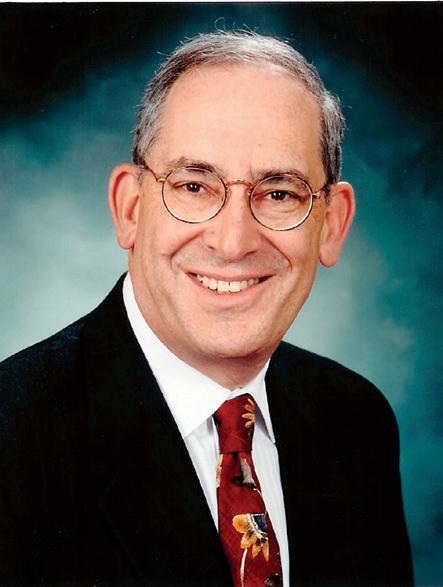

A frequent contributor to DBusiness magazine, David L. Littmann is a senior economist with the Mackinac Center for Public Policy in Midland. Previously, Littmann served for 35 years as senior vice president and chief economist at Comerica Bank in Detroit.


e national economic picture always will be colored by the size of the nation’s debt, which stands at $35.33 trillion (as of Sept. 24).
“ e national debt is on a steady march upwards, and it would take nearly $8 trillion of savings just to stabilize the debt over the next decade,” says Maya MacGuineas, president of the Committee for a Responsible Federal Budget. “It’s dangerous that we’ve let things get this bad, and we need to treat it like the priority that it is.
“ e President’s call for over $3 trillion of de cit reduction is a welcome start, and he deserves credit for presenting a budget that pays for new initiatives and improves our scal situation, but the budget doesn’t go nearly far enough.”
Timothy G. Nash, director of the McNair Center for the Advancement of Free Enterprise and Entrepreneurship at Northwood University in Midland, says the national debt is “untenable.”
“According to the U.S. Treasury Department, the U.S. national debt increased from 30 percent of GDP in 1981 to over 123.2 percent of GDP today,” he says. “We’re experiencing an untenable trend that cannot continue. America in 2024 is almost as nancially burdened as a percent of GDP as it was at the end of World War II.”
e bottom line is neither political party is willing to do what it takes — substantially cut government spending and raise taxes — to make a serious dent in the nation’s red ink.
“At the end of the day, the political will needs to be there to address it, and so far, it’s proven to be dicult,” U-M’s Ehrlich says. “You have to do unpopular things to solve problems, and there’s not a lot of urgency to do that.”
Post-pandemic in ation eroded consumer condence and spending, but rebounded in 2023 and
The softening of the labor market after the pandemic recovery prompted the Fed to lower interest rates.
(Gray areas represent a recession.)







2024. According to the CBO, which says consumer spending drove stronger-than-expected economic growth in late 2023 and early 2024, the growth of consumer spending is projected to moderate over the next three years because of tight credit conditions and weaker growth of wages. e growth rate of real consumer spending is projected to fall from 2.7 percent in 2023 to 1.3 percent in 2026.
“ e fact (the Fed) signaled another cut this year, four next year, and two in 2026, that’s a pretty good path to really curb the in ationary forces that we’ve seen, while enabling buying power for the consumer,” Stevens says. “ at’s cause for optimism.”
e Conference Board Consumer Con dence Survey, on the other hand, suggests continued concerns among consumers about the future, portending further weakness in spending for the balance of 2024. Consumer spending may pick back up in 2025, as lower interest rates and in ation will grant consumers relief.
Real consumer spending growth, according to the Conference Board, is still hovering slightly above real disposable personal income growth, meaning some households continue to nance purchases with debt, as excess savings have disappeared. Consumer credit and debt service payments are mounting, as well — which, combined with the high cost of living and elevated interest rates, also may curb expenditures on discretionary items.
In turn, auto loan and credit card delinquencies are above pre-pandemic levels, and banks are su ering increasing losses on unpaid consumer debt, the survey indicates.
Closer to home, U-M’s most recent state forecast says cracks have started to show in the foundation of Michigan’s previously vigorous economic recovery from the COVID-19 pandemic and subsequent expansion.
e Michigan House Fiscal Agency forecasts the state’s wage and salary employment to increase by .9 percent in 2025, and .3 percent in 2026. e agency predicts Michigan’s personal income will increase 4.1 percent in 2025, and 3 percent in 2026.
In ation (as measured by the Detroit Consumer Price Index) is forecast to increase 2.2 percent in 2025, and 2.3 percent in 2026. HFA says it expects the state’s unemployment rate to peak at 4.2 percent in 2025 and slide back to 4.1 percent in 2026.
“We continue to believe that clear progress on disin ation will allow the Federal Reserve to pivot to interest rate cuts in time to prevent a recession, although we project a period of slower national growth ahead,” Ehrlich says. “Our forecast
Source: U.S. Bureau of Labor Statistics
for Michigan’s economy follows those same contours, with job growth slowing substantially, yet staying in positive territory on an annual basis through 2026.”
Stevens says, “We’ve seen a softening of the labor market recently in Michigan, but not much. Generally speaking, our economy has been pretty strong here in Michigan.”
Stevens says he looks at the labor participation rate (which tracks the total job pool), rather than the unemployment rate (which counts people seeking employment), to get a more accurate view of how many people in the region are working.
“ e labor force participation rate has upticked in the past nine months,” he says. “In August, it was 62.3 percent, and a year ago it was 62.2 percent. During the pandemic, it was 56.6 percent.”
Stevens adds that the Fed’s cut of the interest rate should help Michigan’s economy.
“We’re a large manufacturing state,” he says. “We’re a large automotive state. e vehicle sales have been relatively strong, but (high) interest rates have hurt that. ere have been production cutbacks with some of the manufacturing plants, so that hurts the populus and the pocketbook. With interest rates coming down, hopefully it will give a little shot to the new-vehicle market.”
U-M’s Ehrlich agrees lowering interest rates will bene t Michigan as much as any other state.
“Michigan’s economy is a little more rate-sensitive because of the auto industry,” he says adding, “Michigan has two of the biggest mortgage companies (Rocket Mortgage and UWM) in the country, and they’re impacted by higher interest rates.
“We’re projecting job losses in the second half of this year,” Ehrlich says. “ e auto industry is something that we’re watching. We do expect moderate growth in 2025 and 2026.”
According to Ehrlich, one of the reasons U-M is predicting growth in 2025 and 2026 is the expected expansion of non-cyclical industries like government, health services, education, leisure, and hospitality.
“We expect those industries to keep growing. They have some momentum, and we expect them to cushion Michigan’s labor market.”
Pine Harbor Group’s Letts says he expects the state to see moderate growth, “driven largely by our state’s leadership in the electric vehicle sector. Although 92 percent of U.S. vehicle sales still involve ICE (internal combustion engine) vehicles, Michigan is leading the charge with investments in EV infrastructure, battery technology, and supply chain innovation, all of which are driving job creation.”
According to U-M, metro Detroit, and specifically the city of Detroit, is lagging behind the national and state economies. Detroit’s economic recovery continued through late 2023 and early 2024, despite challenges such as high interest rates and last year’s strikes at Blue Cross Blue Shield of Michigan, the Detroit Three automakers, and the three Detroit casinos.
The university estimates that the count of payroll jobs located within Detroit’s boundaries recovered from the COVID-19 pandemic in the second quarter of 2024, roughly one year after the count of employed Detroit residents did so.
Detroit’s unemployment rate, U-M says, will tick up to 7.6 percent in 2025, before falling to 6.9 percent by 2028–29.
Wage gains at Detroit payroll jobs and among city residents have been lagging behind local inflation recently, according to the U-M forecast, but that trend is expected to reverse course in the years ahead.
“We do expect growth to continue in Detroit,” says Ehrlich, who also is one of the directors of the EmeritiCity of Detroit University Economic Analysis Partnership. “We’re expecting a moderate 1.3 percent growth in payroll employment over the next three years, which is good to see.”
Stevens, who also is director of the Detroit Regional Chamber’s MichAuto initiative, indicates the U.S. auto industry expects to produce around 15.1 million units in 2024. “We hope to see a number closer to 16 million next year because of these rate cuts,” he says. “We’re optimistic about the number going up next year, which bodes well for Detroit, the region, and Michigan.”
He adds the Consumer Price Index in Detroit is up 3.5 percent in 2024, compared to about 2.5 percent in the rest of the country.
THE FACT (THE FED) SIGNALED ANOTHER CUT THIS YEAR, FOUR NEXT YEAR, AND TWO IN 2026, THAT’S A PRETTY GOOD PATH TO REALLY CURB THE INFLATIONARY FORCES THAT WE’VE SEEN...”— GLENN STEVENS
BRIGHTER FUTURE
The Michigan House Fiscal Agency anticipates the state personal income to increase by 4.1 percent in 2025 and 0.3 percent in 2026.
“That’s significantly higher than most places in the country,” Stevens says. “The cost of purchasing goods is huge. People have felt inflationary pressure. That’s been a headwind, and the ability to knock that back will help the consumer in Detroit.”
Letts says he’s “cautiously optimistic” about the economic prospects for metro Detroit over the next 12 months.
“While Detroit’s identity is still tied to the auto industry, recent investments in tech, health care, and mobility are positioning our city for meaningful long-term growth. Detroit is capitalizing on its strengths in advanced manufacturing, particularly in EVs and autonomous vehicle technologies.”
He maintains, however, that regional challenges like housing affordability, population density, and transportation infrastructure need to be addressed to sustain the momentum.
To get the big picture of a weather forecast, meteorologists use images from space. Economists, meanwhile, utilize data, trends, and history as their guide.
For that big picture of the economy, ask an objective, outside observer.
“GDP growth will remain a little lackluster this year, but as the shift in monetary policy begins to boost rate-sensitive spending, growth should reaccelerate in 2025 and beyond,” says Paul Ashworth, chief U.S. economist for Capital Economics in London. “The presidential election adds to the uncertainty.”
Other forecasters are able to look out the proverbial window, like the more-local Gielczyk, of the Michigan House Fiscal Agency, who says, “By historical standards, the Michigan economy is forecast to remain relatively strong.”






SUPPORTING SPONSORSHIP OPPORTUNITIES AVAILABLE!




























e Auburn Hills Chamber of Commerce Silver & Gold Awards celebrate innovation and dedication, providing a platform to recognize the outstanding businesses and professionals that exemplify excellence within the Auburn Hills business community.
Join us for a festive holiday brunch where we will announce this years’ nominees and award recipients. TICKETS AVAILABLE NOW.
CELEBRATING INNOVATION & LEADERSHIP | RECOGNIZING EXCELLENCE | POWERFUL BUSINESS CONNECTIONS




Promote






























The research for the 2025 Top Lawyers list was created by PRS (Professional Research Services) and is based on an online peerreview survey sent out to the certi ed lawyers within the metro Detroit area. Many votes were cast honoring excellence in the legal eld. Inclusion in DBusiness magazine’s Top Lawyers list is based solely upon one’s standing within their peer group. Listings in Top Lawyers cannot be purchased.
e 2025 Top Lawyers list will be posted at DBusiness.com on Nov. 18, 2024.



Matthew P. Allen
Miller, Canfield, Paddock and Stone
Steven J. Cernak Bona Law
Gregory L. Curtner
Riley Safer Holmes & Cancila
Howard B. Iwrey Dykema Gossett
Nicholas P. McElhinny Bodman
Larry J. Saylor
Miller, Canfield, Paddock and Stone
Kimberly L. Scott
Miller, Canfield, Paddock and Stone




L. Pahl Zinn
Dickinson Wright
Donovan S. Asmar Bodman
Trent B. Collier
Collins Einhorn Farrell
Michael J. Cook
Collins Einhorn Farrell
Phillip J. DeRosier Dickinson Wright
Lara L. Kapalla-Bondi
Miller, Canfield, Paddock and Stone
Kimberly A. Kardasz
Harvey Kruse
Derek J. Linkous Bush Seyferth
Susan M. McKeever Bush Seyferth
Edward M. Nahhat
Kemp Klein Law Firm
Terry Milne Osgood Mantese Honigman
Elizabeth L. Parker
Kostopoulos Rodriguez
Thomas J. Rheaume Jr. Bodman
William F. Rivard
Harvey Kruse
Je rey A. Turner Miller, Johnson, Snell & Cummiskey
Justin B. Weiner Bush Seyferth
Samantha S. Galecki
Miller, Canfield, Paddock and Stone
Amy M. Johnston
Miller, Canfield, Paddock and Stone




Timothy A. Diemer Jacobs and Diemer
Stephanie A. Douglas Bush Seyferth
Don Fulkerson
Fabian, Sklar, King & Liss
Christina A. Ginter
Kitch Attorneys & Counselors
Katharine Gostek
Kitch Attorneys & Counselors
Mark Granzotto
Mark Granzotto
K. Scott Hamilton
Dickinson Wright
Ramona C. Howard
Sommers Schwartz
Edward H. Pappas Dickinson Wright
LAW
Hebba Aref Bodman
Kasturi Bagchi
Miller, Canfield, Paddock and Stone
Eric S. Bergeron
Miller, Canfield, Paddock and Stone
David C. Bosman Bodman
Matthew K. Casey
Warner Norcross + Judd
Joseph N. Ejbeh Aloia Law
Martin S. Frenkel Maddin,Hauser, Roth & Heller
Robert B. Goldi Kotz Sangster Wysocki
Scott P. Gyorke Bodman
Shawn N. Hopper
Miller, Canfield, Paddock and Stone
Steven G. Howell Dickinson Wright
Joseph C. Huntzicker Miller, Canfield, Paddock and Stone
Joseph J. Kochanek Bodman
Melissa A. Lewis Bodman
Adam B. Norlander Bodman
Damali A. Sahu Bodman
Wayne S. Segal Dawda Mann Mulcahy & Sadler
Bonnie S. Sherr Bodman
Colleen M. Shevnock Dickinson Wright
William P. Shield Jr. Dickinson Wright
Larry R. Shulman Bodman
Frank R. Simon Simon
Eric M. Stein
Miller, Canfield, Paddock and Stone
Theodore B. Sylwestrzak Dickinson Wright
Kristen M. Veresh Varnum
Robert A. Wright III Dawda Mann Mulcahy & Sadler
Marc M. Bakst Bodman
Jason W. Bank KerrRussell and Weber
Michelle H. Bass Wolfson Bolton Kochis
Brendan G. Best Varnum
Jeffrey H. Bigelman Osipov Bigelman
Charles D. Bullock Stevenson & Bullock
Elliot G. Crowder Stevenson & Bullock
Robert J. Diehl Jr. Bodman
David M. Eisenberg Maddin, Hauser, Roth & Heller
Stuart A. Gold Gold, Lange, Majoros & Smalarz
Jonathan S. Green Miller, Canfield, Paddock and Stone
Joseph K. Grekin Schafer & Weiner
Paul Hage
Taft Stettinius & Hollister
Ernest J. Hassan III Stevenson & Bullock
Kim K. Hillary Schafer & Weiner
Steven G. Howell
Dickinson Wright
Scott M. Kwiatkowski Goldstein, Bershad & Fried
Stephen S. LaPlante
Miller, Canfield, Paddock and Stone
Michael D. Lieberman Lipson Neilson
Ralph E. McDowell Bodman
Max J. Newman Butzel Long
Norman D. Orr
Kemp Klein Law Firm
Yuliy Osipov Osipov Bigelman
James A. Plemmons
Dickinson Wright
Noel J. Ravenscroft Bodman
Steven A. Roach
Miller, Canfield, Paddock and Stone
John A. Simon
Foley & Lardner
Ronald A. Spinner
Miller, Canfield, Paddock and Stone
Michael A. Stevenson Stevenson & Bullock
Marc N. Swanson
Miller, Canfield, Paddock and Stone
Julie B. Teicher
Maddin, Hauser, Roth & Heller
Brian R. Trumbauer Bodman
Ann Marie Uetz Foley & Lardner
Robert A. Weisberg Carson Fischer
Jay Welford
Taft Stettinius & Hollister
Jaimee L. Witten Bodman
Scott A. Wolfson Wolfson Bolton Kochis
Doron Yitzchaki
Dickinson Wright
Craig E. Zucker
Maddin, Hauser, Roth & Heller
Jonathan S. Berg Bodman
William H. Horton
Giarmarco, Mullins & Horton
Daniel D. Quick Dickinson Wright
Harvey W. Berman Bodman
R. Edward Boucher Kotz Sangster Wysocki
Timothy P. Brady Kitch Attorneys & Counselors
Alexander J. Clark
Miller, Canfield, Paddock and Stone
Christopher A. Cornwall Dickinson Wright
Michael C. Decker Butzel Long
Ronald A. Deneweth Deneweth, Vittiglio & Sassak
Lawrence M. Dudek
Miller, Canfield, Paddock and Stone
Patrick A. Facca Facca, Richter & Pregler
Eric J. Flessland Butzel Long
Ronald E. Hodess Miller, Canfield, Paddock and Stone
Joseph C. Huntzicker Miller, Canfield, Paddock and Stone
Carina M. Kraatz
Kitch Attorneys & Counselors
Gerald J. Richter Facca, Richter & Pregler
Jeffrey M. Sangster Kotz Sangster Wysocki
John M. Sier
Kitch Attorneys & Counselors
Craig S. Thompson
Kitch Attorneys & Counselors
Joseph A. Bellanca Hertz Schram
Lisabeth H. Coakley Harness IP
Matthew D. Epstein Dinsmore & Shohl
Caroline B. Giordano Miller, Canfield, Paddock and Stone
Jennifer M. Hetu Bodman
Rebecca L. Wilson
The Dobrusin Law Firm
James C. Bruno
Butzel Long
Ralph A. Castelli Jr.
Kemp Klein Law Firm
Jennifer E. Consiglio
Butzel Long
Edward C. Dawda
Dawda Mann Mulcahy & Sadler
Laurence B. Deitch
Bodman
Daljit S. Doogal Foley & Lardner
Mark R. High Dickinson Wright
Laura E. Johnson Butzel Long
Lee Kellert
Taft Stettinius & Hollister
Carrie Leahy Bodman
Daniel H. Minkus Clark Hill
Robert Nederhood Foley & Lardner
Steven R. Pacynski Clark Hill
Marc K. Salach
Dawda Mann Mulcahy & Sadler
Cynthia L. Umphrey
Kemp Klein Law Firm
Kevin J. Watts
Miller Law Firm

Sherman Abdo La Grasso, Abdo & Silveri
Edward Amir Bajoka Bajoka Law Group
Aaron Boria
Boria Law — Criminal Defense Attorney
Suzan Gabbara Eaman & Gabbara
Marc Hart The Law Offices of Marc E. Hart
Joseph A. Lavigne Lavigne Law Offices
Mariell R. Lehman Lehman Law Firm
Thomas C. O'Brien Miller, Canfield, Paddock and Stone
Brian J. Prain Prain Law
Mitchell Ribitwer Ribitwer & Sabbota
Shannon Smith Shannon Smith Law
Meagan Stamell Stammell Law
Jennifer Z. Belveal
Foley & Lardner
Kenneth R. Chadwell
Mantese Honigman
George B. Donnini
Butzel Long
Damien DuMouchel
Butzel Long
David F. DuMouchel
Butzel Long
Gerald J. Gleeson II
Miller, Canfield, Paddock and Stone
Joseph A. Lavigne
Lavigne Law Offices
Walter J. Piszczatowski
Hertz Schram
Joseph E. Richotte
Butzel Long
Neil Rockind
Neil Rockind | Rockind Law
Amy M. Christen
Dykema Gossett
John Joseph Conway
John J. Conway
Deborah L. Grace
Dickinson Wright
Roberta P. Granadier
Dickinson Wright
Eric W. Gregory II
Dickinson Wright
Mark W. Jane
Butzel Long
Samantha A. Kopacz
Miller, Canfield, Paddock and Stone
Mary Jo Larson
Warner Norcross + Judd
Charles M. Lax
Maddin, Hauser, Roth & Heller
Lynn McGuire
Butzel Long
Christopher McMican
Clark Hill
Cynthia A. Moore
Dickinson Wright
Kenneth J. Sachs
Bodman
Jordan Schreier
Dickinson Wright
David B. Walters
Bodman
Jennifer Watkins
Warner Norcross + Judd
Lisa B. Zimmer
Warner Norcross + Judd
Karen L. Boore
Miller, Canfield, Paddock and Stone
Rodger Kershner
Howard & Howard Attorneys
Steven C. “Steve” Kohl
Warner Norcross + Judd
Richard A. Barr Honigman
Brian J. Considine
Dawda Mann Mulcahy & Sadler
George F. Curran III Kotz Sangster Wysocki
Fredrick J. Dindoffer
Bodman
Nathan D. Dupes
Bodman
Todd C. Fracassi
Troutman Pepper Hamilton Sanders
Beth S. Gotthelf
Butzel Long
Susan L. Johnson
Butzel Long
Sharon R. Newlon
Dickinson Wright
James K. O'Brien
Dean & Fulkerson
Gary A. Peters
Howard & Howard Attorneys
Susan J. Sadler
Dawda Mann Mulcahy & Sadler
AnnMarie Sanford
Dickinson Wright
Todd C. Schebor
Dykema Gossett
Erica J. Shell Bodman
Arthur Siegal
Taft Stettinius & Hollister
Neil S. Silver
Dawda Mann Mulcahy & Sadler
Tyler D. Tennent
Dawda Mann Mulcahy & Sadler
Mark A. Bank
Bank Rifkin
Sherri L. Bono
Bono Legal Group
Kyle Bristow Bristow Law
Sonia Cannon
Cannon Law
Randall J. Chioini
Chioini Group
Cristina Crescentini
Hertz Schram
Roquia K. Draper
Warner Norcross + Judd
Laura E. Eisenberg
Eisenberg & Spilman
John R. Foley
John R. Foley
Patrick A. Foley
John R. Foley
Randi P. Glanz
Clark Hill









Lorne B. Gold
The Gold Law Firm
Ruth Goldner Goldner Deeg
Kimberly A. Grover
Kimberly A. Grover
Renee K. Gucciardo The Gucciardo Law Firm
Marcy Hahn Lotus Legal Solutions
Ryan Kelly Kelly & Kelly
Channelle Kizy-White Kizy Law
Kevin J. McGiness McGiness Law Firm
David S. Mendelson Mendelson Law Firm
Keri Middleditch Middleditch Law Firm
Matthew S. Weaver Giarmarco, Mullins & Horton
Kelly A. Allen Adkison, Need, Allen, & Rentrop
Courtland W. Anderson Bodman
Mark J. Burzych Fahey Schultz Burzych Rhodes
Salam Elia Elia Law
Bernard J. Fuhs Butzel Long
Derek D. McLeod Taft Stettinius & Hollister
Gary M. Remer Maddin, Hauser, Roth & Heller
Briar Siljander Trio Law
Nina Paolini-Lotarski Aloia Law








Julia A. Perkins Varnum
Alisa Peskin-Shepherd Transitions Legal
B. Andrew Rifkin Bank Ri in
Jorin G. Rubin Rubin Frampton, Attorneys at Law
Nazli G. Sater Warner Norcross + Judd
Kurt E. Schnelz Schnelz Wells
Lynn Capp Sirich Dickinson Wright
Amy M. Spilman Eisenberg & Spilman
Amy A. Stawski
Amy Stawski Law Firm
Lisa D. Stern
Hertz Schram
David L. Steinberg
David L. Steinberg
Richard Al Aziz Delta Law Group
Jennifer L. Benedict Honigman
Reesa N. Benko Benko Health Law
Aaron Beresh Howard & Howard Attorneys
Brandon M. Dalziel Bodman
Jovan Dragovic Kotz Sangster Wysocki
Gregory Drutchas Kitch Attorneys & Counselors
Debra A. Geroux Butzel Long
John Paul Hessburg
Kitch Attorneys & Counselors
Ann T. Hollenbeck
Jones Day
Robert S. Iwrey
The Health Law Partners
Mark S. Kopson Plunkett Cooney
Alexander Lebedinski Giarmarco, Mullins & Horton
Rolf E. Lowe
Wachler & Associates
Theresamarie Mantese Mantese Honigman
Gregory W. Moore
Taft Stettinius & Hollister
Lori-Ann Rickard Rickard & Associates
Alan T. “Al” Rogalski
Warner Norcross + Judd
David L. Rogers Rogers & Associates
Kimberly J. Ruppel
Dickinson Wright
Jeffrey S. “Jeff” Segal
Warner Norcross + Judd
Laura H. Selzer
Miller, Canfield, Paddock and Stone
Keith J. Soltis
Kotz Sangster Wysocki
Annalise Lekas Surnow Bodman
Andrew B. Wachler
Wachler & Associates
Dustin T. Wachler
Wachler & Associates
Deborah J. Williamson
Williamson Health Law
Mark E. Wilson
Dickinson Wright
Sarah L. Wixson
Varnum
Russell Abrutyn
Abrutyn Law
N. Peter Antone
Antone, Casagrande & Adwers
Linda J. Armstrong
Butzel Long
Edward Amir Bajoka
Bajoka Law Group
Elizabeth B. Baker
Miller, Canfield, Paddock and Stone
Dorothy H. Basmaji
Antone, Casagrande & Adwers
Meghan N. Covino Honigman
Jalal J. Dallo
Dallo Law
Christopher M. Dutot
Miller, Canfield, Paddock and Stone
Rami Fakhoury
Fakhoury Global Immigration
Leila Freijy
Law Office of Leila Freijy
Suzan Gabbara
Eaman & Gabbara
Joseph Kallabat
Joseph Kallabat & Associates
Christopher M. “Chris” LeClair
Warner Norcross + Judd
Elise S. Levasseur
Dickinson Wright
Clara DeMatteis Mager
Butzel Long
Bushra A. Malik
Butzel Long
Rebecca Mancini
Clark Hill
Ahndia Mansoori
Kitch Attorneys & Counselors
Eli Maroko
Taft Stettinius & Hollister
Michael P. Nowlan
Clark Hill
Reginald A. Pacis
Butzel Long
Meghan Kennedy Riordan Kitch Attorneys & Counselors
Natalia Sarraf Ellis Porter
Julianne Cassin Sharp Miller, Canfield, Paddock and Stone
Suzanne K. Sukkar
Dickinson Wright
Michal Terebelo Fakhoury Global Immigration
Phillip M. Shane Miller, Canfield, Paddock and Stone
Angela Emmerling Shapiro Butzel Long
Rick A. Decker
Miller Law Firm
Jennifer A. Dukarski Butzel Long
Karl A. Hochkammer Honigman
Michael S. Khoury Fisher Broyles
Jill M. Miller Bodman
Claudia Rast Butzel Long
Jordan A.W. Barkey
Michigan Auto Law
Derek J. Brackon
Michigan Auto Law
Jeffrey A. Bussell
Michigan Auto Law
Mark G. Cooper
Taft Stettinius & Hollister
Michael G. Costello Bodman
Thomas W. Cranmer
Miller, Canfield, Paddock and Stone
Michelle Thurber Czapski
Bodman
Michael Fabian
Fabian, Sklar, King & Liss
Julie I. Fershtman
Foster Swift Collins & Smith
Robert E. Graziani
Howard & Howard Attorneys
Lawrence E. Gursten
Michigan Auto Law
Rabih Hamawi
Law Office of Rabih Hamawi
Harvey R. Heller
Maddin, Hauser, Roth & Heller
Aaron Herskovic
Fabian, Sklar, King & Liss
Patrick A. King
Fabian, Sklar, King & Liss
Adam Kutinsky
Kutinsky
Jason J. Liss
Fabian, Sklar, King & Liss
Geoffrey D. Marshall
Bowen, Radabaugh & Milton

Julie C. Mayer
Maddin, Hauser, Roth & Heller
Joseph P. McGill
Foley, Baron, Metzger & Juip
John R. Monnich Sr.
Ottenwess Law
Mark E. Morley
Secrest Wardle
Moheeb H. Murray
Bush Seyferth
Jeffrey G. Schultz
Harvey Kruse
Stuart A. Sklar
Fabian, Sklar, King & Liss
Nicole E. Wilinski
Collins Einhorn Farrell
Douglas Young
Young Insurance Law
William G. Abbatt
Brooks Kushman
Daniel P. Aleksynas
Young Basile Hanlon & MacFarlane
John S. Artz
Dickinson Wright
Robin W. Asher
Miller, Canfield, Paddock and Stone
Andrew S. Balazer
Bodman
Andrew R. Basile Jr.
Young Basile Hanlon & MacFarlane
Kimberly A. Berger
Miller, Canfield, Paddock and Stone
Jeremy D. Bisdorf
Taft Stettinius & Hollister
Mark A. Cantor
Brooks Kushman
John E. Carlson
Carlson, Gaskey & Olds
Gregory D. DeGrazia
Miller, Canfield, Paddock and Stone
Catherine T. Dobrowitsky
Rivenoak Law Group
Eric M. Dobrusin
The Dobrusin Law Firm
Samir “Sam” Fares
Howard & Howard Attorneys
Stacie N. Farina
Young Basile Hanlon & MacFarlane
Megan E. Fink
Bodman
Sam Haidle
Howard & Howard Attorneys
Jennifer M. Hetu
Bodman
Wyatt J. Istvan-Mitchell
Warner Norcross + Judd
Linda D. Kennedy
Panagos Kennedy
Erin Klug
The Dobrusin Law Firm
Susan M. Kornfield Bodman
Douglas LaLone
Fisher Broyles
Patrick M. McCarthy
Howard & Howard Attorneys
Alexander S. McGee
Howard & Howard Attorneys
Gerald E. McGlynn III
Howard & Howard Attorneys
Francine B. Nesti
Young Basile Hanlon & MacFarlane
Katherine M. Pacynski
The Dobrusin Law Firm
Paul J. Palinski
The Dobrusin Law Firm
A. Michael Palizzi
Miller, Canfield, Paddock and Stone
Kristen L. Pursley
The Dobrusin Law Firm
Joseph J. Pytel
Dickinson Wright
Philip E. Rettig
Dickinson Wright
Hope V. Shovein
Brooks Kushman
Kimberly M. Slaven
Dickinson Wright
Marcus W. Sprow Foley & Lardner
Michael B. Stewart
Fishman Stewart
Daniela M. Walters
The Dobrusin Law Firm
Frederick A. Acomb
Miller, Canfield, Paddock and Stone
Roger H. Cummings
Dickinson Wright
Joseph D. Gustavus
Miller, Canfield, Paddock and Stone
James Y. Rayis
Giarmarco, Mullins & Horton
Jeffrey G. Richardson
Miller, Canfield, Paddock and Stone
Nicholas J. Stasevich
Butzel Long
Bruce C. Thelen
Dickinson Wright
Richard A. Walawender
Miller, Canfield, Paddock and Stone
William E. Altman
Fisher & Phillips
Michelle D. Bayer
Joelson Rosenberg
John T. Below
Bodman
John F. Birmingham Jr.
Foley & Lardner
Kathleen L. Bogas
Bogas & Koncius
Kaitlin A. Brown
Fisher Broyles
Aaron V. Burrell
Dickinson Wright
Randal R. Cole
Dawda Mann Mulcahy & Sadler
Michelle P. Crockett
Miller, Canfield, Paddock and Stone
Rebecca S. Davies
Butzel Long
David R. Deromedi
Dickinson Wright
Carey A. DeWitt
Butzel Long
Terence P. Durkin
Kitch Attorneys & Counselors
Sue Ellen Eisenberg
Sue Ellen Eisenberg & Associates
Barry S. Fagan
Fagan McManus
Gary S. Fealk Bodman
Mark R. Filipp
Kemp Klein Law Firm
Donald J. Gasiorek Morgan & Jones
Gary R. Glenn
Miller, Canfield, Paddock, and Stone
Aaron D. Graves Bodman
Timothy H. Howlett
Dickinson Wright
Michelle L. Kolkmeyer Bodman
Jeffrey S. Kopp
Foley & Lardner
David Kotzian
David A. Kotzian
Jason R. Mathers
Harvey Kruse
Ann L. Miller
Miller Law Firm
Sam Morgan
Morgan & Jones
Megan P. Norris
Miller, Canfield, Paddock, and Stone
Philip B. Phillips
Foley & Lardner
Tad T. Roumayah Sommers Schwartz
Jennifer L. Sabourin
Miller, Canfield, Paddock and Stone
Jennifer B. Salvatore Salvatore Prescott Porter & Porter
Brian Schwartz
Miller, Canfield, Paddock and Stone
Rebecca C. Seguin-Skrabucha Bodman
Heidi T. Sharp
The Sharp Firm
Brian D. Shekell
Clark Hill
Melissa M. Tetreau Bodman
Richard W. Warren
Ogletree Deakins
Kathryn S. Wood
Dickinson Wright
Eddie D. Woodworth
Young Basile Hanlon & MacFarlane
Edward F. Kickham
Kickham Hanley Inc.
Gregory K. Need
Adkison, Need, Allen & Rentrop
Jerome P. Pesick
Williams, Williams, Rattner & Plunkett
Richard D. Rattner
Williams, Williams, Rattner & Plunkett
Ron E. Reynolds
Hilger Hammond, Attorneys at Law
Carol A. Rosati
Rosati Schultz Joppich & Amtsbuechler
Michael Vogt
Dickinson Wright
Peter H. Webster
Dickinson Wright







Lawrence J. Acker
The Acker Law Firm
David C. Anderson Collins Einhorn Farrell
Michael P. Ashcraft Jr. Plunkett Cooney
Theresa M. Asoklis Collins Einhorn Farrell
Donald D. Campbell
Collins Einhorn Farrell
Timothy A. Dinan
Dinan Legal Associates
Je rey R. Hicks
Collins Einhorn Farrell



Thomas H. Howlett
The Googasian Firm
James J. Hunter
Collins Einhorn Farrell
Matthew L. Turner Sommers Schwartz
Steve M. Wolock Maddin, Hauser, Roth & Heller
David A. Ettinger Honigman
Howard B. Iwrey Dykema Gossett
Robert E. Murkowski Miller, Canfield, Paddock and Stone

Thomas J. Tallerico Bodman
J. Adam Behrendt Bodman
Eric S. Bergeron Miller, Canfield, Paddock and Stone
Norman C. Ankers Foley & Lardner
Jordan S. Bolton Taft Stettinius & Hollister
Keefe A. Brooks Brooks Wilkins Sharkey & Turco
Joel C. Bryant Miller, Canfield, Paddock and Stone
Joseph Doerr Doerr MacWilliams Howard
Stephen P. Dunn Bodman
Nicholas J. Ellis Foley & Lardner
Seth D. Gould Miller Law Firm
Patrick B. Green Dickinson Wright
Jennifer Grieco Altior Law
David Hansma Clark Hill
William H. Horton Giarmarco, Mullins & Horton
Derek Howard Doerr MacWilliams Howard
Aaron Miller Keyes Aloia Law
Eric A. Ladasz Dawda Mann Mulcahy & Sadler
Sara K. MacWilliams Doerr MacWilliams Howard
Gerard V. Mantese Mantese Honigman
James A. Martone
Dickinson Wright
Stephen McKenney Altior Law
E. Powell Miller Miller Law Firm
Vanessa L. Miller
Foley & Lardner
Eric J. Minch Miller Law Firm
Sonal Hope Mithani Miller, Canfield, Paddock and Stone
David Mollicone Altior Law
John Mucha III
Dawda Mann Mulcahy & Sadler
Kenneth Neuman Altior Law
Marc Newman Miller Law Firm
Kevin F. O'Shea Miller Law Firm
Martha J. Olijnyk Miller Law Firm
Ryan L. Perry Giarmarco, Mullins & Horton
Jeffrey G. Raphelson Bodman
Brian H. Rolfe
Kemp Klein Law Firm
Mark Rossman Rossman
Joseph J. Shannon Bodman
Matthew Smith Altior Law
Alan J. Taylor
Segal McCambridge Singer & Mahoney
Douglas L. Toering Mantese Honigman
Thomas Van Dusen Bodman
Ian Williamson Mantese Honigman
Frances Belzer Wilson
Dawda Mann Mulcahy & Sadler
James L. Woolard Jr.
Miller, Canfield, Paddock and Stone
Le Roy L. Asher Jr. Miller, Canfield, Paddock and Stone
Michael D. Carroll Kerr, Russell and Weber
James P. Davey
Kemp Klein Law Firm
Michael C. Decker
Butzel Long
Timothy P. Dugan Kotz Sangster Wysocki
Faith M. Gaudaen
Kemp Klein Law Firm
J. Christian Hauser
Frasco Caponigro Wineman Scheible Hauser & Luttmann
Kevin S. Hendrick Clark Hill
Gregory P. LaVoy
Harvey Kruse
Raymond L. Morrow Kemp Klein Law Firm
Tyler P. Phillips Kotz Sangster Wysocki
Mark D. Sassak Deneweth, Vittiglio & Sassak
Anthony Vittiglio II
Deneweth, Vittiglio & Sassak
Sarah L. Cylkowski Bodman
Michelle Thurber Czapski Bodman
Kali M. L. Henderson
Seward Henderson
Thomas W. James
Michigan Auto Law
Jordan M. Jones
Michigan Auto Law
Kimberly A. Kardasz
Harvey Kruse
Alexander P. Kemp
Michigan Auto Law
Richard A. Moore
Michigan Auto Law
Travis J. Peterson
Harvey Kruse
Michael F. Schmidt
Harvey Kruse
Dean Amburn Amburn Law
John S. Artz
Dickinson Wright
David L. Atallah Carlson, Gaskey & Olds
Justin P. Bagdady Bodman
Marjory G. Basile
Miller, Canfield, Paddock and Stone
Glenn E. Forbis Harness IP
Andrew (Jake) Grove
Howard & Howard Attorneys
Richard W. Hoffmann Reising Ethington
Kristopher K. Hulliberger
Howard & Howard Attorneys
Linda D. Kennedy Panagos Kennedy
J. Bradley (Brad) Luchsinger Harness IP
Barbara Lynn Mandell Fishman Stewart
Ariana Deskins Pellegrino
Dickinson Wright
Steven Susser
Carlson, Gaskey & Olds
Brian D. Wassom
Warner Norcross + Judd
Katina K. Gorman Miller, Canfield, Paddock and Stone
Samantha A. Kopacz Miller, Canfield Paddock and Stone
Robin W. Asher Miller, Canfield, Paddock and Stone
Andrew S. Balazer Bodman
Glenn E. Forbis Harness IP
J. Benjamin Dolan Dickinson Wright
Joseph P. Buttiglieri Kemp Klein Law Firm
Daniel P. Makarski Secrest Wardle
Thomas McNeill Tom McNeill ADR
Robert F. Riley Riley & Hurley
I.W. Winsten Honigman
Cathy R. Bowerman Foley, Baron, Metzger & Juip
David W. Christensen Sommers Schwartz
Matthew G. Curtis Sommers Schwartz
Lisa Esser-Weidenfeller Sommers Schwartz
Richard L. Groffsky Sommers Schwartz
Helen K. Joyner Fieger Law
Randall A. Juip
Foley, Baron, Metzger & Juip
Marc E. Lipton Lipton Law
Donna M. MacKenzie Olsman MacKenzie Peacock & Wallace
Brian J. McKeen McKeen & Associates
Cullen B. McKinney Nauts, McKinney, Dwaihy & Beach
John J. Moran
Nauts, Mckinney, Dwaihy & Beach
Jules B. Olsman Olsman MacKenzie Peacock & Wallace
Jesse M. Reiter
Reiter & Walsh — American Baby & Child Law Centers
Judith A. Susskind Sommers Schwartz
Gerald Thurswell Thurswell Law
Rebecca S. Walsh
Reiter & Walsh — American Baby & Child Law Centers
Brian W. Whitelaw Foley, Baron, Metzger & Juip
Dina M. Zalewski Sommers Schwartz
Thomas G. Appleman Miller, Canfield, Paddock and Stone
Allison R. Bach
Dickinson Wright
Gene P. Bowen Bodman
Richard C. Bruder Kemp Klein Law Firm
Timothy R. Damschroder Bodman
Michael D. DuBay Honigman
Matthew W. Frank Kemp Klein Law Firm
Justin G. Klimko Butzel Long
Jeffrey L. LaBine Miller, Canfield, Paddock and Stone
Gjina Lucaj Foley & Lardner
Omar A. Lucia Foley & Lardner
Ryan M. Olson Bodman
Kenneth R. Powell Bodman
Michael T. Raymond
Dickinson Wright
William L. Rosin
Dickinson Wright
John P. Ulrich Jr. Kotz Sangster Wysocki
Shusheng Wang Miller, Canfield, Paddock and Stone
Sarah J. Williams Bodman
Gregory L. Wysocki Kotz Sangster Wysocki
Nolan A. Yaldo Howard & Howard Attorneys
Angela L. Baldwin Miller Law Firm
Derk W. Beckerleg Secrest Wardle
Alexandra E. Dieck Bodman
Sarah J. Gabis Bodman
Lawrence T. García Miller, Canfield, Paddock and Stone
Robert J. Gavin
Shifman & Carlson
Lisa J. Hamameh
Rosati Schultz Joppich & Amtsbuechler
Melvin Butch Hollowell Miller Law Firm
Steven P. Joppich
Rosati Schultz Joppich & Amtsbuechler
Christopher D. Kaye Miller Law Firm
Debani T. Gordon Lehman Bodman
Ronald C. Liscombe
Miller, Canfield, Paddock and Stone
Steven D. Mann
Miller, Canfield, Paddock and Stone
Michael P. McGee
Miller, Canfield, Paddock and Stone
Thomas R. Schultz
Rosati Schultz Joppich & Amtsbuechler
Amanda Van Dusen
Miller, Canfield, Paddock and Stone
Celeste E. Arduino Bodman
Christopher J. Dine Bodman
Robin D. Ferriby Clark Hill
Nicholas S. Kovach Shifman & Carlson
Mark R. Lezotte Butzel Long
Jennifer M. Oertel Bodman
Albert H. Pak Bodman
Wendolyn Wrosch Richards Miller, Canfield, Paddock and Stone
Duane L. Tarnacki
Clark Hill
Thomas J. Azoni
Secrest Wardle
Dale R. Burmeister
Harvey Kruse
A. Vince Colella
Moss & Colella
Jennifer Damico Fieger Law
Jordan M. Ewald Michigan Auto Law
Robert M. Giroux Jr. Giroux Pappas Trial Attorneys
Dennis M. Goebel Harvey Kruse
Scott A. Goodwin Scott Goodwin Law
George A. Googasian The Googasian Firm
Lawrence E. Gursten Michigan Auto Law
Steven M. Gursten Michigan Auto Law
Christopher J. Hastings The Hastings Law Firm
Dustin Hoff Christensen Law
Christopher C. Hunter Michigan Auto Law
Ven Johnson Ven Johnson Law
Joumana Kayrouz The Law Offices of Joumana Kayrouz
Sarah Kuchon Hohauser Kuchon
Nicholas Kyriakopoulos NK Law
Jody B. Lipton Lipton Law
Marc E. Lipton Lipton Law
Jonathan R. Marko Marko Law
Brian A. McKenna
Sinas Dramis Law Firm

Richard A. Moore Michigan Auto Law
Mike Morse Mike Morse Law Firm
David Moss Moss & Colella
Jules B. Olsman Olsman MacKenzie Peacock & Wallace
Daniel V. Padilla Padilla Law Group
Emily Peacock Olsman MacKenzie Peacock & Wallace
Kevin H. Seiferheld Michigan Auto Law
Mark E. Servais Michigan Auto Law
James Spagnuolo Macomb Law Group
Joshua R. Terebelo Michigan Auto Law
Craig M. Weber The Googasian Firm
Ronald K. Weiner Lipton Law
POPULATION OF LAWYERS BY GENERATION
Sharon S. Almonrode Miller Law Firm




T. Pre 1944 1,304
B. 1944-1960 10,133
X. 1961-1980 13,052
M. 1981-1996 8,656
Z. 1997+ 144
Thomas P. Branigan Bowman and Brooke
Dale R. Burmeister Harvey Kruse
Michael D. Cummings Harvey Kruse
Clayton F. Farrell Collins Einhorn Farrell
Dennis M. Goebel Harvey Kruse
Emily E. Hughes Miller Law Firm
Dennis A. Lienhardt Jr. Miller Law Firm
Christina J. Marshall Miller, Canfield, Paddock and Stone
Thomas D. Colis
Miller, Canfield, Paddock and Stone
Steven M. Frank Miller, Canfield, Paddock and Stone
Craig W. Hammond Dickinson Wright
Steven H. Hilfinger Foley & Lardner
Eric McGlothlin Dickinson Wright
Patrick F. McGow Miller, Canfield, Paddock and Stone
Alan D. Szuma
Miller, Canfield, Paddock and Stone
Benjamin J. Aloia Aloia Law
C. Leslie Banas
Kemp Klein Law Firm






David C. Moll
Harvey Kruse
John R. Prew
Harvey Kruse
Patrick G. Seyferth Bush Seyferth
Michael J. Sullivan Collins Einhorn Farrell



Michael W. Hartmann Miller, Canfield, Paddock and Stone
Kathleen H. Klaus Maddin, Hauser, Roth & Heller
Edward G. Lennon Lennon Law
Je rey S. Arono
Miller, Canfield, Paddock and Stone
Barbara A. Bowman Bodman
David M. Barbour Kotz Sangster Wysocki
Aaron E. Bass Honigman
Ian Bolton Ian Bolton Law
Alexander J. Clark Miller, Canfield, Paddock and Stone
Jason Conti Foley & Lardner
George A. Contis Giarmarco, Mullins & Horton
David C.C. “Dave” Eberhard Warner Norcross + Judd
Joseph M. Fazio Miller, Canfield, Paddock and Stone
LeClair L. Flaherty Wright Beamer
James S. Fontichiaro Barris, Sott, Denn & Driker
T. Scott Galloway Galloway and Collens
Gregory J. Gamalski
Bodman
Dana Kreis Glencer
Dawda Mann Mulcahy & Sadler
Edward S. Gusky
Varnum
Daniel M. Halprin
Dawda Mann Mulcahy & Sadler
Mark R. Hauser
Maddin, Hauser, Roth & Heller
Erin A. Johnson
Dickinson Wright
Joseph M. Judge
Dawda Mann Mulcahy & Sadler
Thomas A. Kabel
Butzel Long
Mark P. Krysinski
Taft Stettinius & Hollister
Monica J. Labe
Dickinson Wright
Scott R. Lesser
Miller, Canfield, Paddock and Stone
Kelly M. Lockman
Bodman
Jason C. Long
Williams, Williams, Rattner & Plunkett
Michael J. Lusardi
Dickinson Wright
Christopher C. Maeso
Dickinson Wright
David D. Marsh
Kemp Klein Law Firm
Christopher R. Martella
Dawda Mann Mulcahy & Sadler
Gregg A. Nathanson
Couzens, Lansky, Fealk, Ellis, Roeder & Lazar
Thomas C. Rauch
The Kemp Klein Law Firm
J. Adam Rothstein
Honigman
Mark D. Rubenfire
Taft Stettinius & Hollister
Lowell D. Salesin
Honigman
Nicholas P. Scavone Jr. Bodman
Todd A. Schafer
Dawda Mann Mulcahy & Sadler
Richard M. Selik
Dawda Mann Mulcahy & Sadler
Daniel M. Share
Barris, Sott, Denn & DrikerP.L.L.C.
C. Kim Shierk
Williams, Williams, Rattner & Plunkett
Dawn Faxon Singer
Dickinson Wright
Andrew Z. Spilkin Bodman
Erin Bowen Welch
Dawda Mann Mulcahy & Sadler
Grant W. Williams
Miller, Canfield, Paddock and Stone
Roxana Zaha
Butzel Long
Katheryne L. Zelenock
Dickinson Wright
Richard A. Zussman
Taft Stettinius & Hollister
Matthew P. Allen
Miller, Canfield, Paddock and Stone
Robert J. Cambridge Bodman
Dennis K. Egan
Kotz Sangster Wysocki
John A. Hubbard
Hubbard Snitchler & Parzianello
Mark L. Kowalsky
Taft Stettinius & Hollister
Jack J. Mazzara
Altior Law
Peter C. Rageas
Law Offices of Peter C. Rageas & Associates
Kristine R. Thomson
Saretsky Hart Michaels + Gould
Jonathan P. Witt Foley & Lardner
William B. Acker Kemp Klein Law Firm
Steven R. Cole Bodman
Sean H. Cook
Warner Norcross + Judd
David R. de Reyna Kotz Sangster Wysocki
Katrina Piligian Desmond
Miller, Canfield, Paddock and Stone
Lynn A. Gandhi Foley & Lardner
Gary R. Glenn
Miller, Canfield, Paddock and Stone
Michael A. Indenbaum Honigman
Peter J. Kulick
Dickinson Wright
Jay B. Long Bodman
Andrew W. MacLeod
Dickinson Wright
Amanda Afton Martin
Kemp Klein Law Firm
Jeffrey M. McHugh
Miller, Canfield, Paddock and Stone
Jeffrey D. Moss
Dawda Mann Mulcahy & Sadler
Eric M. Nemeth Varnum
Gregory A. Nowak
Miller, Canfield, Paddock and Stone
Neal Nusholtz
Kemp Klein Law Firm
Richard A. Shapack
Shapack Law Group
Daniel Soleimani
Butzel Long
Michael D. Umphrey
Kemp Klein Law Firm
Devon P. Allard
Miller Law Firm
Daniel L. Ravitz
Miller Law Firm
Brian M. Saxe
Miller Law Firm
Thomas H. Bergh Varnum
Kelly M. Burnell Bodman
Joseph P. Buttiglieri
Kemp Klein Law Firm
Casey W. Callahan
Kemp Klein Law Firm
Thomas P. Cavanaugh Giarmarco, Mullins & Horton
Kathleen A. Cieslik Varnum
Jonathan M. Colman Barron, Rosenberg, Mayoras & Mayoras
Anthony P. Cracchiolo Bodman
Andrew H. Curoe Bodman
David R. de Reyna Kotz Sangster Wysocki
Randall A. Denha Denha & Associates
Carole S. Empey
Foley, Baron, Metzger & Juip
Julius H. Giarmarco
Giarmarco, Mullins & Horton
Kristen R. Gross
Law Offices of Kristen R. Gross
Brian R. Jenney
Kemp Klein Law Firm
Shirley A. Kaigler
Taft Stettinius & Hollister
Robert D. Kaplow
Maddin, Hauser, Roth & Heller
Robert B. Labe
Williams, Williams, Rattner & Plunkett
David P. Larsen
Bodman
Bill Lentine
Taft Stettinius & Hollister
Elizabeth L. Luckenbach
Dickinson Wright
John D. Mabley
Chalgian & Tripp Law Office
J. Thomas MacFarlane
Clark Hill
Julia C. Massaro
Bodman
Chiara Mattieson
Mattieson Law
Alan A. May
Kemp Klein Law Firm
Andrew W. Mayoras
Barron, Rosenberg, Mayoras & Mayoras
Joseph R. Owens
Dickinson Wright
Julie A. Paquette
Law Office of Julie A. Paquette
Robert P. Perry
Butzel Long
Austin W. Probst
Kemp Klein Law Firm
Christopher Rambus Bodman
Stephen C. Rohr
Miller, Canfield, Paddock and Stone
Don L. Rosenberg
Barron, Rosenberg, Mayoras & Mayoras
Glenn G. Ross
Dawda Mann Mulcahy & Sadler
Richard F. Roth
Maddin, Hauser, Roth & Heller
Dawn M. Schluter
Schluter & Hughes Law Firm
Aaron H. Sherbin
Taft Stettinius & Hollister
Joan Cripe Skrzyniarz
Dickinson Wright
Mark M. Snitchler
Hubbard Snitchler & Parzianello
James P. Spica
Chalgian & Tripp Law Office
Jeffrey S. Sternberg
Kotz Sangster Wysocki
Cynthia L. Umphrey
Kemp Klein Law Firm
Michael J. Vomastek
The Head Law Firm
Robert S. Zawideh
Kemp Klein Law Firm
Mark A. Aiello
Aiello Law Group
Joel Alpert Alpert & Alpert
Todd D. Barry
Michigan Workers Comp Lawyers
Alex Berman
Berman & Kaufman
John P. Charters Charters, Tyler, Zack & Shearer
William E. Gray
Michigan Workers Comp Lawyers
Andrea L. Hamm
Michigan Workers Comp Lawyers
Jeffrey E. Kaufman Berman & Kaufman
Jeffrey Kirschner
Jeffrey Kirschner Law
Richard Warsh
Alpert & Alpert


















































OneStream Inc. in downtown Birmingham, which developed a custom finance management platform that combines finance and operational data with AI, spent a decade meticulously preparing for what became a $490-million IPO in July.


BY DALE BUSS

































Service: Creates custom enterprise software financial platforms targeted to CFOs
Headquarters: Birmingham
Revenue: $450M
Employees: 1,300+
Customers: 1,400+
CEO: Tom Shea
Founded: 2012

neStream Inc.’s rise to a technology “unicorn” is remarkable for at least two reasons. First, the company is native to Michigan, which remains a relative backwater when it comes to producing digital-tech startups, even as the state sits in a commanding position in automotive, manufacturing, and many other sorts of technology.
Second, OneStream’s rise from birth to the subject of a $490-million initial public o ering in July came over the course of 12 years, with that relatively long arc of time be tting the conservatism of the nancial-services industry that spawned it. OneStream, based in downtown Birmingham, wasn’t like, say, a company creating generative-AI programs that went from garage status to world-beater in a manner of months.
“ e rst milestone was taking the idea and getting one customer to pay you for it,” says Tom Shea, the company’s co-founder and CEO, about the approach OneStream took to building its business. “ en you get that success to build the next three customers, and the next 10 customers.”
It’s probably a Michigan hallmark that one of the state’s outstanding software plays, and one of just a handful of startups ever to reach a valuation of $1 billion or more, is a relatively conservative out t. OneStream is known for fostering an environment of optimism, according to some employees. at’s what comes from reaching the mark of having more than 1,400 customers and 1,300-plus employees, spread over 45 countries.
Another reason the optimism seems justi ed is that OneStream is very much executing on the prospectus it laid out in its U.S. Securities and Exchange Commission lings for the IPO: Its strategy is well thought out, which is a point of di erentiation amid the sea of tech companies that tend to display kneejerk decision-making — which often works out, but sometimes doesn’t.
Michigan’s few huge software plays include Duo Security, a cybersecurity rm founded by Dug Song in Ann Arbor and purchased by Cisco in 2017 for $2.35 billion, plus some others that have made a global splash (see sidebar).



TICKER TAPE
Tom Shea, CEO of OneStream Inc. in downtown Birmingham, center, rings the opening bell on July 24, 2024, for the company’s IPO, which raised $490 million. Trading is available on the Nasdaq Global Select Market under the symbol “OS.”











So, as unfamiliar as Wall Street was with Michigan-based software companies when OneStream went public in July, investors paid tribute to the stock even in spite of a remarkably stormy summer in the stock market. OneStream’s share price climbed steadily, if not spectacularly, between its debut at $20 in July and its $34-a-share range at the beginning of October.
Positive evaluations by securities analysts following the company helped the process along. OneStream “is one of the premier growth assets in all software and the new gold standard of O ce of the CEO software, which is an increasingly critical and strategic area of investment in the enterprise,” BTIG analyst Matt VanVliet said in a client note early on.
TD Cowen analyst Derrick Wood, meanwhile, saw OneStream “riding the modernization wave” for CFO operations.
“Enterprise nance applications have lagged in the cloud transformation cycle and the market is still ridden with decades-old legacy technologies,” he wrote. “We think (OneStream) is positioned to disrupt the status quo, usher in new innovation around nancial and operational work ows, and drive a strengthening legacy displacement and cloud-migration wave.”
On another point, Bank of America securities analysts believed OneStream can “steadily increase its share of its lucrative and lightly penetrated $44-billion market for business performance management software,” noting that OneStream had been growing faster than other back-o ce-software peers.
OneStream’s founding by three men who came out of the nancial-software world is a major reason the company has continued to hit the mark even through its IPO phase. eir approach may not seem conservative by traditional growth patterns for new companies, but it certainly is in comparison with the go-go ethos of Silicon Valley.
What Shea, President Craig Colby, and Chief Technology O cer Bob Powers did in founding OneStream — their “big idea” — was create a single enterprise and nance software platform for the 16 disparate products the three had developed at their respective previous companies, UpStream and Hyperion. e co-founders were inspired by the iPhone, Shea says, because of its ability to integrate multiple tools into a single device.
e founding goal was to “empower the o ce of the chief nancial o cer.” At the time, that proved to be a very tting and lucrative ambition, because CFOs were getting overwhelmed by disparate new programs to help them track and automate many di erent nancial functions. eir computer “dashboards” to track all these programs came to resemble the instrument panel of an airliner cockpit.
Now, as OneStream climbs ever higher into a multibillion-dollar valuation, this goal is even more timely. at’s because the role of corporate CFOs the world over has shifted out of merely being the chief bean counter, making the trains run on time, and carrying out the mandates of the CEO — with an occasional hand-raise telling the boss something would just be too expensive, or too risky.
Now, CFOs increasingly are being tasked with stepping up as strategic thinkers for the future course of the business, as well as serving as the bridge between top






KKR, 52.7%
Thomas Shea, 7.9% (CEO and co-founder)


Robert Powers, 7.1% (CTO)
Craig Colby, 6.3% (President and co-founder)
Goldman Sachs, 3.3%


Terrance Shea, 2.9%
Midwest Fish Holdings, 2.3%
John Von Allmen, 1.3% (Former CFO)
Other Investors / Insiders / Employees, 19.8%




























































leadership and nancial realities. Because of that, there are more time and attention demands on CFOs than ever.
at change is “right on target for our value proposition,” Shea says. “OneStream is the rst and only comprehensive platform for the O ce of the CFO. Why is that? From the rst line of code, we knew we needed to create a single integrated platform for core nancial capabilities: planning, reporting, consolidation, (and) account reconciliation. ings every CFO has to do.
“Why is that important? It doesn’t matter (what company it is), or if you’re a fairly signi cant or complicated business, everyone has to do those things and do them right. Whether you’re just publishing them to internal stakeholders or Wall Street, or you’re just a company that has to create a di erent management view of the business, you have to do these things monthly, quarterly, semi-yearly, and yearly, and you have to do them well.”
OneStream takes pressure o CFOs and their teams in executing these routine duties. “Too often, they’re pushed to work long hours just to get those things done at the end of the month, quarter, and year,” Shea says. “So how can a CFO have an expanded role if they can barely get done what has to get done? e No. 1 one way you can help a CFO take on an expanded role is getting rid of the non-value-added work the nance teams are doing.”
New investor and regulatory requirements, along with increased expectations, have also added to a CFO’s burdens. And that’s in addition to the extra time and focus required of them to become a true strategic partner inside the C-suite.
“Every time one of these (requirements) adds to CFO duties, the team may have to take 10 or 15 di erent solutions, independent pieces of software, and change them and synchronize them all,” Shea explains.
“Without an integrated approach to do that, your time is spent just trying to stay current. e real way we’re changing this game and helping CFOs truly unlock the potential of nance is getting rid of non-value-added work.”
At the same time, Shea says, OneStream software “goes after new challenges and (expansion) of duties through our app store. We add new capabilities without creating tech debt” — known as the problems created in operation and maintenance when software writers take shortcuts in writing code so they achieve their goals faster — “because it’s running on our platform.
“If you do separate systems for reporting, planning, and account reconciliation, for instance, those pieces are linked at the legal-entity level. On average, we’re replacing two to six systems when we sell our software to a company. Imagine the amount of energy that goes into keeping those going.”
e co-founders were counting on initial customers being able to see clearly what OneStream software could do for them. at’s why they were con dent they could secure a handful of early adopters.



“Next,” Shea recalls, “there was a major nancial milestone, once we proved that this platform could build solutions on top of it. We said the next stop (was) $100 million in revenue. We had to do the hard work, just keep making our customers successful and proving it and proving it.”
e three bootstrapped the company for six years, growing in size, customer count, and workforce population to a few hundred each. Around 2018, when OneStream reached the milestone of $100 million in revenue that Shea looked forward to, they decided to bring in an outside investor.
KKR, the New York-based company that helped create the vaunted “leveraged buyout” of the 1980s and today ranks as a major private-equity player, has had a majority stake in OneStream since 2019, as well as a signi cant presence on the company’s board of directors. KKR brought on board members such as Gen. David Petraeus, former head of the Central Intelligence Agency.
“We didn’t need the money,” Shea says. “We were pro table and growing, with a positive operating cash ow, and had no debt. So why did we make that decision? It was actually signi cant in how it would take the business to the next level and push our goalposts out to $500 million” in revenue. “It helped us scale the business and gure out what the organizational structure had to be.”
OneStream enjoyed the attention of a handful of private-equity companies that would have loved to end up with the prize that KKR got. “We felt really aligned to KKR and (the fact) that they understood our vision and would be a partner, as well as bring capital-market capabilities,” Shea relays. “We had strong brand alignment, and they gave us access to other funding rounds we did.”
Shea’s founders gave up majority control of their baby because “some of our early investors were looking for liquidity,” he says. “ ey were looking for a return on investment. ey’d spent years backing us.






FOR US, AS FOUNDERS OF A BOOTSTRAPPED COMPANY, ALTHOUGH WE’VE BEEN GOING THROUGH A LOT (OF GROWTH), WE’VE BEEN PRETTY JUDICIOUS ABOUT HIRING AND MAKING SURE WE’RE NOT OVER-HIRING...”
— Tom Shea

But (the founders) are still very signi cant shareholders. We still feel that we have ownership of the company. And KKR has treated us that way. It’s a good, balanced relationship.”
e next goal was hitting $500 million in revenue, or ling an IPO, whichever came rst. OneStream privately led for an IPO in 2021, for which it raised $200 million for a $6-billion valuation, before the market went cold. e company didn’t end up pursuing an IPO that year, which Shea says is a testament to its exibility, and its plans to meet its goals responsibly.
With KKR’s guidance and expertise in the house, OneStream could have aimed for an IPO pre-COVID-19, and investment bankers — including Goldman Sachs — were interested in taking the company by the hand. But the founders believed they weren’t ready from the perspective of corporate maturity.
“As a software-as-a-service (SaaS) company,” Shea says, “we were transitioning from license revenue. We wanted to be all the way through our SaaS transition, which takes a lot of capital. And we didn’t want to have to explain that to public markets. at was all part of the calculus: ere’s a really huge opportunity; focus on the long term; do it in the private markets.”
Another matter was growing too fast. When COVID-19 broke out in March 2020, it helped OneStream’s leadership hit the pause button. “ ere’s been a lot of self-inicted head-count reductions lately” in tech companies, OneStream CFO Bill Koefoed told this interviewer in 2022. “As CFO, you need to have one foot on the accelerator and one on the brake at all times.
“For us, as founders of a bootstrapped company, although we’ve been going through a lot (of growth), we’ve been pretty judicious about hiring and making sure we’re not over-hiring. It hasn’t been growth at all costs. It’s appropriate to say we’ve got one foot on the brake in hiring.”
In 2022, for example, OneStream hired about 300 people, which marked 30-percent growth over its head count a year earlier. “But if you look at our plan going into that year, our expectation was we were going to hire more than that,” Koefoed said.
As OneStream grew, it wasn’t all about ciphers and cyber, bits and bytes, dollars and cents. e company also tried to create some of the sizzle that be ts any kind of digital-tech company.
For example, its marketing expenditures included sponsorship of some relatively high-pro le athletes, including professional golfers Bryson DeChambeau, Marc Leishman, Sophia Popov, and Hudson Swa ord, along with Scottish tennis champion Jamie Murray.
Successful software companies also typically major in culture, in creating the kind of atmosphere and ethos that younger workers demand and, at least for a time, pledge their loyalty to.
“I like to say we have a mission-driven culture,” Shea says. “From the beginning, we knew the company could only be built with a sensitivity for what we do — using OneStream output to report to external stakeholders. You have to be successful, for them, and that’s the mission that drives you.
“Every customer needs to be a reference. e only way that works is when it’s demonstrated (to be important) by leaders. So I have very much of an, ‘I’m in it with you’ mentality as a leader. is mission gives people something to be proud and thoughtful about, and helps create a mission-driven culture.”
OneStream Inc. in downtown Birmingham isn’t the only Michigan-based tech company making splashes that are visible to the entire country these days. StockX and Lineage Logistics are at least two others.
StockX is a Detroit-based startup whose TV ads are running prolifically these days, displaying a dizzying array of used “sneakers and streetwear” that must be highly coveted by the actors in the ads, given the cold glares they project as they model the treasures they found on America’s leading resale marketplace for such merchandise.
“StockX sits at the intersection of sport and culture, empowering people to trade what they love,” StockX CEO Greg Schwartz said recently. Amid that intersection, StockX also recently struck a multiyear corporate partnership with the Detroit Pistons that brands the company as the franchise’s new jersey partner.
Referred to as a “stock market of things,” StockX has been tapping into global demand for goods that also includes handbags and other accessories. A key to its business model is establishing multiple “verification centers” that use a rigorous process to a rm the authenticity of what StockX buys and sells.
But if investors want to trade stock in StockX itself, they’ll have to wait a while. Like OneStream, StockX also reportedly sni ed the idea of an IPO in 2022, at the time announcing the company was worth nearly $4 billion after it raised some funds in the secondary markets. It isn’t clear when StockX might actually pull the trigger on a public o ering.
Meanwhile, another of the biggest IPOs of the summer came from Lineage Logistics, the Novi-based operator of cold-storage warehouses across the world. While not solely a technology-based company, Lineage has leaned heavily on constructing an e cient digital infrastructure to absorb and operate dozens of warehouse companies.
The company raised $4.4 billion in a July IPO that valued Lineage at more than $18 billion. From there, Lineage promptly announced it would give stock awards to its 16,000 U.S. employees that totaled $100 million.
“We’ve sought to foster an ownership mindset at Lineage and have celebrated our wins together,” said Adam Forste, founder and co-executive chairman.
— Dale Buss







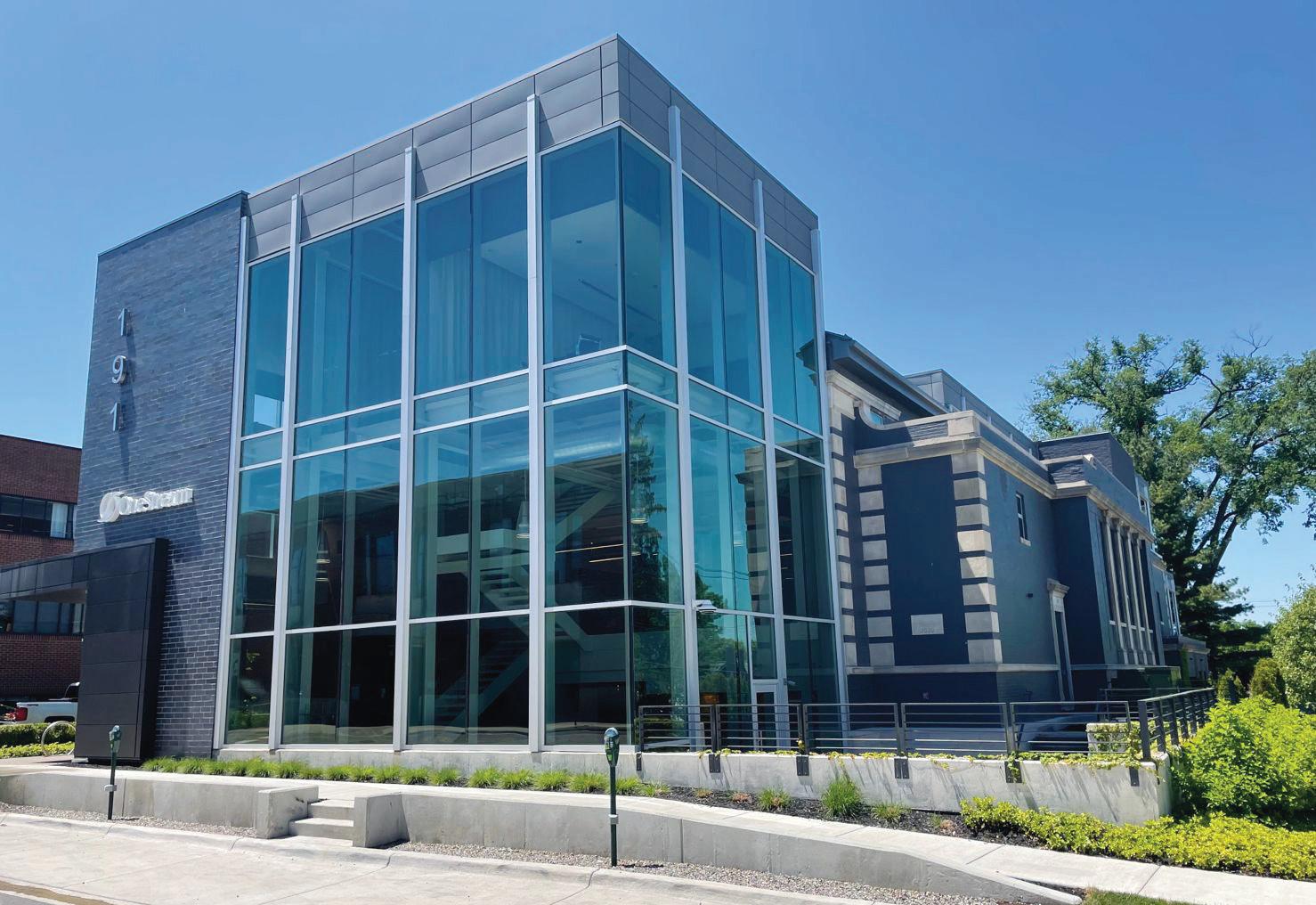








So does the company’s headquarters in downtown Birmingham. OneStream’s early growth occurred in two rented o ce buildings in Rochester, one beneath the bridge on Rochester Road that leads to downtown.
A few years ago, OneStream was putting together a deal to erect its own campus nearby, but things didn’t work out. Soon after, Birmingham beckoned with some intriguing real estate opportunities as well as one endemic characteristic that Rochester couldn’t beat: being about 20 minutes closer to Detroit Metro Airport.
Moving ahead, OneStream acquired a former church just north of Maple Road, at 191 N. Chester Street, and spent $2 million to $3 million remodeling it into a 23,000-square-foot headquarters facility that holds about 150 employees on peak days of hybrid attendance.
It boasts 100-percent LED lighting, polished concrete ooring, and numerous other “sustainable design elements” such as a heating and cooling system designed to consume up to 22 percent less energy than traditional systems, according to the company.
“We designed the space with the goal of creating an energy-e cient and design-forward facility that could be a standout in any technology hub from San Francisco to Seattle or New York,” says Koefoed, who had spent 15 years with various tech companies in Seattle and Silicon Valley.
As Shea puts it, the building is “a great place for people to work, where they feel welcome and valued. It’s been a nice gathering place for us, warm and bright with a lot of energy. When you show up there, you can feel the energy.” at’s the key: when employees show up. OneStream maintains the hybrid policies it put in place during the pandemic, giving employees a lot of physical exibility. “ e highest number of our employees are our sales and marketing people” around the world, “and they’ve been naturally remote. We’ve kept that basically in place,” Shea says.
“What wasn’t (remote) was engineering. When we’re designing products and coding, that’s where it’s been a bit di erent. Certain teams have rules or (attendance) guidelines. If they’re doing complex engineering, or working with AI, they need to be in the room together. at’s the best way to convey thoughts. I see teams adapting to what makes them e cient, but (attendance) works best for us as a company. I like to be around people myself. Right now, people are spending more time coming into the o ce.”
In the meantime, bespeaking the fact OneStream’s leadership all come from the cautious nance world, even all of these positive elements didn’t quite add up to readiness for an IPO.
ere also were quarterly losses OneStream sustained for a while as it made the transition to an all-SaaS company. “With a full SaaS model, you’re charging on a monthly or a yearly basis, and there’s di erent revenue recognition and accounting,” Shea says. “ is will create cash ow and pro tability challenges until we’re all the way through” the transition.
OneStream also continues to invest in the business. “Not long ago, we only had 300 to 400 people,” Shea says. “Now we’re scaling up the organization to be a
HOLY CLOUD
In 2022, OneStream established its headquarters in downtown Birmingham. The new facility, fashioned from a former church, includes capacity for around 150 employees, LED lighting, polished concrete flooring, and an energy-e cient HVAC system.

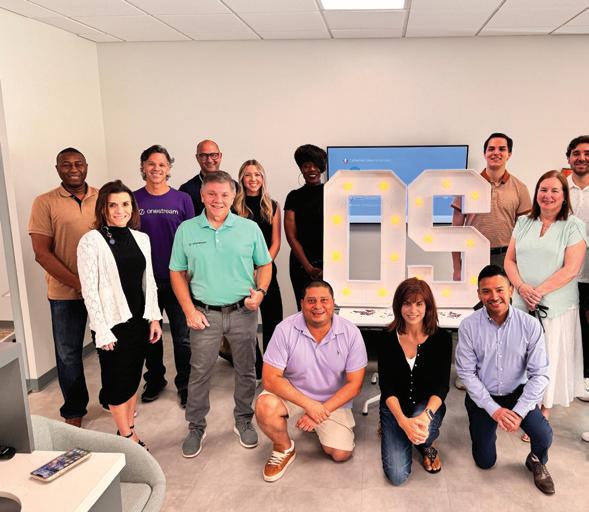
billion-dollar company. We’ve had to make a lot of investments in the infrastructure of the business, and now you start to get leverage on those investments.”
Growth at OneStream may not be as exponential as at other unicorns, but that’s on purpose. “Just when you think you’ve gured out how to be a certain size of company — and I’ve been an entrepreneur for a number of years — and you hit a level where you’ve gured this out, your organizational structure is right, you’ve got the right approach to go to market — suddenly, a year later, you’re broken again,” Shea says.
OneStream also faced the challenges of growing in the international arena.
Its big idea was universal, of course, and numbers are a language of their own not subject to translation di culties. “But you operate one way in the U.S., and you have to be very aware and think when you operate in Europe,” Shea says.
For instance, when it comes to hiring talent there, German consultants pretty much only work with German companies; it’s the same with French consultants and French companies.
As Detroiters, Shea says, his founding team brought “that Detroit mentality” to growing OneStream: “Just go out there and get it done. But as you get bigger and bigger, you need to re ne. You don’t want to lose the grit, but you have to start to add the polish, too.
“You have to be aware of the pro le of the company and the discipline that needs to go into being a larger organization, or even pre-public. You have to make sure you’re ready.”
As part of its preparations for the IPO over the last year or so, for example, KKR helped the executives participate in mock calls with securities analysts and investors.
“You have to think clearly about the story you’re telling and how you tell it,” Shea says. “What is the value proposition? How did you get where you are, and how will you continue to do it?











OneStream o ces around the world celebrated the company’s IPO on July 24, 2024, (starting clockwise upper left) in Britain, Germany, Italy, and Spain. Overall, the company has clients in more than 45 countries, including North America, South America, Europe, the Middle East, Africa, and Asia-Pacific.
“What you really learn from that exercise is that (investors) don’t necessarily understand your business at your customer’s depth. ey’re looking at 100 companies” as potential investment targets, “so you have to be clear in articulating your value proposition and make sure you’re repeating and learning from those individuals.
“You need to get the right understanding of what you’re trying to achieve. You sell a sophisticated product to a sophisticated buyer, so you want (an investor) or analyst to understand all the di erent aspects. You really have to practice that.”
Judging by OneStream’s share price and analysts’ appreciation for the company’s proposition, it’s so far, so good.
But can a company that’s taken more than a decade to grow this formidable, with a big idea as good as OneStream’s, keep going without signi cant competition, without keeping a door open for another company that could o er a single platform akin to OneStream’s?
“Yes,” Shea posits. “ ere’s no other legitimate single platform for the CFO because our mentality began with our rst line of code. You can’t (acquire) your way into it.
“ e ‘one’ in ‘OneStream’ was part of a rollup” of previous single-function software platforms, “and you can’t get there without starting over. To the extent (competitors) are o ering multiple solutions, they’re still usually strung together from di erent pieces of technology, because they haven’t started something from the beginning.”
Just as in many other technology rms — and practically every business, for that matter — the rapid evolution of articial intelligence poses both a threat and an opportunity to OneStream. But mostly, in Shea’s view, it’s an opportunity.
“AI is a foundational part of our story, and one of the things I’m most excited about,” he says. “Unlike a lot of businesses out there today, we began our AI journey almost a decade ago. In 2015, we saw real hype around machine learning — similar to where we are right now” with generative AI.
“We demonstrated the rst machine learning neural-network forecasting capability in early 2017 at our user conference,” Shea says. “After that, we recognized that people really
liked it; they don’t understand it, but they’d better invest in it. So from early 2017 and since, we rededicated ourselves to an AI-service component and a section of our platform with our own intellectual property.
“Now,” Shea continues, “major companies are using AI for demand forecasting, such as major retailers around the world, and testing language-learning platforms as they play with (ChatGPT).
“Early machine learning models can outperform what humans can do in predicting, but if you don’t show a nancial analyst why this was a better prediction of demand, such as the performance of a sales promotion or how weather a ects shipments, they wouldn’t get it. So our AI has to be transparent, auditable, and repeatable.”
Bank of America analyst Koji Ikeda noted OneStream’s advanced AI tools — which, he said in a research note last summer, “aim to accelerate the creation of new applications. As more OneStream-powered apps are created, the platform would likely become even more entrenched, making it even more di cult to replace.”
While the company allowed an interview with Shea for this story, it declined to provide access to any OneStream directors, other members of its management team, or other employees.
All of which enhances the one thing Shea wants out of OneStream more than anything else: irreplaceability. And the only way to continue to ensure that, he believes, is to follow the approach he and his team have used from the beginning.
“I grew up in the auto business, and companies that had 8 percent, that was a great operating margin,” he says. “So I learned in a disciplined era. at’s our natural way of working here; a lot of the nancial team thinks the same way. We’re very con dent of our ability to run a pro table business and evolve it.”

2012: Launched platform, first customer was a multibillion-dollar global enterprise.
2014: Debuted first OneStream-built applications that extend beyond the finance organization.
2015: Introduced first planning application.
2016: Brought forward account reconciliation application.
2017: Released financial close and consolidation core solution, and began developing first machine learning-powered application.
2018: Introduced updated reporting and analytics core solution, and acquired 250th customer.
2019: Launched predictive financial signaling core solution; KKR acquired a majority stake in the company.
2020: Surpassed $100M in ARR, introduced tax provisioning and transaction matching applications, acquired 500th customer.
2021: Grew past $200M in ARR; received a $200M investment from new investors.
2022: Reported $300M+ in ARR, commercially released first AI-enabled application (Sensible ML), acquired 1,000th customer.
2023: Surpassed $450M in ARR and launched OneStream Solution Exchange.
2024: Acquired remaining equity interests of DataSense to continue development of AI-enabled solutions; completed $490M IPO.
Source: OneStream Inc.











Need the perfect gi for your clients, colleagues, family, or friends? Explore the latest book from award-winning journalist and DBusiness magazine editor R.J. King. “Detroit: Engine of America” is the real life story of how the city grew, step by step, from a French fort on the riverfront in 1701 to become the world’s largest manufacturing economy in 1900.
Audiobook Now Available on Audible For author presentations, call 248-691-1800, Ext. 135
To purchase copies of “Detroit: Engine of America” personally signed by the author, visit DetroitEngineofAmerica.com.






























For nearly 40 years, Fabian, Sklar, King & Liss, P.C., has been a trusted advocate in metro Detroit and throughout Michigan for homeowners and businesses facing fi re and other signifi cant property insurance claims. The fi rm, led by attorneys Stuart Sklar, Jason Liss, Aaron Herskovic, Elizabeth King, and Don Fulkerson, is nationally recognized for its expertise in insurance coverage analysis. Notably, the fi rm has been a recipient of the DBusiness Top Lawyer honor from 2010 to 2024, underscoring its commitment to excellence in the fi eld.

The fi rm’s team assists both residential and commercial clients in recovering compensation from their insurance companies for fire-related losses, including property damage, living expenses, and business income. From initial claim presentation to examinations under oath and through the litigation process, the firm leverages its extensive experience to help clients navigate the complexities of their claims and secure the compensation they deserve.







With decades of collective experience, the franchise law team at Fahey Schultz Burzych Rhodes PLC is dedicated to helping Detroit-area business owners take their growth to the next level through franchising. Whether you’re launching your first franchise or managing a complex system, the firm provides expert handson guidance every step of the way. From drafting FTC-compliant franchise disclosure documents to navigating complex federal and state regulations, the team works tirelessly to ensure brands’ legal protection and long-term success.

FSBR attorneys have been trusted advisers to some of the nation’s fastest-growing and top-ranking franchise brands. They help clients protect their trademarks, draft franchise agreements, and develop strategies for scaling their business with confidence.
Reach out today and see why so many successful brands trust FSBR with their franchise systems.
Pictured from left to right: Mark Burzych, Addison Szymanski, Kaitlyn Harries, John Forrest, Rhonda Mask, Michael Cole, Hannah Morgan Smith, and Mitchell Zolton.


















































Since the dot-com tech crash of the year 2000, attorney and CPA Peter C. Rageas has represented investors who have suffered monetary losses because of a financial adviser’s or stockbroker’s negligence or reckless recommendations.
Working with a stockbroker or financial adviser can be a great way to navigate the financial markets, but things do not always go as planned. Advisers make mistakes, and sometimes those mistakes have devastating

consequences — such as the loss, in whole or in part, of a client’s life savings.




Rageas, who brings years of financial expertise to his practice, works with his clients to analyze such situations and determine if a financial adviser has committed negligence or has violated any Financial Industry Regulatory Authority (FINRA) rules or regulations. From there, he helps clients navigate the recovery process for those losses and delivers outstanding results on their behalf.


PETER J. LUCIDO
1 S. MAIN ST., MOUNT CLEMENS, MI 48043 586-469-5350 | MACOMBGOV.ORG/ DEPARTMENTS/PROSECUTORS-OFFICE
Macomb County Prosecutor Peter J. Lucido set new standards for excellence, innovation, and diversity; set a record for national good government awards; modernized technology; and streamlined domestic violence, juvenile, and overall case processing better than ever. Lucido reformed hiring practices and then hired a record number of women — 70% of assistant prosecuting attorney I positions are filled by women, now a majority prosecuting in court. Lucido promoted a record number of women to lead special units, building a diverse and inclusive team that reflects a significant shift from past hiring practices.
More crime victims get more service, with a 67% increase in victim support. Faster warrant turnarounds and discovery improve transparency and reduce delays.
Lucido’s efforts led to the collection of over $1.2 million in child support by targeting those owing $5,000 or more, largely without criminal prosecution, while enhancing support for specialty courts and diversion programs that deliver proven results while saving money.





Jon Marko has established himself as a leading figure in Detroit’s legal community, known for his relentless pursuit of justice and commitment to his clients. Marko Law consistently delivers results for those who need it most.
Known as “Million Dollar Marko” for his multimillion-dollar verdicts and settlements, Marko has earned recognition for his legal acumen and dedication. He is also a strong advocate for legal reforms and uses his Cases Gone Wild podcast to discuss high-profile cases in depth, offering

valuable insights into the justice system.
With Marko’s leadership, the firm’s track record of success has garnered accolades; in fact, Marko has been named Michigan’s “Go-To Lawyer” by leading publications for both negligence and employment law. Whether it’s addressing employment matters, the violation of someone’s civil rights, or catastrophic injury cases, Marko Law continues to set a standard for legal excellence and community engagement across Michigan.









BY R.J. KING
Traveling in style is always a must, and that’s guaranteed for those who own the new Gulfstream G700. Loaded with every amenity imaginable, the top-of-theline corporate jet offers what Gulfstream touts as the most spacious cabin in the industry. Features include handcrafted seats that double as ergonomic beds, 20 panoramic oval windows, plasma-ionized air that replenishes every two to three minutes, Jet ConneX Ka-band Wi-Fi, and up to five living areas. Powered by twin Rolls-Royce Pearl 700 engines, the G700 has a top cruising speed of Mach 0.90 and a range of 7,750 nm. Plus, there’s room for up to 19 passengers.
Price: Starting at $75 million

1 3
Marketed as the first all-electric, full-size SUV, the 2025 Cadillac Escalade IQ began production in October at General Motors’ Factory Zero production facility in Hamtramck. The Escalade IQ is built on GM’s modular EV propulsion architecture and is linked to a dual-motor, all-wheel-drive setup that delivers more than 200 kWh and a Cadillac-estimated range of 460 miles. In addition to a 0-to-60 mph time of less than five seconds, the SUV features standard Super Cruise hands-free driver assistance technology with three years of the OnStar Super Cruise plan. Inside, the Escalade IQ offers a curved 55-inch total diagonal pillar-to-pillar display, one of the largest in the industry, a second row geared to working executives, and a 36-speaker audio system.
Price: Starting at $127,700


Sometime during the Detroit Tigers’ 2025 baseball season, Comerica Park will introduce the Home Plate Club. Plans are to have the new prime seating section, located directly behind home plate, ready for Opening Day on April 4, 2025, but the new club space underneath the seats will take longer to complete and open during the season. The club will feature displays relating to Detroit’s past, present, and future, along with refined architecture and upscale finishes. In addition to curated amenities and luxuries, the club will offer a main-feature bar, diverse culinary offerings, private restrooms, and VIP parking. The menu will include traditional stadium fare along with culinary offerings like sushi, charcuterie, small plates, and customizable desserts.
Price: A front-row seat for the season is $54,000 (est.)

Looking for a barista’s touch at home or the office? The Victoria Arduino Venus Bar Semiautomatic Espresso Maker is a vertical coffee machine that evokes the tranquility of a Paris café, and is symbolic of handmade machines produced prior to World War II. The freestanding machine makes coffee and espresso, provides hot water, and offers a drier, hotter steam that enhances the creaminess in a cappuccino. The Venus Bar also has a double safety system with a valve and a thermostat, while the hydraulic systems maintain thermal stability. What’s more, various operations can be automated, including a self-cleaning process. The hand-crafted machines come in three colors — copper, brass, and chrome.
Price: $17,150
For the 2025 season, Victory Cruise Lines’ vessels Victory I and Victory II will return to the Great Lakes and will dock in downtown Detroit. All cruise ship rooms feature queen-sized beds, Egyptian cotton bedding, televisions, private bathrooms, and an outside-facing window. Luxury accommodations include the Owner’s Suite, which has its own terrace, multiple entrances, and a living room with an additional pull-out bed. Each voyage includes lectures by knowledgeable experts and historians, as well as multiple shore excursions. Dining options include the Coastal Dining Room, the Grill, the Compass Lounge, and the Tavern. Plans include 36 voyages of 10 to 12 days each, and the ships will touch all five Great Lakes.
Price: Starting at $7,399 per person (10-day cruise)








Breitling Chronomat Automatic 36


For cocktail parties and formal dinners, the Breitling Chronomat Automatic 36 is perfect for the woman who desires a watch that’s both chic and sporty. The timepiece, which o ers a steel and rose gold case with a mother of pearl diamond dial, features a “Rouleaux” bracelet with a butterfly clasp. The Chronomat Automatic 36 is powered by the Breitling Caliber 10, a COSC-certified chronometer. Available at Lucido Fine Jewelry in downtown Rochester.
Price: $9,950


Built for Apple Intelligence with the all-new A18 chip, the Apple iPhone 16 and iPhone 16 Plus o er an easy-to-use personal intelligence system that understands personal context while protecting user privacy. Features include powerful upgrades to an advanced camera and control system, an action button that o ers quick access to useful features, and a big boost in battery life. The units come in five colors — black, white, pink, teal, and ultramarine. With systemwide writing tools built into iOS 18, users can rewrite, proofread, and summarize text nearly everywhere they write, including mail, notes, pages, and third-party apps. In the notes and phone apps, users can also record, transcribe, and summarize audio.
Price: Starting at $799
















The GC Sport fading russet-colored dial, with applied Arabic numerals at 3, 9, and 12, captures the spirit of the clay court tennis season. The watch’s ergonomic case measures 8.7mm, while its lightweight design in polished Grade 5 titanium can literally be worn during tennis matches as well as a lively pickleball competition. It also is perfect for watching matches from luxury seats or a sponsor suite. A vulcanized rubber strap includes the Maison’s signature Clous de Paris motif on the top side. This is a limited run of 200 timepieces. Available at Lucido Fine Jewelry in downtown Birmingham.
Price: $17,300
Serial entrepreneur Steven Wang, who grew up in Troy, left high school following his sophomore year to launch a stream of digital enterprises.
BY TOM MURRAY
Perhaps the least surprising fact about dub, the online copy-trading platform, is that Steven Wang, its founder and CEO, is 22 years old. After all, Wang has been dabbling in the business world for a very long time — namely, since the second grade.
“We didn’t have that much money growing up,” Wang recalls. “My parents worked for Ford and GM, and we were a super stingy family, but investing was always a big thing for them and they taught me early on to earn my own money. So they opened a $200 custodial account on Scottrade under their name, but (they let me) trade.”
Initially, Wang, who grew up in Troy, didn’t exactly distinguish himself as a whiz kid investor.
“I was so bad. I lost so much money,” Wang says. “I remember this one article said to buy this penny stock. I put all my money into it and I lost like 70 percent (of my investment).
“But it taught me a lesson — you gotta do your own research and only invest in what you know. I knew Coca-Cola, because I was drinking it, and it was probably a good stock to buy. Apple, too, because everyone wanted to get the iPhone.”
By that time, Wang was in the fifth grade.
“I (went) to public school,” he says. “First, I went to Bemis Elementary, and then had one year at Boulan Park Middle School. I was a chess nerd as a kid, and a swimmer and a Boy Scout, as well.
“I was super competitive, so I was banging on neighbors’ doors and selling cookies for Boy Scouts. My parents obviously wanted me to do well in school, and that led to me going to a robotics summer camp. I learned the awesomeness of blending programming with physically building something.”
Wang’s family lived a block away from Troy High School, but that’s not where he ended up going. “I got a financial scholarship, and I was accepted at Cranbrook Schools and Detroit Country Day. I chose Cranbrook because it was close to home,” he says.

Eamon Javers, CNBC senior Washington correspondent, interviews Steven Wang, founder and CEO of dub. The digital platform allows users to copy the trades and portfolios of seasoned traders, hedge funds, influencers, and more.
The jump to the environment of a private school was a major adjustment for Wang. “My parents were making lower-middle-class salaries,” he says, “nowhere near the rich heritage of the Cranbrook kids. And they all had cool shoes I couldn’t wear, and all the things I couldn’t buy. And the middle school is all boys, so it really brings out the worst. I was dealing with bullying and going through puberty.
“So, I’ll be honest, it really took time for me to fit in, figure out what was my place in this world, and find joy and understand what I wanted to do. It was a really tough time.”
But there was one very important thing Wang figured out in school.
“After getting the bug for trading and investing, the one thing I knew was I really loved making money,” he reveals. “And that’s what gave me the inspiration for building a small business. I started buying and selling website domains in the fifth grade, off an auction platform called Flippa.”
Soon after arriving at Cranbrook Schools, Wang launched his very first company, called Realism.
“I knew I wanted to build something in virtual reality, and in my sophomore year I had a buddy who I’d met during robotics,” he says. “We paired up with the idea of building some projects in VR to see where it could take us.
“What we knew well was education, so we started thinking about all the stuff we wanted to do, but couldn’t — cool science labs on the moon, going to Spain to practice Spanish. We decided to build that stuff in VR, and we got some early traction. It was really cool. And we thought, we’ve got something real here. We could build this into a company.”
The young entrepreneurs began lining up meetings with investors to raise money for their idea.
“We were rejected by every investor we talked to in that first year,” Wang says, laughing. “No one would take a meeting. I was 15 years old at the time, coming home after school in my uniform, and we were on Google Hangouts and they were laughing me out of the room. I remember one call with a New York City investor, and the first thing he says is, ‘What are you wearing?’ He just roasted me. It was pretty traumatizing.”

Wang’s meeting with Michigan philanthropist and investment entrepreneur Michael Acheson couldn’t have been more different. Acheson was part of a group that was exploring the possibility of utilizing VR at the Cranbrook Institute of Science.
“Steven sat in this meeting with 15 adults and basically took it over like a CEO would,” Acheson says, smiling at the memory. “It was just comical that this kid knew more than anybody in the room about the topic, and he knew a lot about a lot of stuff. He was very well educated in a number of ways. I was very impressed and made it a point to stay in touch with him after that meeting.”
Before long, there was a significant breakthrough for Wang and his friend.
“We eventually got $20,000 for a three-month incubator program from the MIT Media Lab,” Wang says. “And I said, screw it. This is what I want to do. I’m gonna leave school. So I took a leave of absence at the end of my sophomore year. We did the program at MIT, and it was successful. We ended up raising a little bit more money, and I was like, let’s build it. I want to do this full time.”
From there, Wang and his partner moved into an apartment in Boston.
“It was a one-bedroom, the cheapest we could find; we were sleeping on air beds,” Wang says, with another laugh. “We built the company for another year, and utterly failed. No one bought our stuff. Public schools are really hard to sell to. But we built out some really cool technology in VR, got a patent for it, and we sold the company.
AND I SAID, SCREW IT. THIS IS WHAT I WANT TO DO. I’M GONNA LEAVE SCHOOL. SO I TOOK A LEAVE OF ABSENCE AT THE END OF MY SOPHOMORE YEAR (IN HIGH SCHOOL).”
— STEVEN WANG
“We each walked away with a couple hundred thousand dollars. After that, I didn’t really know what I wanted to do. So I thought, what have I never done before? I’ve never been to San Francisco.”
He didn’t exactly land in San Francisco, but 45 minutes south, in Cupertino at Apple’s headquarters. For years, Wang had been fascinated with the company, especially its founder.
“I remember reading Steve Jobs’ biography when he died,” Wang says. “I was in fourth or fifth grade, and Steve Jobs was my idol. It was just so cool to read that book and get his whole experience. So I applied for a job at Apple and actually got in.
“I worked as a manager on a bunch of different projects, including the Apple watch. I was living the
DATA TROOPERS
Wang, center, is joined by the dub team at their headquarters in New York City. Next year, the company’s goal is to have more than 1 million customers.
life in Cupertino — the cool Spaceship Headquarters just opened in 2019. I saw Tim Cook once a week. He was in my section. It was so cool. I loved it.”
Wang may have enjoyed it, but only for a bit.
“I was out there for a little over a half-year,” he says. “What I realized was that I hated working for someone else. I was 17 or 18 when I was at Apple, and I was the youngest employee by far. I was a rebellious kid and I don’t think I was the easiest guy to manage. I had all these crazy ideas, and Apple is a very rigorous corporate environment, for better or worse. They’re really good at what they do, but they want you to stay in your lane.”
Once again, Wang was at a crossroads, unsure of what to do next.
“I decided if I could invest in anything, it should probably be my education, and it would buy me some time to work on something new. So I reached out to Cranbrook. They graciously let me back in for my senior year in 2019-20. Then COVID-19 hit and ruined it.”
But there was a terrific upside: Wang was accepted at Harvard University.
“I remember him telling me he really wanted to go to Stanford University, but he didn’t get in,” an incredulous Acheson says, shaking his head. “Didn’t get in? What kind of people are they putting in there if he didn’t get in?”
Wang soon found himself back in Boston, as the pandemic reached its stifling peak.
“It was a nightmarish experience,” he says, “but there was also this closeness with your class, because we were all in that craziness together. And I thought if I couldn’t make friends and couldn’t meet people in person, the best way to experience life was to bring everyone to me. So I rented an off-campus apartment and hosted these crazy socially distanced parties. We made some good income running the parties.”
In between hosting parties, Wang was a partner at Dorm Room Fund, part of a team focused on making investments in student-run startups, and he began to sense a sea change in how investors were behaving with their money.

“I saw this incredible new wave of investors,” he says. “Millions of people were investing for the first time, and it was mindless, almost. It was no longer about sitting in front of screens and picking stocks. It was about following people and ideas. It was about FOMO (fear of missing out), the clout, the feeling, and the movement.
“And I was like, this is incredible. It was nothing like I’d seen in my entire life. And I realized, this is how the younger generation invests. This is why the influencer economy and the creator economy is so big. People want to follow someone else. And I was like, how do we productize this?”
The first step in seeking an answer to that question was familiar. Wang dropped out of school again and turned his attention to creating the business he envisioned.
“In every area of our life, we trust experts like lawyers and doctors to help us with difficult things. But most people want to invest themselves, and they’re not good at that,” he maintains. “We should be trusting the experts when it comes to our own money, but it’s difficult, and terribly expensive.
“You need to be worth a lot of money to get a Goldman Sachs trader to invest in a hedge fund, right? So I was thinking, how do we build a platform that brings Main Street to Wall Street? Where instead of trading stocks, you can just copy and follow exactly what someone else is doing, someone who you trust.”
The headquarters for dub is in the heart of New York City’s financial district. “We’re half a block from the New York Stock Exchange,” Wang says. “I can see it from my window.”
So far, Wang has raised $17 million from investors like Dan Gilbert’s Detroit Venture Partners, Uber, Robinhood, and others, as well as his old friend and mentor, Michael Acheson.
“We’re likely on target for another big fundraising round, so we’re very excited about that,” Wang says. “We’ve been growing like wildfire. It’s been crazy to see the demand pick up every single week. By this time next year, I want to be at a million-plus customers. Charles Schwab was the first product that brought retail investing to the forefront. Robinhood was No. 2 in 2010, with commission-free trading. I want dub to be No. 3.”
It’s only when Wang is asked to reflect on his early years growing up in Troy that something odd occurs. What was a nonstop stream of steady, even frenetic, chatter comes to a screeching halt. “Give me a second, I need to think about that,” and he tilts his head back and stares silently upward.
“I’m a history nerd,” Wang finally says. “I think the (2014) bankruptcy is top of mind when people think about Detroit. But they fail to realize the
In addition to following seasoned professionals, dub, which is located half a block from the New York Stock Exchange, allows users to create their own portfolios and compete against others.
hundreds of years of industrial history, and really the birthplace and definition of the blue collar worker and the mindset, mentality, and lineage that we had, grinding it all out, the factories working 24/7 to create the engines that power the rest of the world.
“Growing up in Detroit, (I learned) about this mindset, and saw it lived and embodied in the people I met, people who aren’t showy, who really care. I think there’s an innate passion to what we do, and a resiliency that’s carried from generation to generation. So I think it really empowered me to do what I do today, right?
“I feel incredibly blessed to have been born there,” Wang continues. “I’d be honored to go back and really reinvest in the Detroit community. Nothing would make me happier than to support the people that got me to where I am today.”


Over a 35-year period, DBG Flowers in Madison Heights has created an end-to-end floral supply chain from Central America to the United States.
BY R.J. KING | JOSH SCOTT
From a flower shop that opened in 1989 in Sterling Heights, DBG Flowers has established a multinational enterprise that sees flowers shipped by air daily from Ecuador and Columbia to fulfillment centers and stores in multiple states in the Midwest and the South.
Building the farm-to-retail business stemmed from the opportunity to lower prices and boost quality. Adding a multitiered distribution network completed the vision of the second-generation family business to have a hand in every step of the floral supply chain.
In essence, the company replaced the so-called middleman by buying flowers grown in greenhouses and outdoor fields at wholesale prices, worked with floral breeders to develop new varieties and hybrids, controlled distribution, and set up fulfillment centers.
“Little did I know when I began working at my mom’s flower shop that I was learning the basics of logistics firsthand,” says Christian Guzzardo, president of operations at DBG Flowers (formerly Designs by Guzzardo’s). “I started there when I was 5 years old and, like any kid, I was happy to do whatever my mom needed.”
Following graduation from Tulane University in New Orleans, where he earned degrees in economics and business from the Freeman School of Business, Guzzardo landed a financial position at JPMorgan Chase and Co. in Chicago — but he never really left the family business. Over a six-year period, he came home during vacations and holidays and helped out wherever needed.
In 2019 he returned to Detroit after his father, John, who was a co-owner of a family-owned meat distribution facility in Detroit’s Eastern Market, became ill. After his father passed away, Guzzardo partnered with his uncle, Bart Guzzardo, and purchased the flower business from his mother, Amy.
Since that time, the 50-50 partners have moved the Sterling Heights store to Shelby Township and added other retail outlets in Chicago, Milwaukee, and north of Boca Raton in Boynton Beach, Fla. The consumer market is complemented by fulfillment centers in Madison Heights, St. Louis, and New Orleans.


Christian Guzzardo, president of business operations at DBG Flowers in Madison Heights, began working in the floral industry by helping his mom, Amy, at her flower shop. Today, Guzzardo and his uncle, Bart, own what is a multinational enterprise that spans the United States and Central America.
“From what was the initial flower shop my mom started, we’ve expanded into multiple product lines, including flowers and plants for every occasion — custom floral arrangements for holidays, special events, celebrations, anniversaries, and funerals,” Guzzardo says.
The hub of the business is the 30,000-square-foot fulfillment and distribution center in Madison Heights, located near I-696 and Dequindre Road. During a recent tour, more than a dozen employees were preparing everything from arrangements to gourmet fruit baskets, potted plants, and container gardens.
The product line also includes confections like chocolate-covered strawberries, cupcakes, and macarons, as well as an extensive gift line, balloons, and greeting cards. But it all starts with flowers, which arrive daily. Once the stems are cut, which allows the flowers to absorb water more quickly, they’re placed in arrangements or cooled in one of four walk-in coolers.
“We average around 200 deliveries a day (from Madison Heights). We have four vans, and employees use their own vehicles to deliver arrangements as demand warrants,” Guzzardo says.
$251 200
9



“We also do third-party deliveries for gifting items, and our inventory outside of flowers and plants includes baskets, vases, wedding props, and supplies. We deliver in a 40-mile radius, including Ann Arbor, and we create between 1,500 and 3,000 floral arrangements and fruit baskets per day.”

7
Source: DBG Flowers
Leading up to major holidays, DBG Flowers adds extra workers to keep pace with demand. Weddings are another valuable piece of business. The company will assist wedding planners in meeting a budget, selecting everything from table centerpieces to entry and pew floral displays. The company also provides rose petals and toss bouquets.
Overall, the company has 65 total employees, while seasonal workers are brought in to handle added demand leading up to major holidays — Mother’s Day, Valentine’s Day, Christmas, Thanksgiving, Halloween, and Easter (in order).
Meanwhile, specialty items include potted orchids as well as teddy bears crafted from faux roses, a flower cake (non-edible), and a flower dog arrangement made from white carnations surrounded by seasonal blooms. Leading up to prom season, there’s a run on creating corsages and boutonnieres.
“In an average week, we handle between 6,000 to 8,000 stems, but in busier times it can be as many as 140,000 stems,” Guzzardo says. “Some of the biggest sellers are roses, lilies, daisies, fujis, hydrangeas, sunflowers, carnations, and alstroemerias.
“It’s always interesting because our supply chain changes with the different seasons and holidays. The other challenge is dealing with a perishable product line. That’s another reason why we have an end-toend supply chain. By controlling nearly every aspect of the business, we can serve our customers that much better.”

A rural doctor in west Michigan in the late 1800s, William Erastus Upjohn developed the world’s first easy-todigest pill and set the foundation for a pharmaceutical powerhouse.
BY NORM SINCLAIR
From his humble start as a country doctor in Hastings, northeast of Kalamazoo, in 1880, William Erastus Upjohn went on to invent an easily digested, dissolvable pill.
The invention forever changed how medicines, specifically pills, were produced and administered to the sick around the world.
Using the fortune his invention generated through The Upjohn Co., which he founded with his three brothers, W.E., as he was known, created an unmatchable legacy that continues to benefit today’s Kalamazoo residents.
Upjohn was born in Richland Township in 1853, the ninth of 12 children of a country doctor, Uriah Upjohn, and his wife, Maria. Upjohn and three of his brothers followed their father’s footsteps and became doctors. Upjohn obtained his medical degree from the University of Michigan in Ann Arbor in 1875, and went into practice with an uncle in Hastings.
His experience growing up on a farm stoked his interest in creativity. It was a time when families often had to devise their own solutions for operational problems they encountered.
Not every innovation worked. W.E. and a partner, Fred Sweet of Hastings, developed and brought to market a clock powered by electromagnetism. The venture, however, wasn’t commercially successful and left the young doctor saddled with debt.
One of his physician brothers, Henry Uriah Upjohn, also dabbled in inventions. Among Henry’s innovations was a knot-tyer for hay-binding machines that he sold to a farm machinery company for $1,500 — a small fortune at the time.
Shortly after W.E. opened his own medical practice in 1880, he set his sights on a lofty goal — solving medicine’s most frustrating problem of effectively administering medicines to the sick.
Doctors prescribing pharmaceuticals to patients in those times had a choice of liquid medication, powder, or pills. The medicine in those early pills was coated with clay or a thin layer of shellac.
Clay and shellac, however, hardened over time — allowing the pills to pass through the stomach undissolved, with no benefit to the patient.
Working in the attic of his home, Upjohn began experimenting with assorted designs for “friable” pills that would easily crumble to powder.
TIME CAPSULE
Eager to improve upon the hard-to-dissolve pills available in the early 1880s, William Erastus Upjohn developed a friable version. On Oct. 14, 1884, he filed a patent application for his innovation. He received a patent a year later.

For his solution, Upjohn described his final process, where he introduced a starter particle in a revolving pan. As the pan revolved, he sprayed the starter with powdered medicine and a fine mist. He repeated that process very gradually, until he formed a pill containing the appropriate dosage of medicine.
Upjohn was 32 years old when he filed his patent application for his friable pill on Oct. 14, 1884. He received the patent the following year.
“Dr. Upjohn built his new pill, layer by layer, like a snowball rolling down a hill. The resulting product was essentially dry to begin with and could not dry out over time. It is easily dissolved when ingested. It was also friable — it could be crushed under your thumb,” according to an historical journal. “His ingenuity had solved two problems: how to deliver medicine that would dissolve in the body, and how to ensure precise control over the amount and quality of the active ingredients.”
Upjohn received a second patent for a machine he designed to mass-produce his new pill. He moved his operation temporarily from his attic to the upper floor of an abandoned Hastings feed mill before he, his wife, Rachel, and their four children moved to Kalamazoo.
With his three brothers — Henry, Frederick, and James — W.E. established The Upjohn Pill and Granule Co. in 1885.
To drum up business, he sent kits of small pine boards with samples of his friable pill, set alongside a hard-shelled pill, to thousands of doctors. To prove how his invention solved the problem of hard pills, he
asked his medical customers to hammer the pills into the boards to see which were the softest and most digestible. Upjohn’s version was the clear winner.
A diagram of his thumb pressing down on a pill and reducing it to powder became the trademark symbol of Upjohn for the next 60 years.
By the end of 1886, The Upjohn Pill and Granule Co. had 12 employees and manufactured pills from 186 different “medicinal formulas,” with sales topping $50,000, according to Upjohn historic journals.
By 1890, revenue grew to $132,500 and the company was on its way to becoming the largest employer in the city.
In 1902, the name of the business was changed to The Upjohn Co. After the brothers had a falling out, in 1909 W.E. bought them all out and took sole control of the business.
Three years later, tragedy struck. After 27 years of marriage, Rachel Upjohn died of cancer. Eight years later, in 1913, W.E. united the two most powerful families in Kalamazoo when he married the widow of James F. Gilmore, a co-founder of the Gilmore Brothers department stores.
As an industry titan, W.E. didn’t let success consume him. He invigorated and created loyalty within his sales force. As an example, he gave them full commission for their sales, meaning they were no longer credited or shared with supervisors, sales managers, or company accounts, as was the custom. He also was among the first to offer employees higher wages, shorter hours, and group insurance.
The Upjohn Co. would go on to become a multibillion-dollar company, and for more than 100 years it








Upjohn was granted a second patent for a machine he designed to mass-produce his new pill. The company went on to produce millions of pills, which generated billions of dollars in revenue.




construction of the original Bronson Hospital, now Bronson Methodist Hospital, in 1904. He also built and gifted the 500-seat Civic Auditorium to the city in 1931.
W.E.’s belief that leisure time well spent was essential for a healthy community prompted his interest in parks and recreational venues.
consequences of unemployment, and helping displaced people nd work.
Today, the institute has a sta of nearly 100 people, including researchers who focus on labor markets. Other core areas of support include the causes of unemployment and the e ectiveness of social safety net programs in mitigating its e ects, education and training systems to improve workers’ employability and earnings, and the in uence of state and local economic development policies on local labor markets.

was a worldwide leader in pharmaceuticals, employing up to 30,000 workers around the world. During that time, Upjohn developed, manufactured, and distributed scores of important and popular drugs, including antibiotics such as penicillin.
Upjohn remained a family business until 1995, when it merged with Swedish-based Pharmacia AB and was renamed Pharmacia Corp. In 2002, the company was purchased by P zer.
A Michigan Historical Site marker honoring Upjohn and his company was placed in the Kalamazoo Mall in 1986. Twenty years later, he was named to the National Inventors Hall of Fame.
After his death in 1932, an associate writing a tribute in the company’s newsletter, e Over ow, said Upjohn’s greatest contribution to Kalamazoo may have been one that cost him very little money: implementing a new form of city government.
Upjohn, also referred to as Kalamazoo’s “First Citizen,” spearheaded the e ort to write and adopt a new charter for a debt-ridden city government. He chaired the reform commission and was instrumental in the writing of a new charter that set up the commission/ city manager form of government that still serves Kalamazoo today.
To ensure a successful launch of the new government, Upjohn served a three-year term, from 1918-21, as the city’s rst mayor under the new municipal charter.
at’s one reason Upjohn was named Person of the Century by his hometown newspaper, the Kalamazoo Gazette, for the outsized and indelible impact the inventor, industrialist, and philanthropist had on his community. e recognition was all the more remarkable given it came on Jan. 1, 2000, nearly 70 years after his death.
Even today, reminders of his civic contributions are abundant in Kalamazoo. He funded the


He bought a section of swampy land near the city center, drained and restored the property, and added surrounding lots to create an 18-acre parcel. He then hired a famous landscape architect from Chicago to create what is now Upjohn Park, which he donated to the city in 1919.
In a similar vein, the Art House and an 18-hole municipal golf course were funded by Upjohn.
Even though he was not outwardly religious, he contributed to the design and building of several area landmark churches. In addition, he paid o the debt of one church and provided an annuity in his will to pay its expenses for ve years.
“He was a practical man, not a mystic or dreamy idealist. Too much concern about the future he believed was a waste of time,” his colleague wrote in e Over ow.
“Now is what matters, not yesterday nor tomorrow,” Upjohn was fond of saying. “Man is what he is, not what he was or will be.”
Two lasting contributions Upjohn made to Kalamazoo and the state of Michigan were his creation of the Kalamazoo County Foundation and the W.E. Upjohn Institute for Employment Research.
In 1925, he provided seed money to create a foundation supporting racial, social, and economic justice e orts in Kalamazoo County. Foundation grants focused on equity and education. His total contributions to the foundation, which were passed through his will after his death, are estimated to be worth $60 million today.
In its latest available nancial reports, the foundation in 2022 awarded grants of more than $21 million.
Over the years, Upjohn’s a nity for his employees prompted his interest in creating an unemployment insurance program to aid displaced workers. e Great Depression was an opportunity for him to set up a model program that he envisioned would be copied around the country.
He also bought more than 1,700 acres in nearby Richland County and set up a co-op farm where the unemployed could work and earn income for themselves and their families. Just before his death in 1932, he formalized that e ort by creating the W.E. Upjohn Unemployment Trustee Corp.
In 1945, the Trustee Corp. morphed into the W.E. Upjohn Institute for Employment Research, which is dedicated to researching the causes and
e institute also assesses emerging trends a ecting workers and labor markets in its core research areas.
As much as he loved his pharmaceutical business, W.E. was even more passionate about gardening. Brook Lodge, his beloved 40-acre summer home in Augusta, near Battle Creek, was awash with Japanese iris, roses, phlox, columbine, daisies, and his favorite, peonies.
“ e peonies were my father’s salvation and his companions. He loved growing them; he loved talking about them; he loved picking them; he even wrote his own de nitions of the di erent varieties and had them printed in a booklet,” his daughter, Genevieve Upjohn, wrote.
In 1922, nearing his 70th birthday, Upjohn donated his vast collection of peonies to the University of Michigan, which in turn commissioned a professor of landscape design to create the W.E. Upjohn Peony Garden.
When in full bloom from late May to mid-June, 800 peonies and more than 10,000 owers bordering Nichols Arboretum attract thousands of visitors, as they did at Brook Lodge a century ago.
“His Sundays in June were always busy as he spent his time in the elds with guests, mostly strangers; but this was a great joy for him — talking peonies, picking peonies, and showing off his spectacular display of white, pink, and red,” Genevieve Upjohn wrote. “But Dad loved the whole confusion. It provided him with company, (and) someone to talk to about his owers.”

Building a business from scratch isn’t easy, but the right team — guided by a support system of a sponsor, a mentor, and a coach — can be the di erence between success and failure.
BY JA’VON F. GLENN
Starting a business in metro Detroit, or anywhere for that matter, is a thrilling yet challenging venture.
As CEO and managing partner of the J. Francis Group in Detroit, I’ve experienced rsthand the excitement, hard work, and occasional missteps that come with entrepreneurship.
rough my journey, I’ve come to understand the importance of being thoroughly prepared before launching a business, sustaining growth through strategic practices, and leaning on strong business relationships to reach new heights.
Many startups, however, focus on logistics, funding, and product development, and often overlook the importance of building a solid support system and having the right people in your corner.
Before opening their doors, there are several foundational aspects of business practices that many startups miss. First, a comprehensive business plan is crucial. Beyond outlining a product or service, a plan should include detailed market research, a strong marketing strategy, and a clear nancial forecast.
Too often, entrepreneurs dive head- rst into launching their business without understanding the competitive landscape or how their product ts into the market. is can result in slow traction, underperformance or, worse, business failure.
Equally important is understanding your company’s legal structure. A lot of startups fail to address the legal landscape early on, leading to expensive mistakes down the line.
is is where establishing relationships with key players, like a business lawyer, becomes invaluable. A good attorney can help you understand contracts, protect intellectual property, and ensure compliance with local, state, and federal regulations. Getting legal advice early on can save money, time, and headaches later.
Once the business is up and running, sustaining growth is the next major challenge. Growth comes from more than just selling a great product; it requires e ective management, strategic decision-making, and building a network of trusted advisers.
One of the things that helped me most in
growing the J. Francis Group was recognizing the value of my network, especially when it came to choosing partners.
As entrepreneurs, we often think we can handle it all ourselves. However, surrounding yourself with the right people — experts in areas where you might lack experience — can make all the di erence.
When I wanted to take my business to the next level, I didn’t have to look far for a partner; I turned to my network and reached out to Dr. Michelle Story-Stewart. Her track record preceded her, and from our previous experience working together, I had observed her strategic mindset when she served as a CFO. Reaching out to her was one of the best decisions I’ve made in business.
It’s not just about nding someone with complementary skills, but someone who shares your values, vision, and work ethic. e team you build around you is critical — they can either advance your mission or kill it.
Entrepreneurship is about casting a vision and then assembling a team to help you deliver that vision to your market. Surrounding yourself with individuals who believe in your mission and are committed to the company’s success is essential.
considered. I’ve had mentors who helped me navigate complex situations, saving me time and frustration.
On the other hand, a coach focuses on your realtime development, helping you grow as a leader and an entrepreneur. ey’re there to give you actionable feedback, challenge you, and ensure you’re consistently improving. e combination of a sponsor, a mentor, and a coach provides a well-rounded support system that can help you reach new heights.
One thing I’ve learned along the way is that entrepreneurship isn’t about balance, it’s about harmony. e startup road isn’t easy, and it requires support. In my case, that support has been my wife. Often, the focus is on the entrepreneur, but the spouse is a key part of the journey, especially during the dark times when you feel like giving up.
In essence, entrepreneurship is about more than just having a great idea or product. It’s about preparation, building the right relationships, and creating a support system that will sustain you during the highs and the lows.


In addition to nding the right team, it’s crucial to build and maintain strong business relationships. Many startups fail to invest in such relationships early on, but they can be the di erence between struggling and thriving.


One of the most valuable connections you can have is a sponsor. A sponsor is someone who speaks for you in rooms you’re not in, and someone who champions your business and helps open doors you wouldn’t otherwise have access to. Having someone in your corner who is advocating for your business can signi cantly accelerate growth.



Mentorship is another key aspect that often gets overlooked. A mentor has been where you are, understands the challenges, and can o er guidance and perspective that you may not have

From sponsors, mentors, and coaches to legal, nancial, and consulting support, your network can make or







PATRICK GLORIA
More than 800 people gathered at Michigan Central in Detroit on Sept. 19 for a formal event honoring the induction of the Automotive Hall of Fame’s Class of 2024. Honorees included Betsy Ancker-Johnson, Vic Edelbrock Sr. and Vic Edelbrock Jr., Bill Ford, John A. James, Vivek Chaand Sehgal, and Wendell Scott Sr. A distinguished service citation was presented to Julie Fream, retired president and CEO of MEMA’s Original Equipment Suppliers group, while the Mobility Innovator award went to Chris Urmson, co-founder and CEO of Aurora.
1. John A. James, Sandra James, Louis James, Robert James, Joe Greeme
2. Asher Braatz, Jim Farley, Mark and Theresa Schulz
3. Jesse and Yesenia Venegas
4. Sam Klemet, Robert Weller, Todd Szott, Rod Alberts
5. Jim Seavitt, Ed Jolliffe, Doug North, Paul Sabatini








PATRICK GLORIA
An Evening for Fair Lane in Dearborn took place on Aug. 28 at the home of Henry and Clara Ford. Attendees had the opportunity to experience the restored and reimagined National Historic Landmark. Funds raised at the event allow a team of artisans and conservators to continue their work at Fair Lane, helping to ensure this important part of American history and the legacy of the Fords is preserved. The evening began in the music room and terrace. A stroll through Clara’s gardens led to a large tent, where the evening continued with a buffet and cocktails.
11. Adam Kowula, Franco Nacca, Ramero Gutierrez, Jana Rosenmann, Marcio Poggi
12. Dave Wilson, Mark Douglas, Erik Braun
13. Anna and Ajay Chawla
14. Nicole Ghafari, Yousif Ghafari
15. Romano Curti, Mona Patel, Amy Boies




PATRICK GLORIA
Variety the Children’s Charity hosted its 2024 Variety Mental Health Luncheon on Sept. 26 at Pine Lake Country Club in West Bloomfield Township. The featured speaker and special guest was Jim Wahlberg, a film producer and brother of Hollywood star Mark Wahlberg. Jim Wahlberg is the author of “The Big Hustle: A Boston Street Kid’s Story of Addiction and Redemption.” Glenda Lewis of WXYZ-TV was the afternoon’s master of ceremonies. The event included networking, a plated lunch, Wahlberg’s presentation, a Q&A session, and a book signing opportunity.
6. Glenda Lewis, Rhonda Sabatini, Diana Lewis
7. Linda Garrison, Ruthie Seltzer, Stacey Rogers, Susan Belen, Carol Ziecik
8. Nino and Liz Cutraro, Jim Wahlberg
9. Ed Fernandez, Lila Lazarus
10. Lexi Harris, Jill Harris, Sheriff Michael Bouchard



Nov. 7, 11 a.m. to 8:30 p.m. powerconnectionsco.com


The annual Power Connections Cannabis event, presented by Dutchie, serves as a platform for innovation and networking within the cannabis industry. The oneday conference aims to bring together leaders for in-person interactions and discussions on key industry topics. Attendees will gain insights into market trends through panel discussions and participate in one of the region’s largest speed networking sessions, connecting with more than 500 cannabis professionals. The event offers opportunities for building partnerships, learning from industry experts, and forging business agreements.
Nov. 13, 5:30 to 9 p.m. afpdet.org
Join the Association of Fundraising Professionals Greater Detroit Chapter on Nov. 13 as it hosts its National Philanthropy Day Strolling Dinner & Awards Ceremony at The Henry Ford. This year’s dinner will feature a new format that includes more time for celebration and networking as well as the presentation of AFP’s annual awards and the celebration of distinguished volunteers.
Nov. 13, 5:30 to 8:30 p.m. detroitpublicsafety.org/above-beyond



The Above & Beyond Awards Ceremony — A Blue Tie Affair is an event hosted by the Detroit Public Safety Foundation honoring Detroit’s first responders. The 12th annual event will be held at Ford Field on Nov. 13. During the awards ceremony, members of Detroit Police, Fire, and EMS receive the Medal of Valor, Purple Heart, and Emergency Medical Merit awards. New this year, citizens can nominate members of the Detroit Police Department and/or the Detroit Fire Department to receive the Public Safety Distinguished Service Award. The purpose of this award is to recognize those individuals who have gone above and beyond in distinguished service for the community in the past year. The event also includes the Public Safety Partner Award, which will be presented to the Detroit Wayne Integrated Health Network. DWIHN has worked in partnership with the Detroit Public Safety Foundation and the Detroit Police Department on the Mental Health Co-Response Program, training officers and helping with mental health response calls in the city.
Nov. 22, 6:30 to 10:30 p.m. theparade.org



As the most magical annual black-tie fundraiser for The Parade Co., Hob Nobble Gobble® presented by Ford Motor Co. will take place on Nov. 22 from 6:30 to 10:30 p.m.at Ford Field. Guests will enjoy a fabulous carnival midway, exceptional food, and live entertainment from end zone to end zone for kids and adults alike. Hob Nobble Gobble® presented by Ford helps to raise important funds for The Parade Co. to produce the iconic America’s Thanksgiving Parade® presented by Gardner White. Tickets to the special evening are limited. To reserve your tickets or tables, please contact CarolAnn at cbarbb@theparade.org or 313-432-7831.
acg.org/detroit/events


ACG Detroit is closing out the year with two phenomenal events. Ignite to Inspire: Celebrating Leadership Excellence will feature an all-woman panel discussing leadership at every level, including how to build and maintain your network, raising your profile, vulnerability in the workplace, and more. The panel event will be held on Nov. 18 from 4:30 to 6:30 p.m. at The Community House in Birmingham. The chapter’s annual holiday networking and charity event, Kimble Bells, will be held on Dec. 4 from 6 to 8:30 p.m. at the Detroit Golf Club. This year’s event will benefit Transracial Journeys, a local nonprofit providing practical tools and postadoption support to transracial families. In addition to raising funds for this great organization, guests will have the opportunity to enjoy great food, cocktails, and networking with like-minded professionals. To register, visit acg.org/detroit/events
Dec. 6
auburnhillschamber.com

Auburn Hills Chamber of Commerce Silver & Gold Awards celebrate innovation and dedication, providing a platform to recognize the outstanding businesses and professionals that exemplify excellence within the Auburn Hills business community. Join the chamber for a festive holiday brunch, during which this year’s nominees and award recipients will be announced.
PATRICK GLORIA
The Parade Co., a 501(c)(3) nonprofit organization in Detroit, hosted its 2024 Distinguished Grand Jester’s Reception on Sept. 16 at The Madison Loft in downtown Detroit. The event celebrated and benefited the Distinguished Clowns, who have marched in America’s Thanksgiving Parade for the past 40 years. Guests enjoyed drinks, networking, and remarks from area leaders including the Grand Jester for the 98th America’s Thanksgiving Day Parade, Matt Cullen, chairman of JACK Entertainment; and Tony Michaels, president and CEO of The Parade Co. The event was sponsored by Emagine Entertainment in Troy.
1. Bernice Skeen, Patricia Delgado, Devonne Hatten, Barbara Rosemond, Cynthia Spencer
2. Shelby Langenstein, Scott Gajos, Shannon and Joe Sheban
3. Matt and Karen Cullen, Tony Michaels
4. John Blissa, Jennifer and Todd Loiselle, Jason Lambiris
5. Mya Smith, Steve Blow, Sarah Swanson





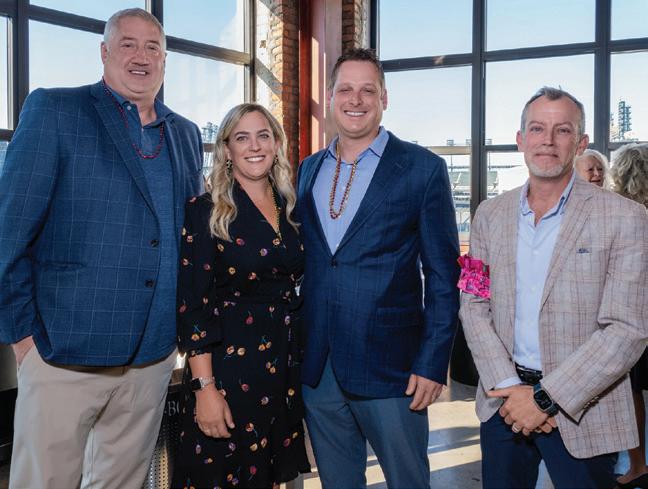


PATRICK GLORIA
The American Speed Festival at M1 Concourse in Pontiac held its fourth annual Checkered Flag Ball on Oct. 5 at the M1 Events Center. The guest of honor was this year’s Master of Motorsports honoree, the King of NASCAR, Richard Petty. The theme of the evening was Bootleggers Bash, a nod to the early days of stock car racing. The event benefited the Pontiac Community Foundation, which provides transportation solutions that connect Pontiac residents with community services and programs.
11. Adam and Nicole Wirik, Leslie and John Conway
12. Colby Cunningham, Emily Sante, Jeanne Zlotoff, Delainie Wheeler
13. David and Laura Gutierrez
14. Melanie Brown, Dr. Samino and Trina Scott
15. Paul Zlotoff, Richard Petty, Terese Zlotoff




PATRICK GLORIA
Corewell Health Foundation Southeast hosted its Red Tie Ball on Oct. 4 at The Henry in Dearborn. The event, chaired by Patrick A. Rugiero, benefits the Center for Exceptional Families and the development of Corewell Health Dearborn Hospital’s pediatric emergency center. Guests enjoyed a cocktail reception, dinner and dancing to The Ben Sharkey Band, and a live auction. Sponsors included Karen and Patrick Smithbauer; Drs. Harris, Birkhill, Wang, Songe, and Associates; and the Toni A. Wisne Foundation.
6. Dr. Nobin Kotukkapaly, Dr. Halima Ali, Dr. Paras Khandhar
7. Jae Vitale Plawecki, Sandy Ford, Colleen and Patrick Grace
8. Dr. Sylvia Hayek, Dr. Joseph Chattahi
9. Kelli Sadler, Leon Johnson
10. Madelyn Wisne, Jessica Weiss





























































Where excellence and elegance combine
Workingprofessionals afflicted with alcohol and substance use disorders face unique challenges when striving to achieve long-lasting sobriety.
Liberty House Recovery Center goes above and beyond to face these challenges while providing a safe, supportive, and confidential atmosphere for healing.
Liberty House Recovery Center, a fully licensed detox and residential treatment facility, is proudly celebrating three years of providing the highest standards of care for those with substance use and co-occurring disorders here in Michigan communities and beyond. The team includes the expertise of doctors, therapists, counselors, nurses, coaches, and case managers who work together to provide 24/7 care tailored to each individual’s specific needs. And this includes the needs of working professionals who want to prioritize their sobriety while still being able to meet their work and business obligations. Flexible electronics policies have allowed many working clients to continue monitoring their businesses while not interfering with or interrupting what’s most important: their treatment and road to long-lasting sobriety.
Liberty House Recovery Center stresses the importance of confidentiality for its clients and offers private and semiprivate rooms. Personal chefs, housekeeping staff, and drivers also are available to every client to lighten any burden and minimize distractions while one focuses on healing. Small group sizes aid in rapport building between peers and staff, as well as allow for increased individualized attention. All clients who stay for the full 30-day program leave with a comprehensive aftercare plan that takes into account the busy lifestyles of many working professionals seeking treatment.
Liberty House Recovery Center was created based on the passion of its founders for the betterment of alcohol and substance use treatment and helping those in need.
“Since the beginning, our vision has been to create an environment that provides world-class care here in Michigan so that loved ones seeking treatment no longer need

to travel across the country to get the care they deserve,” says Dr. Susan Abed, who created the facility dedicated to ensuring the highest level of care in all aspects of service and treatment.
“The journey of recovery has a different path for every person suffering from the disease, but the feeling of liberty and peace of freeing oneself from addiction to substances or unhealthy patterns of behavior is one of the greatest personal achievements any individual can attain,” Dr. Abed says.
A fulfilling life without the burdens of alcohol and substance use is possible and begins with Liberty House Recovery Center, where excellence and elegance combine to provide a comprehensive
and personalized path to recovery. For more information, call 866-686-0319 or visit libertyhouserecoverycenter.com. ■
Liberty House Recovery Center
13520 White Lake Road
Fenton, MI 48430
866-686-0319
libertyhouserecoverycenter.com
BARTON HILLS COUNTRY CLUB
730 Country Club Rd. Ann Arbor
734-663-8511
bartonhillscc.com
Members: 600 (est.)
Initiation fee: Social $15,000, Resident $40,000
Monthly fee: Social $361, Resident $811
Offerings: Signature Donald Ross golf course; tennis courts; fitness center; renovated dining room, wine bar, and resort-style pool complex with an outdoor pavilion.
BAYVIEW YACHT CLUB
100 Clairpointe St. Detroit
313-822-1853
byc.com
Members: 700
Initiation fee: Active $2,500
Monthly fee: $220, $150 quarterly club fee
Offerings: Indoor and outdoor dining, banquet space, marina, sailing lessons and races, regattas, and cruising activities.
BIRMINGHAM ATHLETIC CLUB
4033 W. Maple Rd. Bloomfield Township
248-646-5050
bacmi.net
Members: 600
Initiation fee: $25,000; $5,000 nonrefundable wait list fee, if join pay remaining $20,000
Monthly fee: $681
Offerings: Indoor and outdoor dining, two pools, tennis, squash, paddle tennis, pickleball, fitness center.
BIRMINGHAM COUNTRY CLUB
1750 Saxon Dr. Birmingham 248-644-4111
bhamcc.com
Members: 624
Initiation fee: Social $20,000, Corporate $60,000
Monthly fee: Social $745, Corporate $1,085
Offerings: Golf course, pool, tennis, fitness facilities, indoor and outdoor dining, pickleball, banquet space.
BLOOMFIELD HILLS COUNTRY CLUB
350 W. Long Lake Rd. Bloomfield Hills 248-644-6262 bloomfieldhillscc.org
Members: Limited, must be nominated by member.
Initiation fee: $75,000
Monthly fee: $1,275
Offerings: Golf course, dining facilities.
BLOOMFIELD OPEN HUNT
405 E. Long Lake Rd. Bloomfield Hills 248-644-9411
bohclub.com
Members: 250
Initiation fee: Social $7,500, Stockholding $15,900
Monthly fee: $511
Offerings: Dining room, swimming pool, fitness studio and yoga center, indoor and outdoor tennis, platform tennis, stables, indoor and outdoor equestrian facilities, kids’ activity center.
COUNTRY CLUB OF DETROIT
220 Country Club Dr. Grosse Pointe Farms 313-881-8000
ccofd.com
Private club, keeps information private.
Members: 800+
Initiation fee: NA
Monthly fee: NA
Offerings: Golf course, cross-country skiing, clubhouse, indoor and outdoor dining, tennis, paddle tennis, pool, bowling, fitness center, children’s day camp, guest rooms, dog park.
DEARBORN COUNTRY CLUB
Only gives out information through members. 800 N. Military Dearborn 313-561-0800
dearborncountryclub.net
Members: 300
Initiation fee: NA
Monthly fee: NA
Offerings: Donald Ross golf course, swimming, fitness area, dining, banquet facilities, junior golf, swim team.
DETROIT ATHLETIC CLUB
241 Madison St. Detroit
313-963-9200
thedac.com
Members: 4,000
Initiation fee: Legacy $500, Resident 34 and older $10,000.
Monthly fee: Based on age 34+, Resident $542
Offerings: Fully restored Albert Kahn-designed clubhouse built in 1915, full-service athletic facilities, pool, restaurants, ballrooms, meeting rooms, guest rooms, newly renovated bowling alley, salon, pavilion, named No. 1 athletic club in the country from 2018-2023.
DETROIT GOLF CLUB
17911 Hamilton Rd. Detroit 313-345-4400 detroitgolfclub.org
Members: 800
Initiation fee: Available upon membership inquiry
Monthly fee: Available upon membership inquiry
Offerings: Two 18-hole golf courses, clubhouse, three dining venues, swimming pool, swim team, tennis courts, fitness center, weddings, private events.
DETROIT YACHT CLUB
One Riverbank Rd., Belle Isle Detroit
313-824-1200 dyc.com
Members: More than 800; less than half are boating members
Initiation fee: Active members
$1,500, Boating active members
$3,000
Monthly fee: Active members
$434, Boating active members
$474
Offerings: Restaurant and bar, outdoor and indoor pools, swim team, adult and junior sailing, kayaking, tennis courts, social activities, weddings, events, more than 300 boat slips for boating members.
EDGEWOOD COUNTRY CLUB
8399 Commerce Rd. Commerce Township 248-363-7112
edgewoodcountryclub.org
Members: 450
Initiation fee: Class A $17,800, Social $3,000
Monthly fee: Class A $925, Social $390.80
Offerings: Golf course, casual and fine dining, outdoor pool, fitness center, massage therapist, event space.

FRANKLIN HILLS COUNTRY CLUB
31675 Inkster Rd. Franklin 248-851-2200 franklinhills.com
Members: 500, new members must be nominated by five members, with one acting as lead
Initiation fee: NA
Monthly fee: NA
Offerings: Albert Kahn-designed clubhouse, Donald Ross golf course, tennis, swimming, banquet space, dining room.
GROSSE ILE GOLF AND COUNTRY Club
9339 Bellevue Grosse Ile 734-676-1166 gigcc.com
Members: 530
Initiation fee: Starts as low as $1,000, depending on type of membership and age; golfing initiation fee $6,000
Monthly fee: Starts social as low as $177, depending on type of membership and age
Offerings: Donald Ross golf course; two full-service dining rooms; swimming pool; GIGCC swim team; clay and hard surface tennis courts featuring adult and youth leagues, individual instruction, and professional tennis staff; social events year-round for all ages.
GROSSE POINTE YACHT CLUB
788 Lake Shore Rd. Grosse Pointe Shores 313-884-2500
gpyc.org
Members: 800
Initiation fee: Active (boating)
$15,000, social $9,500
Monthly fee: Active (boating) $703, social $570
Offerings: Named a Platinum Club of the World; three dining rooms with views of Lake St. Clair; ballroom and main dining room with Italian architecture perfect for weddings, special occasions, or corporate events; fitness center; Olympic-size pool, bowling recreation center, and family activity center; 2,440-square-foot Marine Activity Center with sailing, watersports, and boat rentals.
INDIANWOOD GOLF AND COUNTRY CLUB
1081 Indianwood Rd. Lake Orion
248-693-2598
iwgcc.com
Members: 500+
Initiation fee: Class A Membership NA, Class B Membership $3,500, Family Fitness Membership $1,500, Social/Pool Family Membership
$899
Monthly fee: Class A Membership NA, Class B Membership $130, Family Fitness Membership $130, Social/Pool Family Membership
$130
Offerings: 18-hole New and Old
golf courses, driving range, Junior Golf Program for children, clubhouse, dining areas including Pipers Pub and Men’s Grill, health club, variety of club and social events.
KNOLLWOOD COUNTRY CLUB
5050 West Maple Rd. West Bloomfield Township
248-855-1800
knollwoodcountryclub.net
Members: 245
Initiation fee: Golf $30,000, Social $15,000
Monthly fee: Golf $1,700, Social $900
Offerings: Golf course; four Har-Tru clay tennis courts; aquatics facility with locker rooms, snack bar, and outdoor dining; 55,000-square-foot clubhouse; fitness center; pickleball; golf simulator studio; banquet space for 400 people; Troon Privé – Private Clubs of Distinction; member golfing privileges at Troon-managed clubs, resorts, and courses worldwide.
LOCHMOOR CLUB
1018 Sunningdale Dr. Grosse Pointe Woods 313- 885-6966
lochmoorclub.com
Members: Approximately 700 Initiation fee: NA
Monthly fee: NA
Offerings: Golf course; men and women’s golf leagues; creative pop-up dining events and seasonal menus; summer patio bar and outdoor dining; wine club that features wine tastings/ dinners; swim team for children; tennis programs; junior sports such as golf and tennis; Lochmoor Athletic Center with year-round golf training; four Trackman simulators; 1,000-square-foot indoor golf practice area with chipping, putting green, and sand bunker; fitness center; two tennis courts; bar; food service.
M1 CONCOURSE
1 Concourse Dr. Pontiac
248-326-9999
m1concourse.com
Members: 210
Initiation fee: NA
Monthly fee: NA
Offerings: Cost information reserved for members who own a garage at the track. Seven hours of track time per week; use of M1 Fleet Vehicles such as Dodge Hellcats and Lexus Performance Coupes; instruction provided by high-level driving instructors, including notable racers such as Johnny O’Connell; autocross competitions; guest events for friends/family of members to drive; exclusive social events.
MEADOWBROOK COUNTRY CLUB
40941 W. Eight Mile Rd. Northville Township
248-349-3600
meadowbrookcountryclub.com
Members: 698 (there is a two-year waiting list)
Initiation fee: Social $12,500, Golf $65,000
Monthly fees: Social $480, quarterly food and beverage $600, golf $710, monthly capital $250
Offerings: Golf course; 25-meter pool, lap pool, and wading pool; fountain and wading pool for little ones; private tennis programs led by Wayne Jackson; tennis events, lessons, and tournaments; indoor and outdoor dining options.
OAKHURST GOLF AND COUNTRY CLUB
7000 Oakhurst Lane
Clarkston
248-391-3300
clubcorp.com
Members: NA
Initiation fee: NA
Monthly fee: NA
Offerings: Golf course, six tennis courts with USPTA pro available for clinics or private lessons, executive chef, cabana bar, junior Olympic-size resort-style pool, 1,600-square-foot fitness center, variety of social functions.
OAKLAND HILLS COUNTRY CLUB
3951 West Maple Rd. Bloomfield Township
248-644-2500
oaklandhillscc.com
Members: 500
Initiation fee: NA
Monthly fee: NA
Offerings: South and North 18-hole golf courses, tennis, swimming. Using temporary facilities while new clubhouse is under construction.
ORCHARD LAKE COUNTRY CLUB
5000 West Shore Dr.
Orchard Lake Village
248-682-0100
orchardlakecountryclub.com
Members: 655
Initiation fee: Full Golf
$55,000, Social $20,000
Monthly fee: Golf $985 plus capital dues of $200, Social $690 plus $140
Offerings: Golf course and driving range; six-tiered clay tennis courts and four platform tennis courts; seasonal menus prepared by award-winning chefs; lakefront dining; ballroom for wedding celebrations; racquet classes, competitions, and tournament training for all ages; personal
training and group fitness programs; sailing clinics; swim lessons for children.
PAINT CREEK COUNTRY CLUB
2375 Stanton Rd. Lake Orion
248-693-4695
paintcreekgolf.com
Members: 70
Initiation fee: None
Annual fees: Pool and fitness
$1,100, Corporate membership
$3,900, Family membership
$3,700
Offerings: Golf course, fitness center, pool, 20,000-squarefoot clubhouse, 300-seat dining room.
PINE LAKE COUNTRY CLUB
3300 Pine Lake Rd. Orchard Lake 248-682-1300
pinelakecc.com
Members: 550
Initiation fee: Social $20,000, Stock membership $45,000
Monthly fee: Social $886, Stock $1,270
Offerings: Golf course, indoor and outdoor tennis courts, Olympic-size pool, fitness center, clubhouse, dining room, grill. Waiting list for boat slips for stock members.












PLUM HOLLOW COUNTRY CLUB
21631 Lahser Rd. Southfield 248-357-5353
plumhollowcc.com
Members: 400
Initiation fee: Stock $20,000, Social $1,500
Monthly fee: Varies based on membership category
Offerings: Golf course, caddie program, three Har-Tru clay tennis courts, Olympic-size pool, swim teams, casual and fine dining options.
POLO FIELDS GOLF AND COUNTRY CLUB
5200 Polo Fields Dr. Ann Arbor 734-998-1555
polofieldsccmi.com
Members: NA
Initiation fee: Full golf family
$7,300, Single golf $4,800, Non-resident social $1,000, Dining only $100
Monthly fee: Full golf gamily
$640, Single golf $420, Non-residential social $90, Dining only $150 quarterly
Offerings: Golf course, clubhouse, indoor and outdoor dining, pool, lounge area, fully equipped fitness center, snack bar, patio, golf simulator, year-round events.
RED RUN COUNTRY CLUB
2036 Rochester Rd. Royal Oak 248-548-7500
redrungolfclub.com
Members: 690 families
Initiation fee: Social $35,000, Stock $7,500
Monthly fee: Social $350, Stock $720
Offerings: Golf course, Olympic-size pool, indoor and outdoor tennis courts, fitness center, indoor golf practice area, bowling leagues, casual and formal dining.
SHENANDOAH COUNTRY CLUB
5600 Walnut Lake Rd. West Bloomfield Township 248-683-6363
shenandoahcc.net
Members: 1,800; membership restricted to Chaldeans or the spouses of Chaldeans
Initiation fee: $25,000
Monthly fee: Annual fee $2,500
Offerings: Golf course (open to public); clubhouse; dining; partitionable 11,336-square-foot banquet room; two pre-function areas; 4,000-square-foot outdoor terrace, pool, and splash pad; fitness center
TAM-O-SHANTER COUNTRY CLUB
5051 Orchard Lake Rd. West Bloomfield Township 248-855-1900, ext. 408 tamoshantercc.org
Members: 350
Initiation fee: $20,000
Monthly fee: $1,000
Offerings: Golf course, clubhouse, dining, four hydro-clay and two hard-surface tennis courts, Olympic-size heated pool, fitness center, banquet facilities, youth programs, pickleball.
WABEEK CLUB
4000 Clubgate Dr. Bloomfield Township 248-855-0700
wabeekcc.com
Members: 400
Initiation fee: Social $4,000, Golf $12,500
Monthly fee: Social $325, Golf $795
Offerings: Golf course designed by Jack Nicklaus and Pete Dye; clubhouse; formal and casual dining; pool; tennis; fitness center; spa; banquet and private event space; kids room; TrackMan golf simulators; sport court for basketball, volleyball, and youth tennis configurations.
WESTERN GOLF AND COUNTRY CLUB
14600 Kinloch Redford Township
313-531-1240
westerngcc.com
Members: 400
Initiation fee: Full membership
$21,000, Anyone 21-38 $10,500, Athletic social $5,250
Monthly fee: $250
Offerings: Donald Ross golf course, year-round events, four dining rooms, swimming pool, tennis, pickleball, snack bars, Kid Kamp, golf simulators, junior programs, and a brand-new clubhouse that opened in 2021.
WYNDGATE COUNTRY CLUB
1975 W. Gunn Rd. Rochester Hills 248-652-4283
thewyndgate.com
Members: NA
Initiation fee: NA
Monthly fee: NA
Offerings: Two 18-hole golf courses, clubhouse, gardens, banquet and event facilities, junior golf program, golf lessons, club fitting, club repair, Olympic-size pool, splash pad, 3-foot-deep transitional pool, swim team.
Source: DBusiness research
ONE CAMPUS MARTIUS
1 Campus Martius, Detroit
Total Sq. Ft.: 1,370,000
Avail. Sq. Ft.: NA
Office Rent Avg.: NA
Owner/Broker: Bedrock
Contact: LeasingInquiry@ bedrockdetroit.com
PENOBSCOT BUILDING
645 Griswold St., Detroit
Total Sq. Ft.: 1.2 million
Avail. Sq. Ft.: Less than 300,000
Office Rent Avg.: $25
Owner/Broker: Triple Properties
Detroit
Contact: Alex Loewy, 313-961-8800
ALLY DETROIT CENTER
500 Woodward Ave., Detroit
Total Sq. Ft.: 1 million
Avail. Sq. Ft.: NA
Office Rent Avg.: NA
Owner/Broker: Bedrock
Contact: LeasingInquiry@ bedrockdetroit.com, 888-300-9833
DOMINO’S FARM OFFICE PARK
24 Frank Lloyd Wright Dr., Ann Arbor
Total Sq. Ft.: 920,000
Avail. Sq. Ft.: 55,717
Office Rent Avg.: $34-36
Owner/Broker: Domino’s Farms
Office Park
Contact: Margaret Parkinson, 734-930-4425
FIRST NATIONAL BUILDING
660 Woodward Ave., Detroit
Total Sq. Ft.: 830,000
Avail. Sq. Ft.: NA
Office Rent Avg.: NA
Owner/Broker: Bedrock
Contact: LeasingInquiry@ bedrockdetroit.com, 888-300-9833
COREWELL HEALTH CENTER (FORMERLY FIRST CENTER OFFICE PLAZA)
26901 Beaumont Blvd., Southfield
Total Sq. Ft.: 680,000
Avail. Sq. Ft.: 0
Office Rent Avg.: NA
Owner/Broker: Corewell Health Contact: NA
THE FISHER BUILDING
3011 W. Grand Blvd., Detroit
Total Sq. Ft.: 634,819
Avail. Sq. Ft.: 66,841
Office Rent Avg.: $24
Owner/Broker: JLL
Contact: AJ Weiner, 248-581-3335
DETROIT EXECUTIVE PLAZA
1200 Sixth St., Detroit
Total Sq. Ft.: 612,890
Avail. Sq. Ft.: Vacant
Office Rent Avg.: NA
Owner/Broker: Detroit Executive
We are thrilled to announce that we have been ranked #1 in Member Satisfaction Among Commercial Health Plans in Michigan and swept all eight dimensions in the 2024 J.D. Power Study. This is a testament to our unwavering commitment to our members and the communities we serve.
Plaza
Contact: Derrick Danou, 313-962-9595
SOUTHFIELD TOWN CENTER
– 1000 TOWN CENTER
1000 Town Center, Southfield
Total Sq. Ft.: 597,346
Avail. Sq. Ft.: 183,000
Office Rent Avg.: $22-24 + electric
Owner/Broker: Transwestern Management
Contact: Clarence Gleeson, 248-440-1411; Patrick Schlenke, 248-440-1448
PNC CENTER
755 W. Big Beaver Rd., Troy
Total Sq. Ft.: 597,000
Avail. Sq. Ft.: 119,839
Office Rent Avg.: Floor 1-13, 21.50; Floor 14 and above, $24,50
Owner/Broker: Friedman Real Estate
Contact: Steve Eisenshtadt, 248-848-3535
RENCEN – TOWER 200
200 Renaissance Center, Detroit Total Sq. Ft.: 593,480 Avail. Sq. Ft.: 277,000 Office Rent Avg.: $25.50 Owner/Broker: CBRE Contact: Jasper Hanifi, 248-351-2020
RENCEN – TOWER 100
100 Renaissance Center, Detroit Total Sq. Ft.: 587,973 Avail. Sq. Ft.: 88,000 Office Rent Avg.: $25.50 Owner/Broker: CBRE Contact: Jasper Hanifi, 248-351-2020
SOUTHFIELD TOWN CENTER – 3000 TOWN CENTER
3000 Town Center, Southfield Total Sq. Ft.: 586,038 Avail. Sq. Ft.: 35,600 Office Rent Avg.: $22-24 + electric
Owner/Broker: Transwestern Management Contact: Clarence Gleeson, 248-440-1411; Patrick Schlenke, 248-440-1448
RENCEN – TOWER 300
300 Renaissance Center, Detroit Total Sq. Ft.: 584,531
We’re ready to help serve our members. bcbsm.com/employers






#1 in Member Satisfaction Among Commercial Health Plans in Michigan
Avail. Sq. Ft.: 0
Office Rent Avg.: $25.50
Owner/Broker: CBRE
Contact: Jasper Hanifi, 248-351-2020
RENCEN – TOWER 400
400 Renaissance Center, Detroit
Total Sq. Ft.: 576,449
Avail. Sq. Ft.: 55,000 Office Rent Avg.: $25.50
Owner/Broker: CBRE
Contact: Jasper Hanifi, 248-351-2020
SOUTHFIELD TOWN CENTER
– 2000 TOWN CENTER
2000 Town Center, Southfield
Total Sq. Ft.: 556,014
Avail. Sq. Ft.: 101,600
Office Rent Avg.: $22-24 + electric
Owner/Broker: Transwestern Management
Contact: Clarence Gleeson, 248-440-1411; Patrick Schlenke, 248-440-1448
444 MICHIGAN AVE.
444 Michigan Ave., Detroit
Total Sq. Ft.: 551,453
Avail. Sq. Ft.: 402,538 Office Rent Avg.: NA
Owner/Broker: Reign CO1 Propco Contact: NA
MASONIC TEMPLE
434-500 Temple St., Detroit
Total Sq. Ft.: 550,000
Avail. Sq. Ft.: NA
Office Rent Avg.: NA
Owner/Broker: Masonic Temple Association Contact: Ryan Groat, 313-832-7100
THE QUBE (CHASE)
611 Woodward Ave., Detroit
Total Sq. Ft.: 530,000
Avail. Sq. Ft.: NA Office Rent Avg.: NA
Owner/Broker: Bedrock Contact: LeasingInquiry@ bedrockdetroit.com, 888-300-9833
AMERICAN CENTER
27777 Franklin Rd., Southfield
Total Sq. Ft.: 512,374
Avail. Sq. Ft.: 97,878
Office Rent Avg.: $19.95 gross
Owner/Broker: REDICO Contact: 248-827-1700
NEW CENTER ONE BUILDING
3031 W. Grand Blvd., Detroit
Total Sq. Ft.: 510,000
Avail. Sq. Ft.: Approximately 100,000
Office Rent Avg.: NA
Owner/Broker: NAI Farbman
Group Contact: Andy Gutman
150 W JEFFERSON
150 W Jefferson, Detroit
Total Sq. Ft.: 489,786
Avail. Sq. Ft.: 64,061
Office Rent Avg.: $28.50 Gross
Owner/Broker: REDICO
Contact: NA
300 RIVER PLACE
300 River Place, Detroit
Total Sq. Ft.: 455,000
Avail. Sq. Ft.: NA
Office Rent Avg.: NA
Owner/Broker: Bedrock
Contact: LeasingInquiry@ bedrockdetroit.com, 888-300-9833
ONE TOWN SQUARE
1 Towne Square, Southfield
Total Sq. Ft.: 427,013
Avail. Sq. Ft.: 65,611
Office Rent Avg.: $14.50
Owner/Broker: REDICO Contact: NA
SOUTHFIELD TOWN CENTER –
4000 Town Center
4000 Town Center, Southfield
Total Sq. Ft.: 383,005
Avail. Sq. Ft.: 65,653
Office Rent Avg.: $22-24 + electric
Owner/Broker: Transwestern
Management
Contact: Clarence Gleeson, 248-440-1411; Patrick Schlenke, 248-440-1448
Source: DBusiness research
1.
100 Michigan Ave. NE Grand Rapids
866-989-7999
26901 Beaumont Blvd.
Southfield
248-898-500
corewellhealth.org
President/CEO: Tina Freese Decker
2023 Revenue: $15.1B
2022 Revenue: $14.7B
2024 Employees: 67,759
Operations: Corewell Health
Beaumont Troy Hospital (Beaumont Hospital Troy); Corewell Health Beaumont Grosse Pointe Hospital (Beaumont Hospital Grosse Pointe); Corewell Health Dearborn Hospital (Beaumont Hospital Dearborn); Corewell Health Farmington Hills Hospital (Beaumont Hospital Farmington Hills); Corewell Health Taylor Hospital (Beaumont Hospital Taylor); Corewell Health Trenton Hospital (Beaumont Hospital Trenton); Corewell Health Wayne Hospital (Beaumont Hospital Wayne); Corewell Health William Beaumont University Hospital (Beaumont Hospital Royal Oak)
2. UNIVERSITY OF MICHIGAN HEALTH
1500 E. Medical Center Dr. Ann Arbor
734-936-4000 uofmhealth.org
Executive Vice President for Medical Affairs University of Michigan, Dean, U-M Medical School; CEO, Michigan Medicine: Dr. Marschall S. Runge
2023 Revenue: $7.9B (July 2023 to June 30, 2024)
2022 Revenue: $5.5B
2024 Employees: 47,000
Operations: University Hospital; C.S. Mott Children’s Hospital; Von Voightlander Women’s Hospital; Frankel Cardiovascular Center; Rogel Cancer Center; Kellogg Eye Center
3. HENRY FORD HEALTH
1 Ford Place Detroit
800-436-7936
henryford.com
President/CEO: Bob Riney
2023 Revenue: $4.95B
2022 Revenue: $4.2B
2024 Employees: 50,693 (Merged with Ascension Michigan on Oct. 1, 2024)
Operations: Henry Ford Hospital; Henry Ford Allegiance Health; Henry Ford Macomb Hospital –Clinton Township; Henry Ford West Bloomfield Hospital; Henry Ford Wyandotte Hospital; Henry Ford Kingswood Hospital
4. ASCENSION MICHIGAN 28000 Dequindre Rd. Warren 586-753-0911
President/CEO/Interim Ministry
Market Executive, Ascension Michigan: Carol Schmidt
2023 Revenue: $4.51B
2022 Revenue: $4.5B
2024 Employees: 50,693 (Merged with Henry Ford Health on Oct. 1, 2024)
Operations: Sixteen hospitals and hundreds of related health care facilities including Ascension Borgess Hospital; Ascension Borgess – Allegan Hospital; Ascension Borgess – Lee Hospital;

Ascension Borgess – Pipp Hospital; Ascension Brighton Center for Recovery; Ascension Genesys Hospital; Ascension Macomb-Oakland Hospital (Madison Heights Campus and Warren Campus); Ascension Providence Hospital (Novi Campus and Southfield Campus); Ascension Providence Rochester Hospital; Ascension River District Hospital; Ascension St. John Hospital; Ascension St. Joseph Hospital; Ascension St. Mary’s Hospital; Ascension Standish Hospital
5. TRINITY HEALTH MICHIGAN
1600 S. Canton Center Rd., Ste. 310 Canton Township 844-237-3627 stjoeshealth.org; mercyhealth.com
CEO: Rob Casalou
2023 Revenue: $4.34B
2022 Revenue: $4.16B
2024 Employees: 25,681
Operations: St. Joseph Mercy Ann Arbor; St. Joseph Mercy Chelsea; St. Joseph Mercy Livingston; St. Joseph Mercy Oakland; St. Mary Mercy Livonia; Mercy Health Muskegon; Mercy Health Grand Rapids; Mercy Health Lakeshore Campus
6. MCLAREN HEALTH CARE
One McLaren Parkway Grand Blanc 810-342-1100 mclaren.org
President/CEO: Philip Incarnati 2023 Revenue: NA 2022 Revenue: $3.8B 2024 Employees: 19,039
Operations: McLaren Bay Region; McLaren Caro Region; McLaren Central Michigan; McLaren Flint; McLaren Greater Lansing; McLaren Lapeer Region; McLaren Macomb; McLaren Northern Michigan; McLaren Oakland; McLaren Port Huron; McLaren Thumb Region; Karmanos Cancer Institute
7. BRONSON HEALTHCARE 301 John St. Kalamazoo 269-341-6000 bronsonhealth.com
President/CEO: Bill Manns
2023 Revenue: $1.76 billion
2022 Revenue: $1.62B
2024 Employees: 9,389
Operations: Bronson Methodist Hospital; Bronson Battle Creek Hospital; Bronson LakeView Hospital; Bronson South Haven
Hospital; Bronson Medical Group; Bronson at Home; Bronson Commons; Bronson Athletic Club; Bronson Wellness Center; Bronson Health Foundation
8. MYMICHIGAN HEALTH 4000 Wellness Dr. Midland 989-839-3000 mydmichigan.org
President/CEO: Dr. Lydia Watson 2023 Revenue: $1.33B
2022 Revenue: $1.2B
2024 Employees: 6,032
Operations: MyMichigan Medical Center Alma; MyMichigan Medical Center Alpena; MyMichigan Medical Center Clare; MyMichigan Medical Center Gladwin; MyMichigan Medical Center Midland; MyMichigan Medical Center Mount Pleasant; MyMichigan Medical Center Sault; MyMichigan Medical Center West Branch; Mackinac Straits Hospital, Health System; Mackinac Island Medical Center (not affiliated with University of Michigan Health)
9. SPARROW HEALTH SYSTEM 1215 E. Michigan Ave. Lansing 517-364-1000 sparrow.org
President/CEO: James Dover 2023 Revenue: $1.27B (Fiscal year ended 06/30/23)
2022 Revenue: $1.5B
2024 Employees: 9,070 Operations: Sparrow Hospital; Sparrow Hospital St. Lawrence; Sparrow Carson Hospital; Sparrow Clinton Hospital; Sparrow Eaton Hospital; Sparrow Ionia Hospital; Sparrow Specialty Hospital
10. DETROIT MEDICAL CENTER 3990 John R St. Detroit 313-745-1250 dmc.org
President/CEO: Audrey Gregory 2023 Revenue: $1B (est.)
2022 Revenue: $1B (est.)
2024 Employees: 6,467
Operations: DMC
Source: DBusiness research
Dr. Ellen Janetzke’s personalized approach, designed to ensure that her patients achieve the best possible outcome, has been the foundation and cornerstone of her award-winning and highly respected practice for over two decades. Her amazing team at Dr. Ellen Plastic and Reconstructive Surgery in Bloomfield Hills continues to do what they do best — change and improve lives.
Her successful and highly respected practice was built around her ability to understand, anticipate, and fulfill patient expectations, honestly and realistically.
“When considering plastic surgery, it is essential to be comfortable with your surgeon and staff, to feel fully educated, and to have your goals completely understood,” Dr. Ellen says. “During your consultation, we will create an individualized plan to ensure that you receive the best achievable outcome. Our mission is to gain our patients’ trust and guide them through every step, starting with their very first phone call.”
Dr. Ellen, who has committed herself to patient education, safety, and service, has years of experience in performing highquality cosmetic surgery, and her unique approach is tailored to meet each patient’s individual cosmetic goals. She has not only created a successful business but has built a reputation as both a gifted surgeon and a caring doctor.
“It’s always a special feeling when I hear from a patient that I helped change their life, and it’s why I do what I do,” she says. “I remember a patient we did a facelift on. When I showed her the pre-op pictures compared to what she looked like just a few weeks after surgery, she started to cry. And, of course, it made me cry those same tears of joy.”
Dr. Ellen Plastic and Reconstructive Surgery specializes in many different procedures for women, including mommy makeovers that focus on breast augmentations, lifts, and reductions in addition to tummy tucks and liposuction.
Procedures for the face include eyelid lifts, neck lifts, and facelifts.

Many of her patients include men who undergo gynecomastia surgery, or male breast reduction surgery, a procedure that aims to correct enlarged male breasts, often called “man boobs.”
“We can do most of these procedures with liposuction, and therefore it only requires a tiny incision,” Dr. Ellen says. “If we do need to remove some of the glandular tissue that liposuction can’t remove, it still only leaves a very small mark.”
Dr. Ellen holds both herself and her team to very high standards.
“The staff here are handpicked based on their professionalism, level of compassion, overall intelligence, and knowledge of our
industry,” Dr. Ellen says. “They are specifically trained for their position and acclimated to our practice culture and our professional expectations. I have an excellent team who shine in their positions and are favorites of our patients, some of whom have been here for as long as I have been in practice.” ■
Dr. Ellen Plastic and Reconstructive Surgery
60 W. Big Beaver Road, Suite 100 Bloomfield Hills, MI 48304
248-220-6760
drellen.com
info@drellen.com

For decades, a clock with three faces and 3-foot-long wooden hands adorned Kern’s department store and served as a downtown meeting spot.
BY RONALD AHRENS
Before the stroke of 9 p.m., a few shoppers milled beneath Kern’s clock, the timepiece that served as a central meeting point in mid-century Detroit.
Atop the long ledge above the department store’s display windows, twinkling strands of lights enshrouded an evergreen forest. Surmounting the three-faced timepiece, the tallest Christmas tree of all adorned the department store’s fourth floor.
The clock dated from the Art Deco period, but the scene recorded in the poignant mid-1950s photo (above) was taken shortly before the end of its line.
Ernst Kern Dry Good Co. opened in 1883 and the founder, his wife, Marie, and then their sons and grandsons minded the store until Buffalo-based Sattler’s Inc. acquired Ernst Kern Co. in 1957. At Christmastime two years later, the store closed for good.
Ernst Kern was a German immigrant with a knack for retailing. His first dry-goods store was on St. Antoine Street. It burned down in 1886, fueled by its stock of imported fabrics and laces, but later reopened at Randolph and Monroe streets.
Four years passed before the company acquired a five-story building on the bustling southeast corner of Woodward and Gratiot avenues. The choice location boasted a provenance as the former site of the Finney House, a lodging establishment kept by Seymour Finney, whose nearby stables in what is now Capitol Park did service as an Underground Railroad waypoint.
A subsequent addition incorporated the ninestory Weber Building into the Kerns emporium, but this proved inadequate. In 1927, Kern’s announced a project to raze the smaller building and double the size of the complex.
Shoppers and residents alike often met under the clock at the former Kern’s department store in downtown Detroit. Today, the refurbished clock sits on a pedestal at the southeast corner of Woodward and Gratiot avenues, directly in front of Adelina Restaurant.
“When completed, the store will be one of the finest and most modern mercantile houses of the kind in the world,” a newspaper report promised. The expansion resulted in a multistory behemoth with 300 feet of Woodward frontage. For good measure, some 30,000 square feet of marble floors on the ground level complemented an ornamental ceiling.
A Christmas ad in 1928 presented a Roaring ’20s fashion trend by making a tendentious claim: “There’s a bit of coquette in every woman — and it’s sure to respond to a gift of one of these gorgeous silk shawls.” Depending on size, embroidery, and colors blended with metal threads, prices ranged from $8.95 to (gasp) $24.95.
Gifts, the ad suggested, could be frivolous or practical, but most important were those presents “the little tots will welcome with shrieks of delight when they come downstairs on Christmas morning.”
As one of Detroit’s Big Three department stores — along with J.L. Hudson Co. and Crowley, Milner and Co., which were clustered together in that area — Kern’s reflected paternalistic concerns for its 500 staff members.
“Every innovation known to mercantile building experts will be incorporated into the store,” the news report continued. “Particular care has been given to conveniences for employees.” Listed next were features including a large auditorium, a gymnasium, a roof garden, a dining room, and a library. A bank of 21 elevators served the upper floors.
The streetside display windows educated and informed with exhibits that anticipated “the needs of a rapidly growing metropolis.” One was a mock-up of the Ford airport in Dearborn (today a Ford test track), then a new marvel. The replica included models of the latest airplanes, hangars, and masts for mooring airships. It was said to be “prophetic of Detroit as the air center of the globe.”
Despite such progressive retailing, Kern’s became passé by the 1950s as the suburbs expanded. After the store closed at Christmas of 1959, the building sat empty until being demolished in 1966.
A worker used a cutting torch to bring down the revered clock, while city councilman Ed Connor asked a reporter, “Where are people going to meet for their dates now?” The three faces were stuck at 8:02, 3:15, and 3:55.
Today, the clock keeps perfect time on a pedestal at its original location, which is now occupied by Rocket Cos. at One Campus Martius.







